1 Introduction
“When Mexico sends its people, they’re not sending their best. […] They’re sending people that have lots of problems, and they’re bringing those problems with us. They’re bringing drugs. They’re bringing crime. They’re rapists. And some, I assume, are good people.” —Donald Trump, June 20151“‘They’re rapists.’ President Trump’s campaign launch speech two years later, annotated.” Washington Post, June 16, 2017, available at https://www.washingtonpost.com/news/thefix/wp/2017/06/16/theyre-rapists-presidents-trump-campaign-launch-speech-two-years-later-annotated/.
During the 2016 presidential election, Donald Trump made it clear that migration was going to be one of the core topics in his political agenda (Eshbaugh-Soha, and Barnes, 2021). This notorious discourse of June 2015 was one of many attacks against foreigners that became common in the years to follow. In November of the same year, Trump tweeted “Refugees from Syria are now pouring into our great country. Who knows who they are—some could be ISIS. Is our president insane?”2Donald J. Trump (@realDonaldTrump), “Refugees from Syria are now pouring into our great country. Who knows who they are – some could be ISIS. Is our president insane?”, Twitter, 17 November, 2015, 4:54pm, https://twitter.com/realDonaldTrump/status/666615398574530560. According to Card et al. (2022), such statements are part of a larger trend of Republicans using metaphorical and dehumanizing language toward immigrants in recent decades. At the time of his speech, Democratic leaders fiercely opposed this narrative, highlighting the polarized nature of immigration discussions in American politics.
In this paper, however, we demonstrate that the lines dividing politicians and their parties are much more blurred than those that separate countries and impose restrictions on freedom of movement. By using computational text analysis, we collect, process, and examine all tweets published by US representatives during the 2020 primary and general elections. Our analysis uncovers two major findings that contribute to our understanding of the immigrant-refugee duality and intraparty differences in legislative strategic behavior.
First, we use computational sentiment analysis to confirm that Democratic and Republican legislators are divided when it comes to freedom of movement. We find that, unsurprisingly, Democrats tweet more often and more positively about immigrants when campaigning than their Republican colleagues. However, the caveat lies in the use of “refugee” as a discourse element. Our findings indicate that this categorization is used to legitimize immigrants’ right to come to and live in the United States (for a similar argument, see Onraet et al., 2019; Hamlin, 2021). For that reason, Democrats and Republicans are equally positive when tweeting about refugees.
Our second finding relates to intraparty differences in strategic behavior and issue salience. Our data analysis indicates that Republicans sustain the same rhetoric regardless of context. While they speak less often about immigration and are generally negative, they become positive when talking about refugees. However, Democratic legislators tend to speak out or go silent depending on the district they represent. While they are considerably more favorable toward immigrants than Republicans, they tweet less often about the topic as the proportion of non-Hispanic White voters in their districts increases. They also tend to talk less about immigrants as their districts become more rural.
Prior studies have examined this topic, yet our paper offers at least two contributions to this debate, one methodological and one of substance. Methodologically, much of the literature focuses on roll-call votes to assess party unity concerning immigration policy (Facchini, and Steinhardt, 2011; Rocca et al., 2022; Jaeger, 2019; Matos, 2017; Browne, Reingold, and Kronberg, 2018) and other issues (e.g., de Marchi, Dorsey, and Ensley, 2021; Hansen, 2022; Ansolabehere, Snyder Jr., and Stewart III, 2001). Similar to our findings, they show that legislative behavior is shaped by partisanship and other factors.
However, this approach to investigating party unity has several weaknesses. Constraints imposed by party leadership (Morgenstern, 2003) and the executive branch’s head (Zucco Jr., and Lauderdale, 2011; Michener, and Pereira, 2016) often limit legislators’ autonomy. Consequently, legislators may vote for a specific bill not necessarily because they agree with their colleagues but due to political bargaining. For that reason, some authors use legislative speeches to assess how much legislators actually agree with their colleagues (Proksch et al., 2019) or their own roll-call votes (Kalaf-Hughes, 2013).
There is also mixed evidence of whether voters know how their representatives are voting in Congress (cf. Ansolabehere, and Jones, 2010). Even if representatives go beyond roll-call votes by expressing their preferences through legislative speeches, voters may not have the time or the interest to become informed about legislative action. Furthermore, as we show in this paper, politicians may opt for strategically obfuscating their preferences from the public (Mainwaring, Meneguello, and Power, 2000; Zucco, and Power, 2024) and even their colleagues (Guedes-Neto, and Morgenstern, 2022), which further increases information costs.
Finally, as Ames (2002) shows, many bills, especially those that do not have intraparty unified support, are dismissed even before they reach the floor, thus biasing the samples used in the study of roll-call voting. Overall, topics investigated through roll-call votes will express more unity than policy issues in general. Ideally, scholars of party unity should compile datasets that go beyond the small number of bills publicly debated in Congress.
Twitter/X data addresses most of these issues. We rely on tweets posted during the 2020 US general election campaign, meaning that legislators are speaking about their preferences to broad audiences and with less partisan strings. While this compares to their legislative speeches (see Card et al., 2022), tweets (1) are targeted at their constituents rather than at congressional colleagues, (2) contain short and direct messages regarding the topic of interest, and (3) are produced in accessible language. They are therefore speaking directly to the public, thus providing political information at reasonably low costs for voters. Finally, they are not restricted by the serpentine procedures that inhibit policies from reaching the congressional floor, meaning that the range of possible issues is considerably broader than those included in roll-call datasets.
We collected all tweets posted by US representatives from January 1 up until Election Day on November 4, 2020, therefore including the primary and general elections. We then identified all the tweets containing keywords related to immigrants and refugees or asylum seekers, obtained a measure of the salience of these topics by legislator, and conducted computational analysis using different sentiment lexicons. Moreover, these sentiment measures are correlated with legislators’ votes on immigration bills, showing the validity of our sentiment scores. That is, tweets are more easily accessible to voters, include a wider range of topics than roll-call votes, and predict how legislators will behave in Congress when required to make public decisions.
Our additional contributions to the literature relate to the substance of immigration preferences and elite discourse. When it comes to sentiment, we find that, first, Democrats are overall positive toward both immigrants and refugees, whereas Republicans are overall negative toward immigrants and positive toward refugees. The existing literature shows that over the last decades, Democrats’ and Republicans’ polarization on this issue has grown (Card et al., 2022). However, we show that the same does not apply when the keyword is “refugee” rather than “immigrant.”
In terms of issue salience, we find that Democrats appear to be strategic in the extent they talk about immigrants and refugees based on their districts’ ethnic and urban composition, whereas Republicans’ salience does not vary conditional on their districts’ characteristics. Specifically, the more Hispanic and urban their districts, the more Democrats talk about immigrants and refugees. On the other hand, the more non-Hispanic White their districts, the less they talk about these topics. This relates to previous findings that Republicans are more unified on migration policy (Jeong et al., 2011; Kalaf-Hughes, 2013) than Democrats and district characteristics influence the relationship between legislators and their two masters, that is, constituents and the party (Cox, and McCubbins, 2007; Jaeger, 2019; Hansen, 2022).
The rest of the paper proceeds as follows. In Section 2, we introduce our theoretical assumptions on how Democratic and Republican legislative elites talk about immigrants and refugees and how sentiment can be used as a proxy for ideological preference. In Section 3, we present our theoretical expectations and contrasting hypotheses for the strategic manipulation of issue salience by Democratic and Republican legislators. In Section 4, we detail how the data were chosen and collected, and describe our empirical strategy. We present our main findings in Section 5 and a series of robustness checks in Section 6. Finally, in Section 7 we conclude with a discussion of the findings and avenues for future research.
2 Sentiment as Ideological Preference
Jeong et al. (2011) characterize immigration as a “wedge issue” for both Republicans and Democrats. Among Republicans, social conservatives tend to oppose population inflows due to cultural, ethnic, and racial changes, while pro-business politicians support immigration to supply labor market demands. Among Democrats, pro-labor leaders fear the replacement of American workers, while social liberals focus on the civil rights dimension of freedom of movement.
The authors further argue that while parties have been divided on this issue, the United States has gone through a process of ideological realignment, especially in the last three decades. First, since the 9/11 attacks, the social conservative branch of the Republican Party has gained more prominence and moved the party toward a more unified position against immigration. The right wing’s clearer stance on the issue made the topic less internally divisive. However, this led to an exodus of pro-business, socially liberal Republican voters to the Democratic Party as it “focused on increasing the rights and inflows of immigrants” (Jeong et al., 2011, p. 514).
Several studies support the realignment thesis. For example, Card et al. (2022) use computational text analysis to investigate US congressional and presidential speeches over the past 140 years. Their findings reveal a rise of positive attitudes toward immigrants in both parties in the 1940s and, since then, a continuous issue polarization, including the growing use of dehumanizing metaphors among Republicans when speaking of immigrants. Kalaf-Hughes (2013) focuses on more recent legislative speeches to confirm that the two parties became more polarized on migration policy between 1995–1996 and 2005–2006.
The rise of Donald Trump and his electoral success has solidified this trend (Eshbaugh-Soha, and Barnes, 2021). He was able to capture socially conservative voters with hawkish immigration views that were not represented by other candidates (Sides, Tesler, and Vavreck, 2018), activating these attitudes through an “enemies of the people” rhetoric (Löfflmann, 2022). Based on an analysis of over 1,733 tweets from 2011 to 2020, Merry (2022) shows that narratives centering on “villains” attracted substantively more attention on Twitter/X than those focusing on “heroes.” This public exposure and electoral success contributed to the Republican realignment that Jeong et al. (2011) identified in the aftermath of 9/11. This leads to our first assumption:
Assumption 1 Democratic legislators support immigrants more than Republican legislators.
For the public narrative, not all immigrants are the same. Consider, for instance, the migratory waves that followed the 1959 Cuban Revolution (Portes, and Armony, 2018). The first wave included the economic and political elites who the new regime expropriated and persecuted. They were welcomed by the US government, which opposed Cuba’s shift toward the Soviet alliance. Despite the many challenges and suffering that forced immigration imposed on them, these elite refugees benefited from a fast track toward asylum status and economic policies to help them settle (at least temporarily). The second wave (1980) did not enjoy the same benefits. The Marielitos, as they were nicknamed, were the over 100,000 workers fleeing Cuba’s poor economic and political conditions. Their reception was considerably less friendly than what happened in the late 1950s and early 1960s (Portes, and Armony, 2018).
These contexts led to different political trajectories. According to Bishin, and Klofstad (2012), pre-Mariel immigrants and their families are predominantly supportive of the Republican Party. Their ties to the prerevolutionary regime in Cuba and their economic socialization in the United States fed a positive relationship with the political right. Marielitos also lean right (compared to non-Cuban Hispanics) but are considerably less supportive of the Republican Party than pre-Mariel immigrants.
Politicians are aware that the causes behind immigration influence political preferences in the new country. They also know that in the long run, immigrants and their descendants may become voters. On average, Republicans suffer electoral losses as the number of naturalized migrants increases (Mayda, Peri, and Steingress, 2016). This is one of the reasons why Republicans support immigration restrictions the more their counties welcome foreign-born populations (Hawley, 2011).
The electoral consequences of immigration, however, are conditioned by the incomers’ ideological leaning. As happened in Florida, Republicans may enjoy gains if immigrants have reasons to reject Democratic politicians. This should be the case especially when they fled regimes controlled by the political left, as was the case of post-revolutionary Cuba and, more recently, Venezuela and Hong Kong. Donald Trump highlighted this in January 2021, stating, “The deteriorative condition within Venezuela, which presents an ongoing national security threat to the safety and well-being of the American people, warrants the deferral of the removal of Venezuelan nationals who are present in the United States.3“Memorandum on Deferred Enforced Departure for Certain Venezuelans.” White House, January 19, 2021, available at https://trumpwhitehouse.archives.gov/presidential-actions/memorandum-deferred-enforced-departure-certain-venezuelans/.
Elites also strategically choose their words and policies when discussing immigrants. Despite ideological preferences, politicians have incentives to welcome foreign-born populations that may increase their electoral basis in the future, while they reject those who pose a threat to political success. This incentive shapes how they will build a narrative around different border crossers.
Hamlin (2021, p. 2) explains that “‘the refugee’ has come to be viewed as an exception to the rule that states have a sovereign right to control their borders. . . . [They] have a privileged legal position compared to other crossers who also might need help but cannot access it.” Following this concept, politicians adopt the “refugee” label to grant a sense of deservingness to those whose migratory rights they support. In fact, this strategy is also used by the media. Brown, and Dromgold-Sermen (2022) find that US news shows use this label with sympathy but are mostly negative when referring to immigrants. We thus assume that while Democrats and Republicans diverge when talking about immigrants in general, they will be equally supportive of those who they label as refugees.
Assumption 2 Democratic and Republican legislators are equally supportive of refugees.
3 Salience as Strategic Behavior
“In the end, we will remember not the words of our enemies but the silence of our friends.” —Martin Luther King, Jr.4The Trumpet of Conscience, Steeler Lecture, November 1967.
Not all issues and policy positions will carry the same weight in electoral contests. Examining Europe over the 21st century, Dennison, and Kriesi (2023) show that unemployment, the environment, and immigration have shaped the discourse and the electoral outcomes of parties of all ideological families. The focus on issue salience, however, is not novel. In the 1960s, Stokes (1966) demonstrated how certain issues played a relevant role in vote choice, while others were widely ignored. At the time, political scientists were mostly concerned with how voters assessed the relevance of selected issues, especially in response to major events such as the Vietnam War, confrontations with Cuba, and Kennedy’s campaigns (RePass, 1971). The discussion on how to best measure issue salience (mainly through voters’ assessments) continued in the 1980s (Niemi, and Bartels, 1985), the 1990s (Edwards III, Mitchell, and Welch, 1995), and the 2000s (Epstein, and Segal, 2000).
Edwards III, Mitchell, and Welch (1995) and Epstein, and Segal (2000) offer a substantial change in the way issue salience was measured. Instead of relying on voters’ assessments (or in addition to it), they conducted a content analysis of media reports. Their studies intended to quantify the presence of each issue in public debate and, following the most present items, indicate their salience to the public. Epstein, and Segal (2000) focus on the salience of Supreme Court cases. Since the authors could not directly ask judges about their preferences and wanted to approach the study through an elite perspective, they relied on the New York Times’s front-page coverage of specific cases. They assumed that “both editors and justices make this calculation [of issue salience] at the same time, within the same political context” (Epstein, and Segal, 2000, p. 73).
This is not to say that future studies completely moved away from public opinion to assess issue salience—they did not (see, e.g., B´elanger, and Meguid, 2008). However, multiple scholars turned their attention to content analysis techniques to assess salience through the lenses of elites, including news media (see Nicholson-Crotty, 2009; Holian, 2006) and other political documents (see Netjes, and Binnema, 2007). More recently, computational text analysis and the spread of online political conversations allowed researchers to focus on Google searches (Scharkow, and Vogelgesang, 2011; Mellon, 2014), online message boards (Roberts, Wanta, and Dzwo, 2002), and Twitter/X mentions (Vergeer, and Franses, 2016). Overall, salience (or frequency) indicates the political relevance of a specific term, either in terms of psychological attachment or relevance to electoral choices (Dennison, 2019).
If voters are moved by relevant issues, politicians have electoral incentives to shape their communication based on each topic’s salience. Giger et al. (2021) show that voters respond to the expression of policy positions on social media, which creates an incentive for legislators to shape their communication by mixing their understanding of voters’ preferences given current contexts (Kim et al., 2022) and the party’s agenda-setting intentions (Huber et al., 2022). In fact, Barber´a et al. (2019) causally demonstrate that legislators will design their Twitter/X strategy based on their supporters’ interests. It is then plausible to assume that politicians have a fair understanding of their electorate’s preferences. They rely on polling firms, personal interactions, and local leaders to understand which issues and positions will increase their approval rates among voters. Thus, their strategic communication should function as an adequate thermometer of their constituents’ preferences.
The challenge, however, is that legislators have at least two masters: their constituents and the party (Cox, and McCubbins, 2007). As party members, they are supposed to vote with the party whip and agree with the party’s positions (Ranney, 1962; Neto, and Santos, 2001). However, to win elections, they should listen to their constituents even if this means deviating from the party’s preferences (Cox, and McCubbins, 2007). While alienating voters severely harms reelection chances, the sanctions for deviation include, among others, loss of preferred treatment in processes of candidate selection, exclusion from committee posts, and barriers to obtaining public budgets and campaign funding (Andeweg, and Thomassen, 2011; Ceron, 2015; Meinke, 2022).
We therefore argue that legislators will strategically adapt their communication to satisfy both voters and their party. Assume that legislator knows the position of her party
and her potential voters
on a specific issue
that is relevant to
. If
and
agree on
, then
will simply announce her agreement with the two masters. However, if
and
disagree on
, then
must adopt a strategy that will mitigate the costs of alienating one of the masters. By following
,
risks losing preferred treatment in candidate selection, relevant committee assignments, and other rewards. If
follows
,
may either abstain or vote for the opposite candidate, thus reducing the chances of reelection. One possible winning strategy is to avoid speaking about
as much as possible. This strategic desalience will obfuscate
‘s preference for
, while it will not challenge
‘s national stance on the theme. We present a graphical demonstration of this decision tree in Figure 1.
Figure 1. Legislator’s () Decision-Making According to Preferences of Voters (
) and Party
()
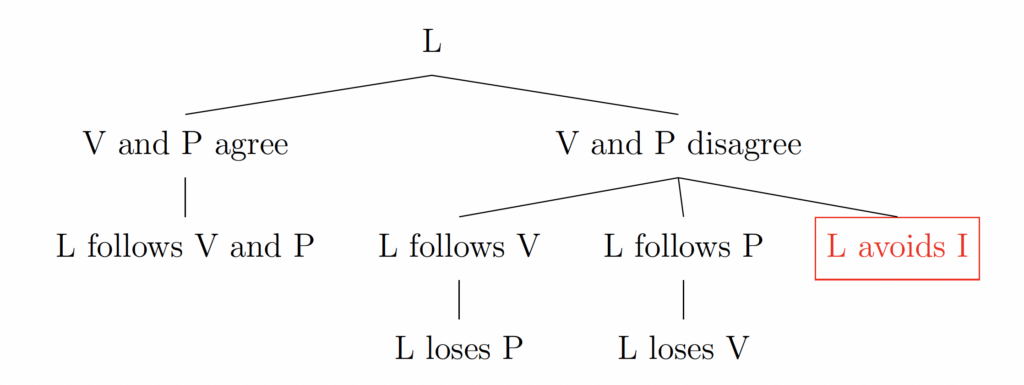
Now, consider our application of this decision to the issue of immigration in the United States. Following our first assumption, the Democratic Party and its potential voters will be more supportive of immigrants than the Republican Party and its potential voters. By default, Democratic legislators should speak frequently and positively about immigrants since this will satisfy both the party and their constituents.
So far, the literature has mostly focused on how Republicans’ attitudes toward immigrants are context dependent (see Mayda, Peri, and Steingress, 2016; Hawley, 2011). The main thesis supports that once naturalized, immigrants will likely vote for the Democratic Party, creating an incentive for Republicans to advocate for additional barriers to migration. However, Republicans have become more radicalized and unified in their socially conservative views toward immigrants (Jeong et al., 2011; Kalaf-Hughes, 2013), a phenomenon that peaked with Donald Trump’s prominence (Eshbaugh-Soha, and Barnes, 2021; Löfflmann, 2022; Sides, Tesler, and Vavreck, 2018). Following these events, we propose that the costs of party deviation among Republicans became increasingly high. Furthermore, the increasing polarization has made any desalience effort irrelevant. These factors explain why Republican legislators should not adjust their discourse to different contexts.
The same is not true for the Democratic Party. While some of their leaders voice strong preferences toward the protection of immigrant populations, its legislators have not become as unified as Republican politicians (Kalaf-Hughes, 2013). Hansen (2022) argues that the prevalence of non-Hispanic White constituents in many electoral districts forces legislators of both parties to be responsive to these target groups. Since these populations tend to be less sensitive to the appeals of immigrant populations, Democrats are likely to adjust their legislative behavior (in terms of salience) to maximize electoral chances. In line with this finding, Jaeger (2019) shows that the larger the Hispanic population of a district, the more likely Democratic legislators will be to adjust their roll-call votes to support that subconstituency’s interest.
We therefore argue that Democrats (but not Republicans) will avoid speaking about immigration when competing in districts where potential voters are less likely to support immigrants’ rights. Alternatively, if they run in districts where the share of potential voters who support these policies is high, they will actively engage in speaking positively about immigrants on social media.
Hypothesis 1 Democratic legislators (but not Republicans) speak more about immigrants and refugees as the share of Hispanic voters in their districts increases.
Hypothesis 2 Democratic legislators (but not Republicans) speak less about immigrants and refugees as the share of non-Hispanic White voters in their districts increases.
Hypothesis 3 Democratic legislators (but not Republicans) speak more about immigrants and refugees as the urbanization of their districts increases.
While equal in essence, the hypotheses vary in the way we operationalize the district’s population of potential target voters. Following the literature, we assume that pro-immigration Democrats will find less support in districts that have fewer Hispanic voters, have more non-Hispanic White voters, and are less urban (for similar arguments, see, respectively, Jaeger, 2019; Hansen, 2022; Facchini, and Steinhardt, 2011).
4 Empirical Strategy
4.1 Data
We test these assumptions and hypotheses by conducting a quantitative text and sentiment analysis of US representatives’ tweets from January 2020 to Election Day (November 3, 2020). We chose this time frame since an election year (particularly a presidential one) is likely to increase the salience of an issue of great centrality in American politics like migration. Furthermore, we focused on US representatives and excluded senators to have comparable district-level data on our independent variables. We scraped US representatives’ official Twitter/X accounts using Twitter/X’s Academic API and the Python library Twarc2 (Summers et al., 2022). From the full corpus of tweets, we then identified those tweets containing the following key root words: immigra*, migra*, and emigra* for the immigrant category, and refugee*, asylum*, and asylum seeker* for the refugee category. We then ran a check to exclude words containing these root words but unrelated to immigrants or refugees, like “migraine.”
To code tweets’ sentiment—that is, the positive, neutral, or negative tone of each tweet—we use a dictionary-based approach that counts the frequency of words in a text and determines their sentiment. We use three different predefined dictionaries to check the reliability of our sentiment coding: the Valence Aware Dictionary and sEntiment Reasoner (Vader) (Hutto, and Gilbert, 2014), the AFINN Sentiment Lexicon (AFINN) (Nielsen, 2011), and the Bing Sentiment Lexicon (Bing) (Hu, and Liu, 2004). We choose Vader to present the main results since it is designed to measure sentiment expressed in social media texts (Hutto, and Gilbert, 2014). However, the three dictionaries are highly correlated (see Appendix Figures A1–A4), and models are robust to using any dictionary. Each tweet’s sentiment is operationalized as shown in Equation 1. This allows us to obtain a sentiment score for each tweet.
(1)
Overall, mean immigrant sentiment (Vader) is 0.16 (minimum value is –0.99 and maximum value is 0.98), with positive values indicating pro-immigrant sentiment. Mean refugee or asylum seeker sentiment (Vader) is 0.21 (minimum –0.97, maximum 0.98), also indicating a mean positive sentiment.5To avoid misclassifying tweets’ sentiment, we also identify tweets by Democratic lawmakers mentioning President Trump or his administration and reclassify those whose negativity was due to criticisms of the president’s policy toward immigrants or refugees rather than these groups themselves.
To check the reliability of our sentiment measure, we examine the extent to which representatives’ sentiment scores on immigrant- and refugee-related tweets correlate with their votes in Congress on immigration-related bills. We obtained the list of bills and legislators’ votes from the lobbying group National Iranian American Council. As Figure 2 shows, the three sentiment dictionaries are positively correlated with legislators’ votes on immigration bills. That is, the more positive the Twitter/X rhetoric of legislators on immigrants and refugees, the more pro-immigrant their votes in Congress.
Figure 2. Correlation of Representatives’ Tweets’ Sentiment with Votes in Congress
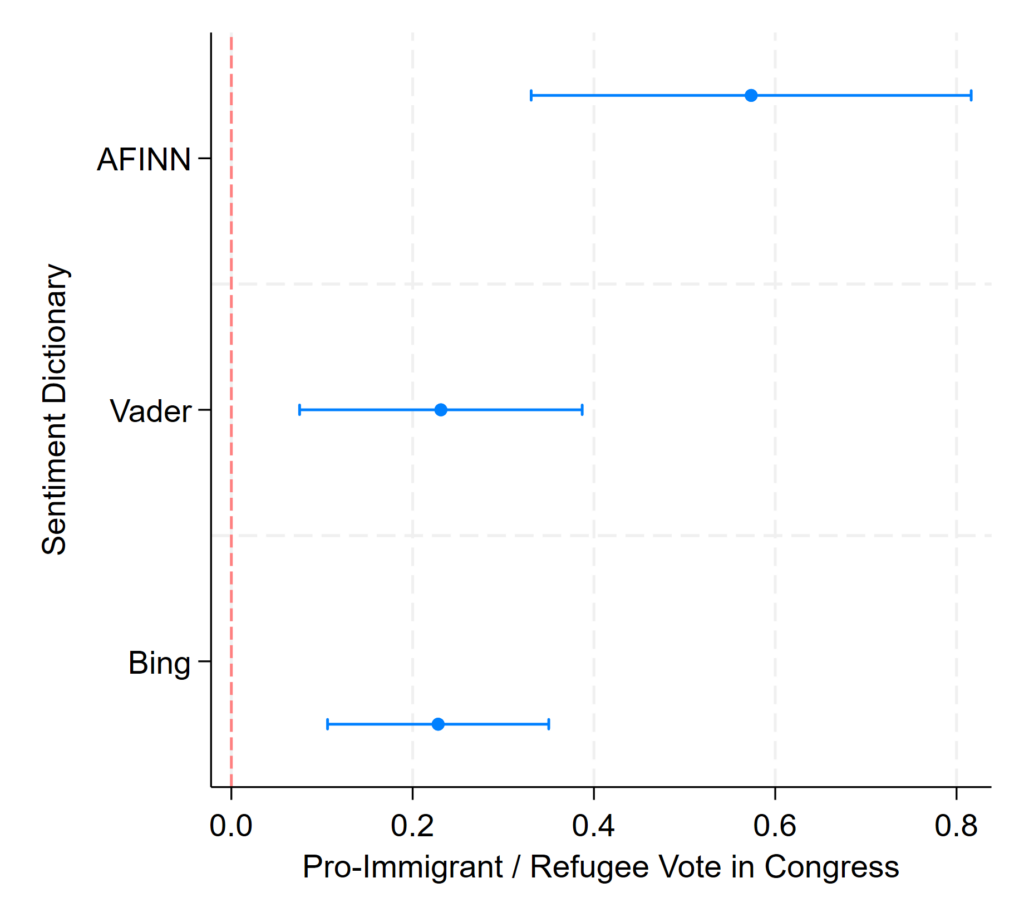
Note: The values are normalized (0–1) so that the coefficients for the three dictionaries are comparable.
We obtain the salience of immigrants and refugees/asylum seekers in legislators’ tweets via Equation 2. This measures the percentage of tweets per member of Congress during the period analyzed that mentions immigrants and refugees or related keywords. The measure follows widely used measures of issue salience in the party politics literature (Spoon, Hobolt, and de Vries, 2014; Abou-Chadi, 2016).
(2)
Of the 492,385 tweets posted by US representatives in the period analyzed, 5,565 (1.13 percent) were related to immigrants or refugees/asylum seekers. Moreover, the salience of these topics is much higher among Democratic legislators. While 1.3 percent of Democratic legislators’ tweets mentioned immigrants and 0.31 percent mentioned refugees or asylum seekers during the 2020 election campaign, only 0.39 percent of Republican legislators’ tweets mentioned immigrants and 0.05 percent mentioned refugees or asylum seekers (see Appendix Figures A6–A8).
4.2 Variables and Models
Our dependent variables for sentiment are Pro-Immigrant Sentiment and Pro-Refugee Sentiment, which use a continuous measure of sentiment from –1 to 1, where negative values indicate negative sentiment toward immigrants or refugees and positive values indicate positive sentiment. These are obtained from Equation 1. The two dependent variables for salience are Immigrant Salience and Refugee Salience, which show the percentage of a legislator’s tweets mentioning immigrants or refugees, respectively. These are obtained from Equation 2.
Our main independent variables are a party dummy (Republican) identifying whether the legislator tweeting is Republican or Democratic. We include three different proxies for the level of immigrant or refugee population in a legislator’s district: % District NH White, measuring the percentage of a district’s population identifying as non-Hispanic White, obtained from the US Census Bureau; % District Hispanic, measuring the percentage of a district’s population identifying as Hispanic, obtained from the 2019 American Community Survey; and % District Urban, measuring the percentage of a district’s urban population, obtained from ProximityOne.6“ProximityOne Decision-Making Information,” http://proximityone.com, accesed on March 15, 2024. To test Hypotheses 1–3, we include interaction terms between the party dummy and these three variables.
We include a series of controls that could affect legislators’ sentiment toward immigrants and refugees and the extent to which they discuss these topics. % District Unemployment measures a district’s unemployment level and is obtained from the 2019 American Community Survey. Southern Border is a dummy indicating whether the legislator represents a congressional district from a southern border state (California, Arizona, New Mexico, or Texas). Retiring is a dummy identifying whether the legislator is retiring at the end of the Congress. We also include demographic controls for a legislator’s ethnicity7These data are obtained from the website of the House of Representatives (“U.S. House of Representatives Press Gallery,” https://pressgallery.house.gov/member-data/demographics, accessed on March 15, 2024) and includes as minorities the categories “Black Americans,” “Hispanic Americans,” “Asian Americans,” and “American Indians.” (Black, Hispanic, other, and White, the reference category), education level (postgraduate degree, college degree, and less than a college degree, the reference category), sex, and age. All descriptive statistics are available in Appendix Table A1.
Since our dependent variables are continuous, we use ordinary least squares regressions with robust standard errors in all models. The unit of analysis in the sentiment models is each individual tweet, and thus we cluster standard errors at the legislator level. In the salience models, the unit of analysis is each legislator.
5 Findings
5.1 Sentiment
In line with Assumptions 1 and 2, Figure 3 shows boxplots with the median sentiment score for immigrants and refugees by party along with violin plots showing the distribution of tweets’ sentiment. While Democratic legislators are overall positive toward both immigrants and refugees (with median scores of 0.36 and 0.37, respectively), Republican legislators are mostly negative toward immigrants and positive toward refugees (with median scores of –0.08 and 0.40, respectively). These patterns are replicated when using other sentiment dictionaries (see Appendix Figure A5).
Assumptions 1 and 2 also hold when controlling for other potential confounders of legislators’ sentiment besides partisanship in regression models. Figure 4 shows a coefficient plot of different regression models controlling for potential confounders (see full models in Appendix Table B1). As the figure shows, Republican tweets are consistently more negative toward immigrants than Democratic tweets, whereas there is no statistically significant difference when it comes to refugee tweets. These results hold when using different sentiment lexicons (see Appendix Tables C1 and C2).
Figure 3. Tweets’ Sentiment by Party
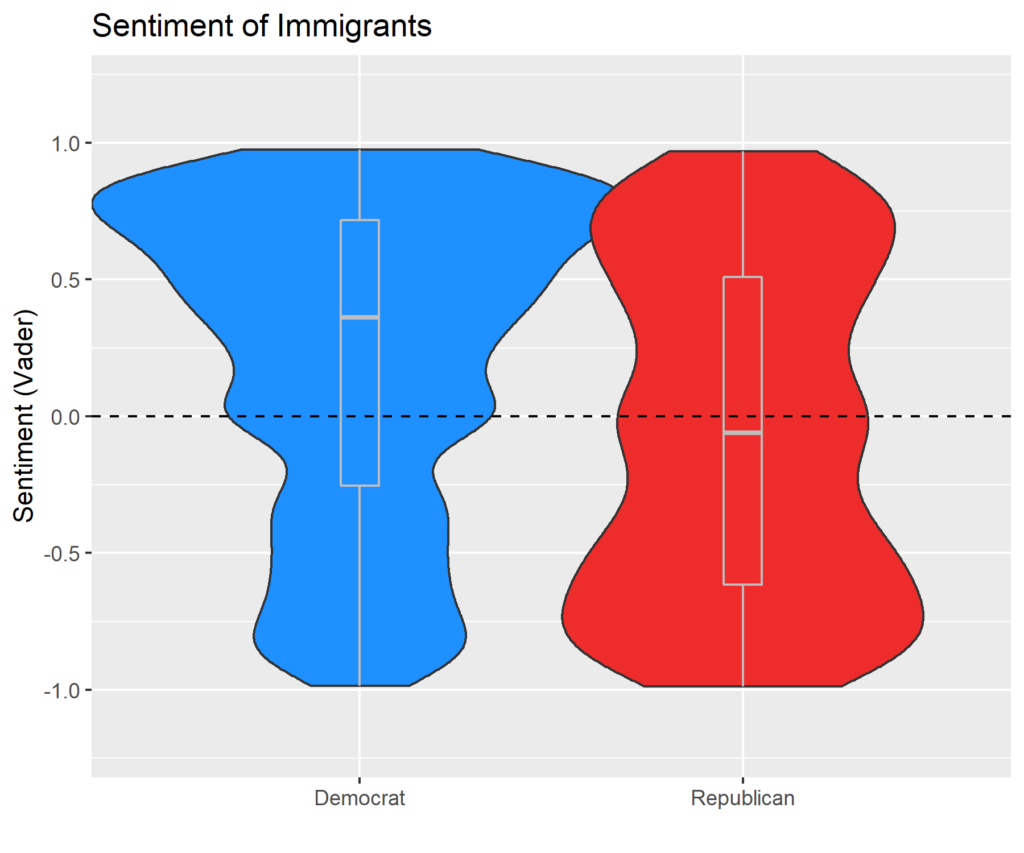
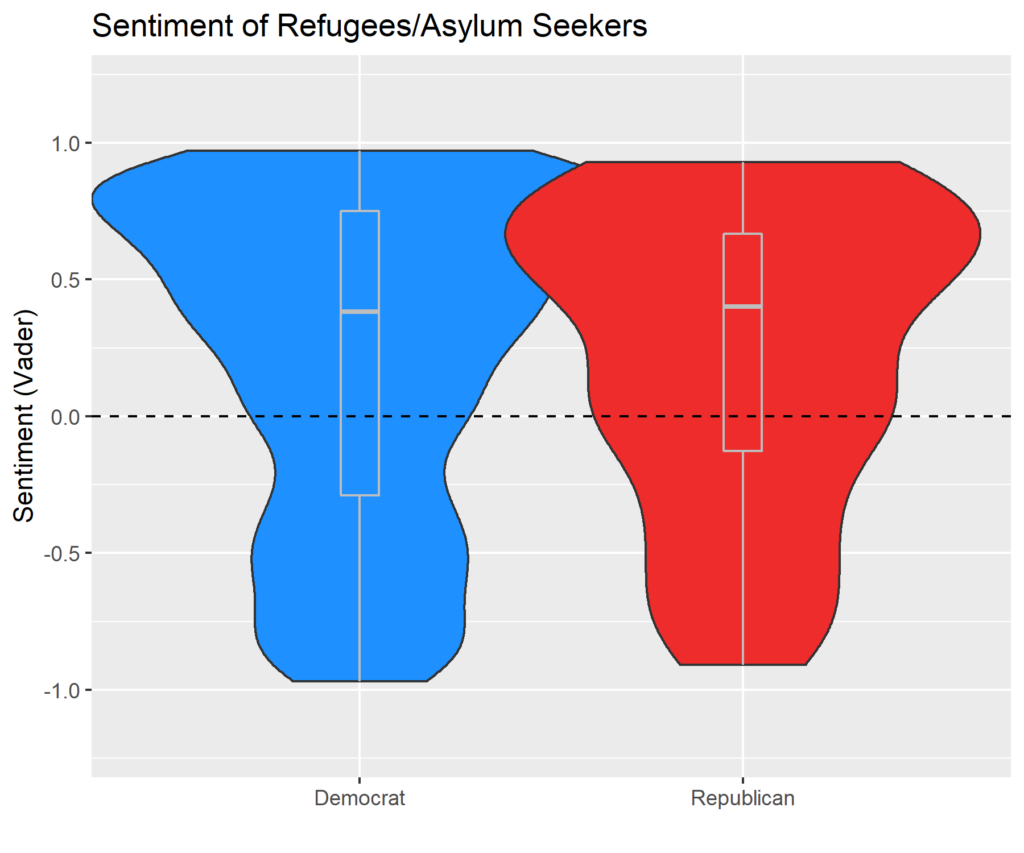
Note: Boxplots and violin plots show median sentiment scores and the sentiment distribution for immigrant (left panel) and refugee (right panel) tweets.
It should be noted that the targets identified as refugees by both parties differ. While Democratic legislators use the terms “immigrant” and “refugee” interchangeably to refer to migrants coming from the southern border, Republican legislators use the term “immigrant” mostly to refer to those coming from the southern border, while reserving the term “refugee” when tweeting about potential Hong Kong refugees. This is likely contextual since 2020 saw a rise in the topic of potential Hong Kong refugees due to the Chinese regime’s crackdown on Hong Kong protesters. In this sense, these potential refugees escaping a communist dictatorship were likely seen as more deserving among Republican legislators than economic migrants from Central America. These distinctions between parties’ target groups when discussing immigrants and refugees can be observed by examining semantic networks plotting the most common word associations in legislators’ tweets. See the semantic networks by party and term in Appendix Figures A9–A12.
Figure 4. Models of Republican Party Effect on Tweets’ Sentiment
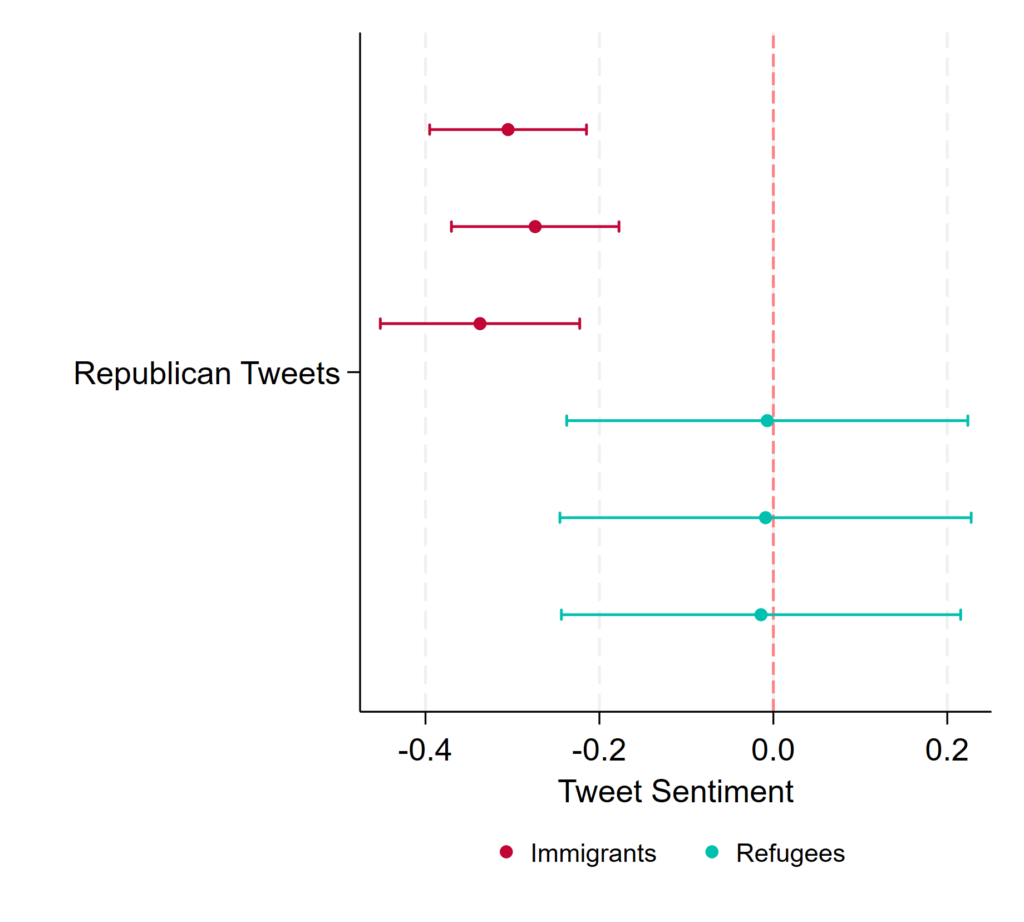
Note: The models are based on Appendix Table B1, and they control for either % District Hispanic, % District Non-Hispanic White, or % District Urban. All other controls are included.
5.2 Salience
Figure 5 shows the average marginal effects of legislators’ partisanship on the salience of immigrants at different levels of a district’s Hispanic (H1), non-Hispanic White (H2), and urban population (H3). As expected, the more Hispanic and more urban a district, the more Democratic representatives talk about immigrants in their tweets. Also as expected, the whiter (non-Hispanic) a district, the less Democratic legislators talk about immigrants.
In substantive terms, the salience of immigrants in Democratic legislators’ tweets ranges from zero in districts with no Hispanics to 3 percent of all tweets mentioning immigrants in districts where 85 percent of the population or more is Hispanic (H1). Similarly, the salience of immigrants ranges from zero in fully non-Hispanic White districts to more than 2 percent of all tweets in districts with less than 10 percent identifying as non-Hispanic White (H2). Finally, immigrant salience ranges from zero in fully rural districts to more than 1 percent of tweets in fully urban districts (H3).
Figure 5. The Effect of Party and District Characteristics on Immigrant Salience
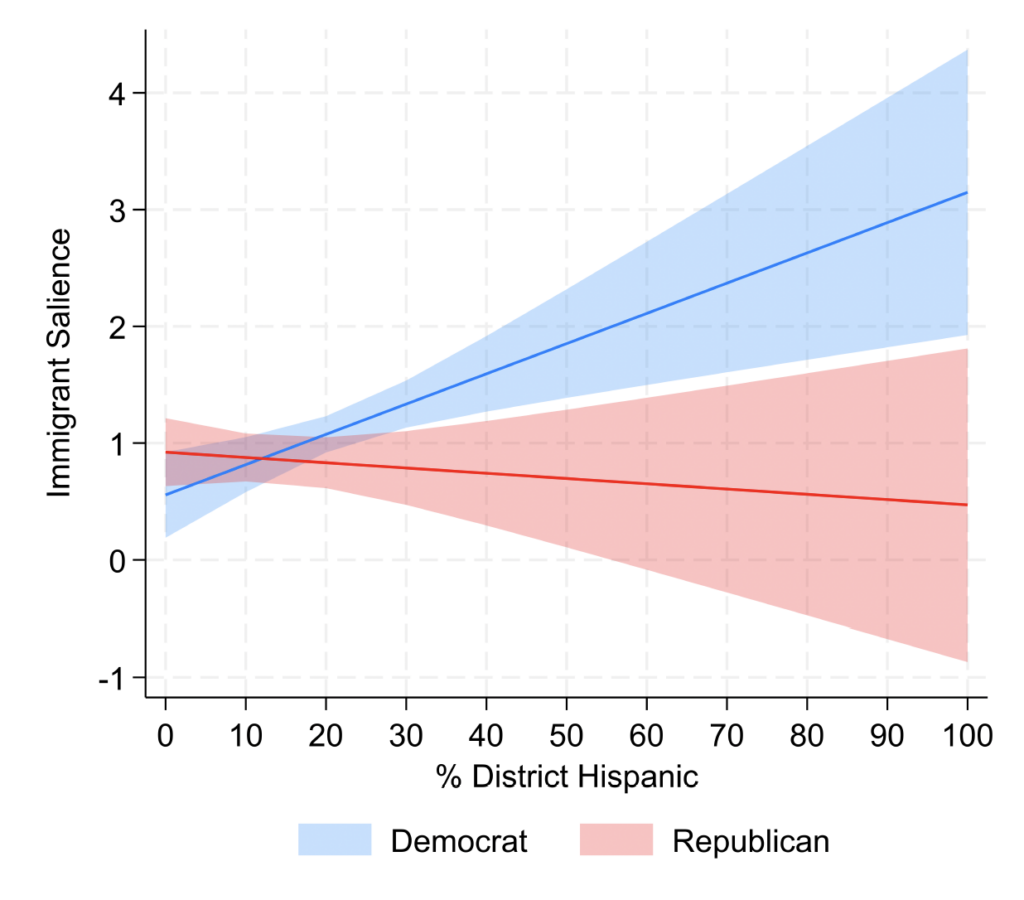
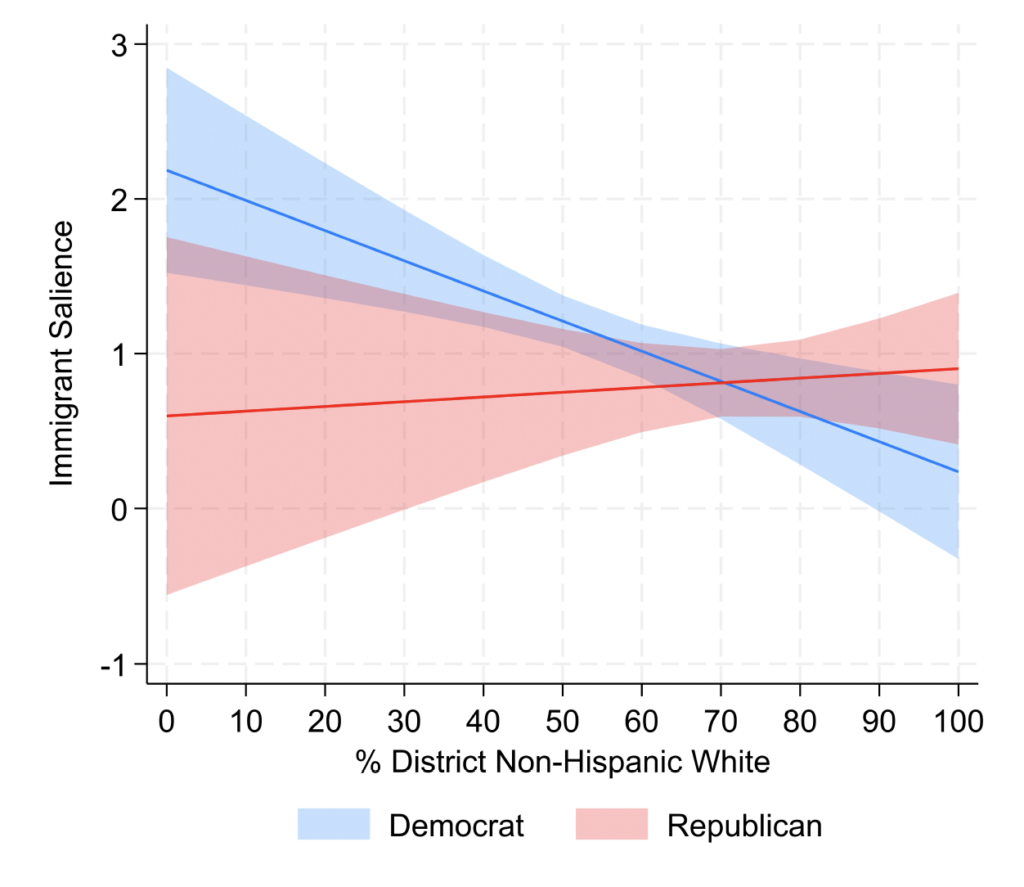
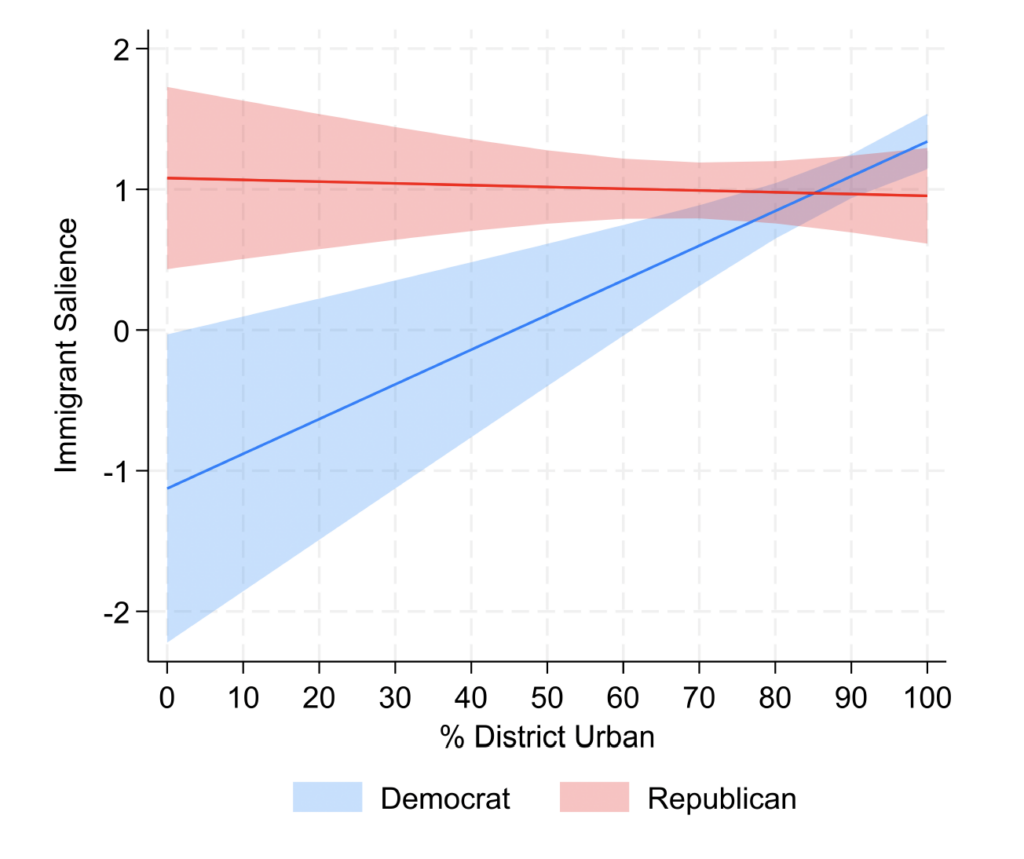
Note: The models are based on Appendix Table B2, and all controls are included.
As hypothesized, there is no statistically significant effect of a district’s ethnic or urban composition and Republican legislators’ immigration salience, showing a more strategic use of the immigrant issue based on district characteristics (at least when it comes to salience on Twitter/X) among Democrats.
Figure 6 shows the average marginal effects of legislators’ partisanship on the salience of refugees at different levels of a district’s Hispanic, non-Hispanic White, and urban population. As hypothesized, the more Hispanic a district, the more Democratic representatives talk about refugees or asylum seekers. Similarly, the whiter (non-Hispanic) a district, the less Democratic legislators talk about refugees. Unlike in the case of immigrants, there is no statistically significant effect for urban population. Finally, as expected, there is no statistically significant effect of a district’s ethnic or urban characteristics on Republican legislators’ salience of refugees, as was the case for immigrants, showing, once again, a more strategic use of the topic by Democrats. Full salience models are available in Appendix Table B2.
6 Robustness Checks
We run a series of robustness checks to test the consistency of both the sentiment and salience models after including different controls. First, we check whether the positive sentiment of Republican legislators toward refugees is driven by the cosponsors of H.R. 461. This is also known as the Hong Kong Safe Harbor Act, which was sponsored by Republican Representative John Curtis from Utah’s third congressional district, and cosponsored by other 16 Republican representatives along with 11 Democrats. After dropping these cosponsors, the results remain consistent. Figure C1, panel (c) shows that Republican sentiment toward refugees is not statistically different from Democratic sentiment. Similarly, Table C3 and Figure C2 show that the salience models remain consistent as well.
Second, since our analysis spans from January 1 to Election Day on November 4, we check for potential differences between the primary season and the general election months. Figure C1, panel (a) shows the results for the sentiment models. While sentiment toward refugees remains consistent in both periods, the difference in sentiment toward immigrants by party is only significant during the primary season, while it becomes statistically insignificant during the general election months. It appears that Republican representatives are negative toward immigrants during the primaries but reduce their negativity during the general election campaign, in line with the “post-primary rhetorical moderation hypothesis” (Acree, and Boydstun, 2020). In terms of salience, Tables C6 and C7 and Figures C5 and C6 show that the results are consistent in both election periods.
Figure 6. The Effect of Party and District Characteristics on Refugee Salience
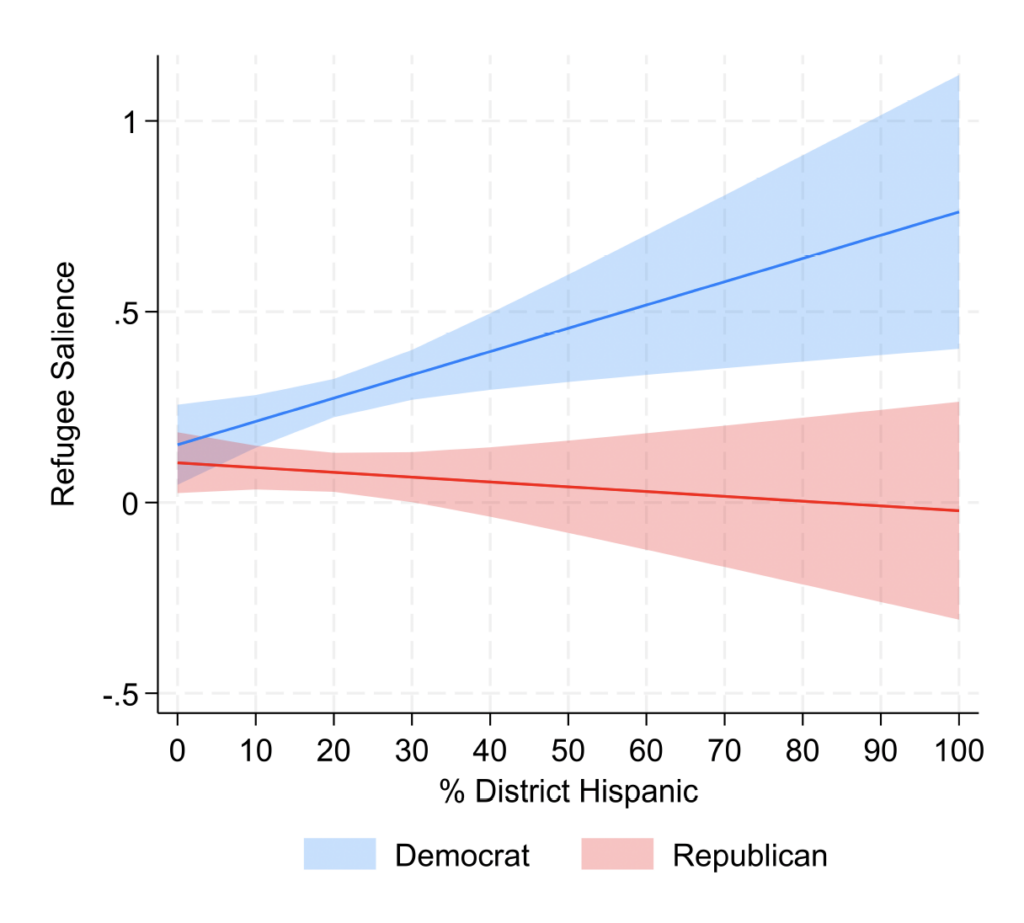
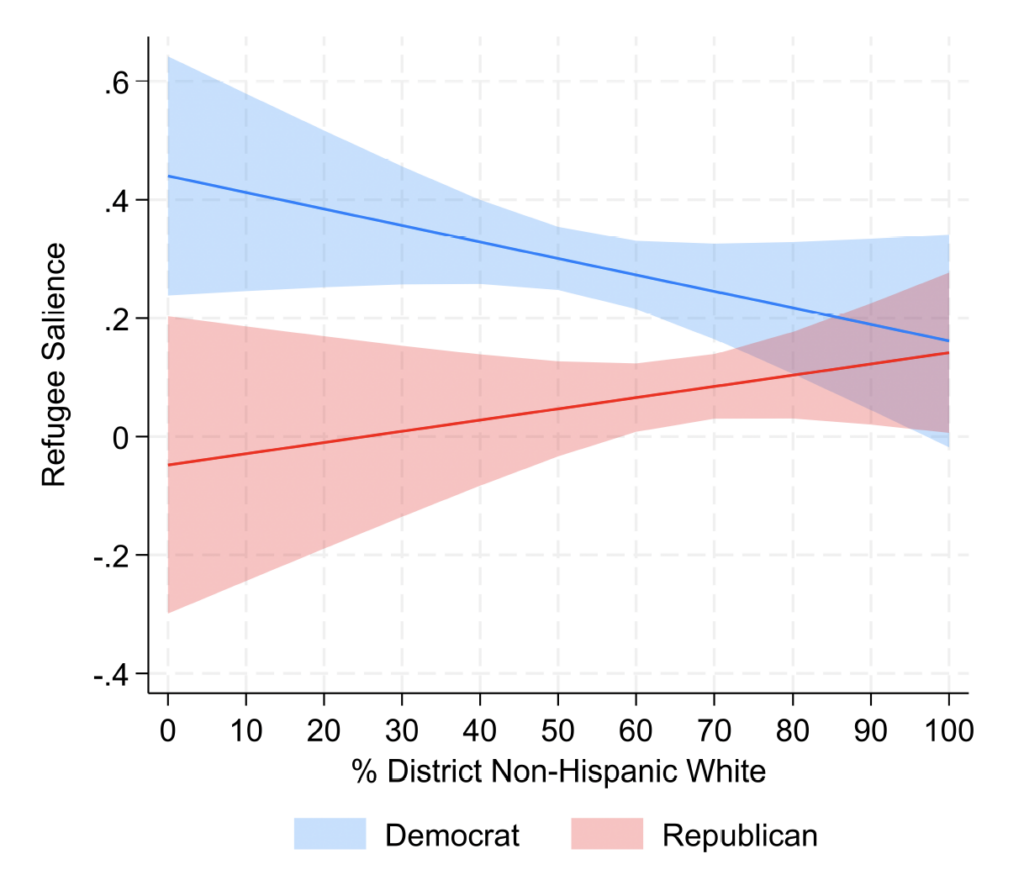
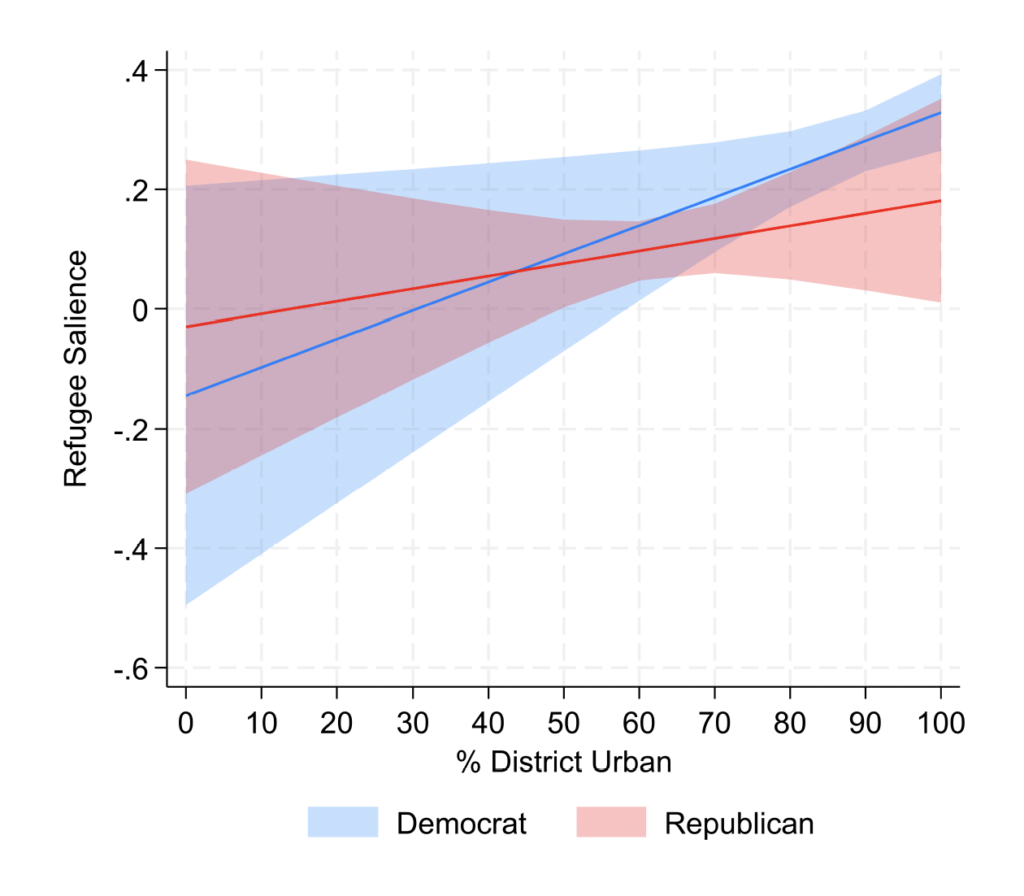
Note: The models are based on Appendix Table B2, and all controls are included.
Third, to check whether the closure of US borders due to the COVID-19 pandemic influenced the results, we check the consistency of the results before and after the Centers for Disease Control and Prevention invoked Title 42 in March 2020 under the Trump administration, requiring “the expulsion of unauthorized single adults and family units arriving at the land borders in order to protect against the spread of COVID-19.” In terms of sentiment, Figure C1, panel (b) shows that the results are consistent before and after Title 42. In terms of salience, Appendix Tables C4 and C5 and Figures C3 and C4 show that the results are consistent in both periods.
Fourth, we also check whether the number of COVID-19 cases at the congressional district level affect the results. Using data from deSouza, and Subramanian (2020), we include a control for the number of COVID-19 cases per 1,000 residents. Figure C1, panel (d) shows that the results remain consistent for sentiment, and Table C8 and Figure C7 show that the results remain mostly consistent for salience.
Finally, we check whether Democrats’ increased immigrant salience in urban districts is driven by the greater presence of immigrants (as expected) or by the presence of a more educated electorate, a higher Black population, or both. We run salience models controlling for the percentage of the population at the congressional district level with a college degree or higher and the percentage of the population identifying as Black, obtained from the 2019 American Community Survey. Appendix Table C9 and Figure C8 show that the results remain consistent, indicating that a district’s urban population is not just a proxy for a highly educated citizenry or a high proportion of Black residents.
7 Discussion and Conclusion
Migration policy is a relevant issue for political parties in several countries around the globe (Dennison, 2019). This is particularly true in the United States, where immigration has been a topic of debate in congressional speeches for the last 140 years (Card et al., 2022), and was a central topic of Donald Trump’s presidential campaign and administration (Eshbaugh-Soha, and Barnes, 2021). Our analysis shows how Democratic and Republican legislators differ in the way they talk about immigrants and refugees, how much they talk about them, and whether they talk more depending on the district they represent. Additionally, we show that the sentiments they express on Twitter/X match their legislative behavior.
Our tests unsurprisingly confirm that Democrats are more favorable toward immigrants than Republicans (see, e.g., Card et al., 2022). It merits highlighting that these interparty differences are more visible during the primaries. In our robustness checks, we find support for Acree, and Boydstun’s (2020) “post-primary moderation hypothesis” in that Republicans become more neutral toward immigrants after the primaries. In fact, after the primaries, the sentiments espoused in their tweets are not statistically different from those of Democratic representatives.
We demonstrate that both groups of legislators use the term “refugee” favorably during and after the primaries. This supports the existing literature that posits that this term is a discourse element legitimizing the claims of specific peoples (Onraet et al., 2019; Hamlin, 2021; Brown, and Dromgold-Sermen, 2022). As we further discuss, our analysis shows that Republicans and Democrats are speaking of different peoples when they use the term refugee. Democrats use the terms immigrant and refugee almost interchangeably. Republicans, on the other hand, often refer to those coming through the southern border as immigrants and label as refugees those coming from Hong Kong.
As it happened with a substantive portion of immigrants coming from Cuba, Nicaragua, and Venezuela (Portes, and Armony, 2018; Bishin, and Klofstad, 2012), Hong Kong refugees were fighting a communist regime. If they stay long enough to become voters, this “common enemy” makes Hong Kong refugees potential voters of the Republican Party in the future (at least in the strategic perception of Republican lawmakers). In fact, this may also explain why conservative legislators sponsored the Hong Kong Safe Harbor Act, which intended to facilitate immigration to the United States.
Interestingly, regardless of policy positions, the salience of these terms in the online political discourse of legislators is considerably different. Among all tweets posted by Democratic legislators during the electoral campaign, 1.33 percent referred to immigrants and 0.31 percent to refugees. In the same period, Republicans dedicated 0.39 percent and 0.05 percent of their tweets to these topics, respectively. This shows that despite Donald Trump’s expressive rhetoric toward immigrants (Eshbaugh-Soha, and Barnes, 2021), it is the Democratic Party that tries to dominate the public discourse about the topic.
While Democrats’ and Republicans’ public stance on migration policy are relatively stable, Democrats strategically adjust the topic’s salience depending on their district’s characteristics. We theorized that legislators will avoid publicly disagreeing with their voters and the party to keep away from sanctions while retaining high chances of reelection. Our theory is based on the costs of dissent. We argued that publicly disagreeing with one’s party is more costly than becoming silent, meaning they will refrain from posting about topics in which potential voters and the party disagree.
As we demonstrate, this is the case for Democrats who compete in districts with few Hispanic voters (H1), many non-Hispanic Whites (H2), and a low degree of urbanization (H3). These legislators posted considerably less about immigrants and refugees than their copartisans running in more urbanized and ethnically diverse districts. Our findings remain robust after several checks including, for instance, the effects of the COVID-19 pandemic and other sociodemographic characteristics of the districts. However, in contrast to previous studies (Mayda, Peri, and Steingress, 2016; Hawley, 2011), we find that Republicans do not change their strategic discourse.
This asymmetric response, as we previously argued, is attributed to the internal politics of both parties. On the one hand, the Republican Party has become more socially conservative over time (Jeong et al., 2011; Kalaf-Hughes, 2013) and chose southern border immigrants as their target during Trump’s presidential campaign (Eshbaugh-Soha, and Barnes, 2021; Löfflmann, 2022; Sides, Tesler, and Vavreck, 2018). The costs of dissent then became considerably high. Furthermore, the collective shift from the primary to the general election confirms the relevance of unity for the party. Still, as we show, this was not a dominant issue in the legislators’ tweets. On the other hand, prior literature shows that Democrats are not as unified on this issue as Republicans (Kalaf-Hughes, 2013; Hansen, 2022; Jaeger, 2019), thus reducing the costs of dissent.
In addition to the specific contribution to our understanding of party preferences and strategic behavior toward migration policy, this paper also adds to the literature investigating intraparty differences. To be more specific, the dominant empirical strategy so far relies on roll-call votes to measure legislators’ preferences and party unity. As we highlight, there are several weaknesses with this approach (see, e.g., Ames, 2002).
The increased use of social media platforms for electoral campaigns allows scholars to use computational text analysis of online communication as a source of information. Focusing on all the tweets posted by US representatives during the 2020 election campaign, we show the reliability of these data to make accurate inferences about strategic communication and intraparty disagreement. In the future, scholars should further investigate the comparability between roll-call and Twitter/X data. This will shed light on the differences between legislative voting behavior and strategic communication, as well as on the strategies adopted by legislators to respond to both their party’s interests and their constituents’ preferences.
Furthermore, such comparisons would allow scholars to further investigate how legislators navigate the conflicting interests of their two masters, that is, their constituents and their party (Cox, and McCubbins, 2007). We saw that when it comes to immigration, Democrats opt for being silent when they believe their party preference will not resonate well with their district’s electorate. However, it is possible that they compensate such silence on another policy topic, for example, doubling down on the party’s position (in terms of salience or sentiment). Future studies should benefit from computational text analysis to investigate this issue.
Appendix
A Descriptives
Figure A1. Correlations of Dictionaries (Immigrants)
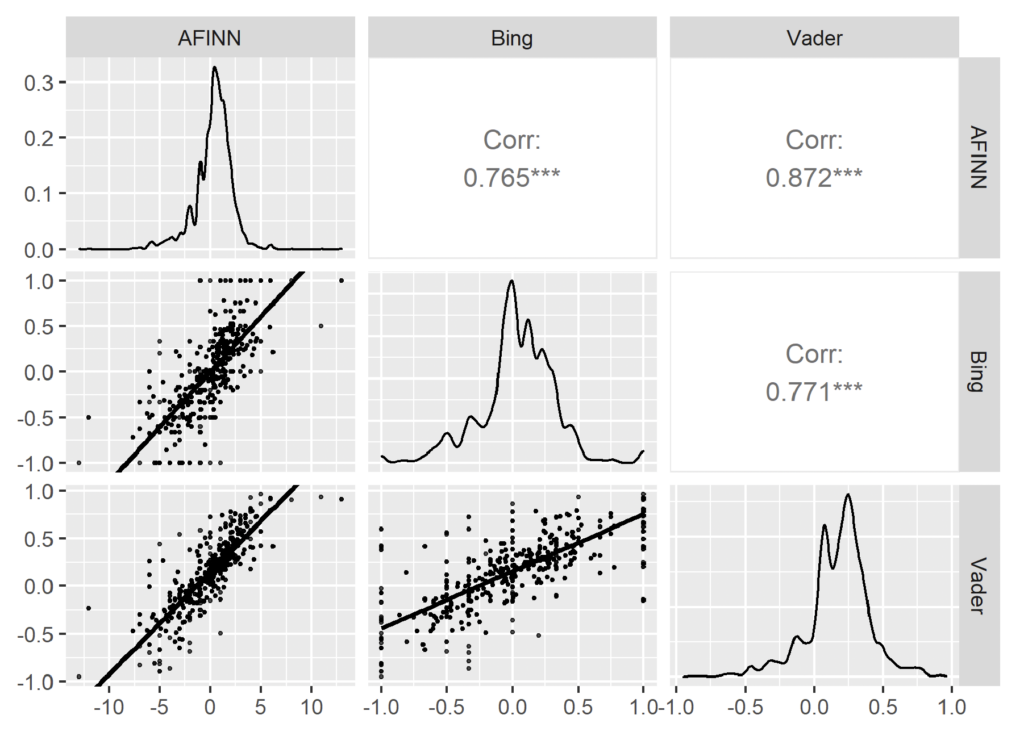
Figure A2. Correlations of Dictionaries (Refugees/Asylum Seekers)
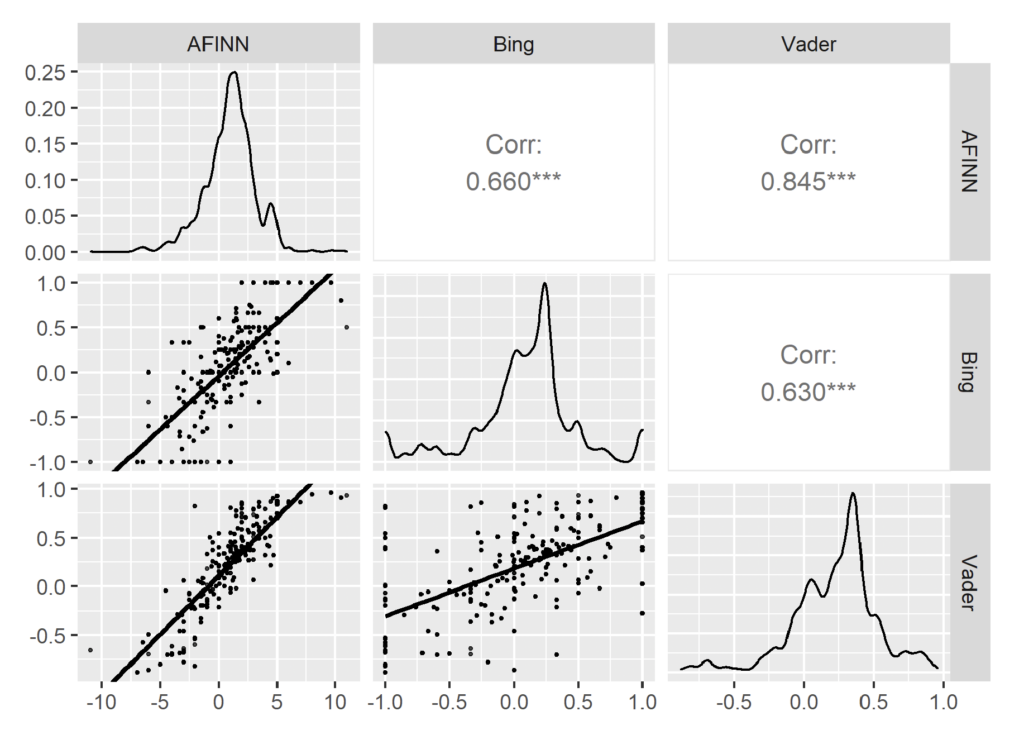
Figure A3. Correlations of Dictionaries by Party (Immigrants)
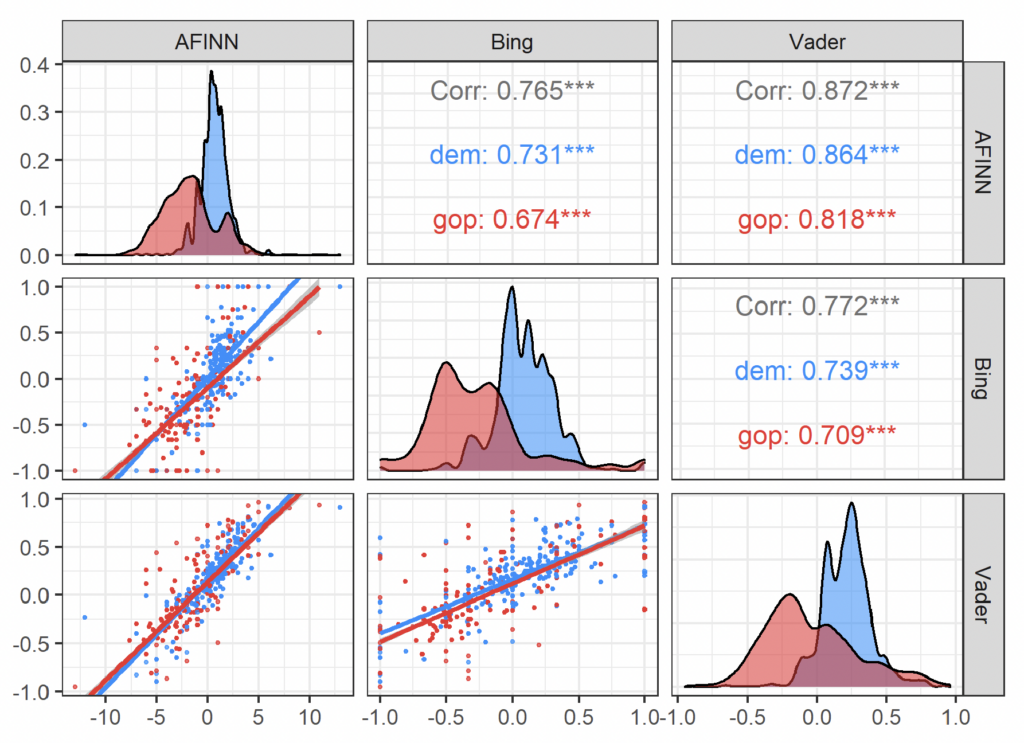
Figure A4. Correlations of Dictionaries by Party (Refugees/Asylum Seekers)
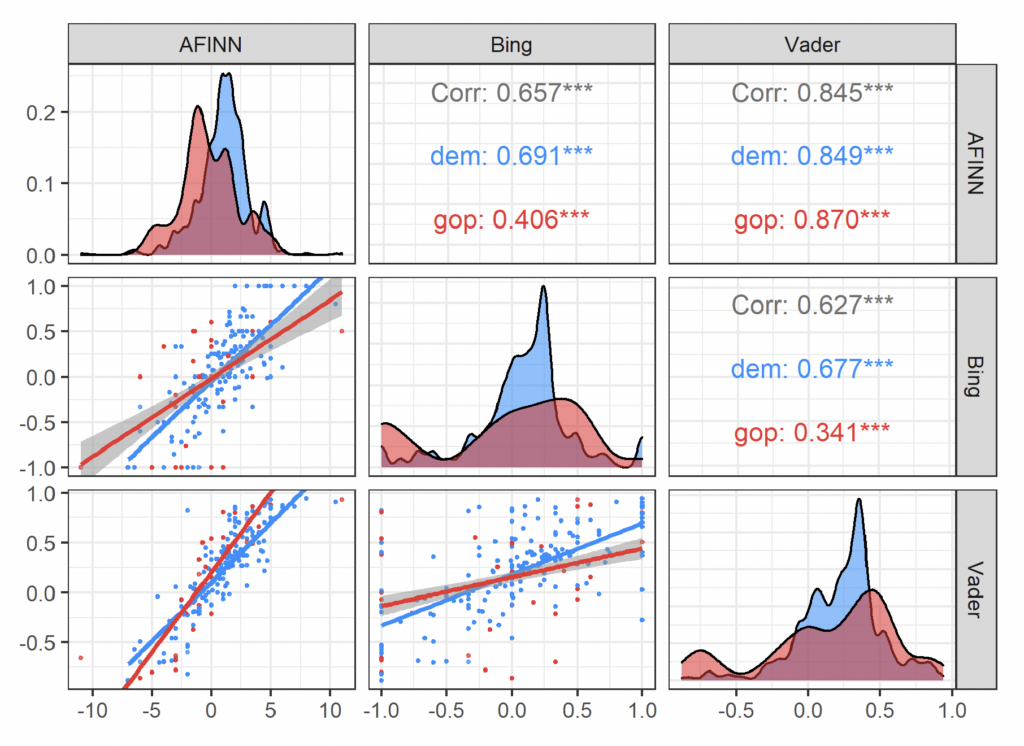
Figure A5. Sentiment by Party (AFINN & Bing Dictionaries)
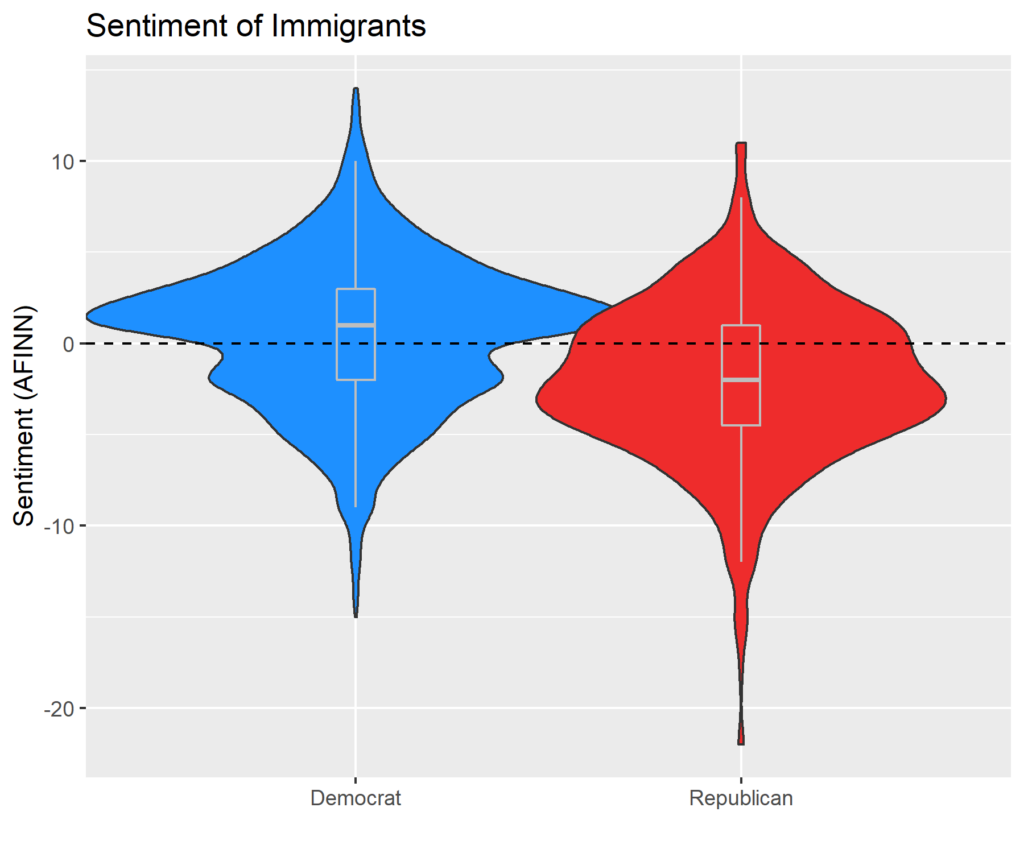
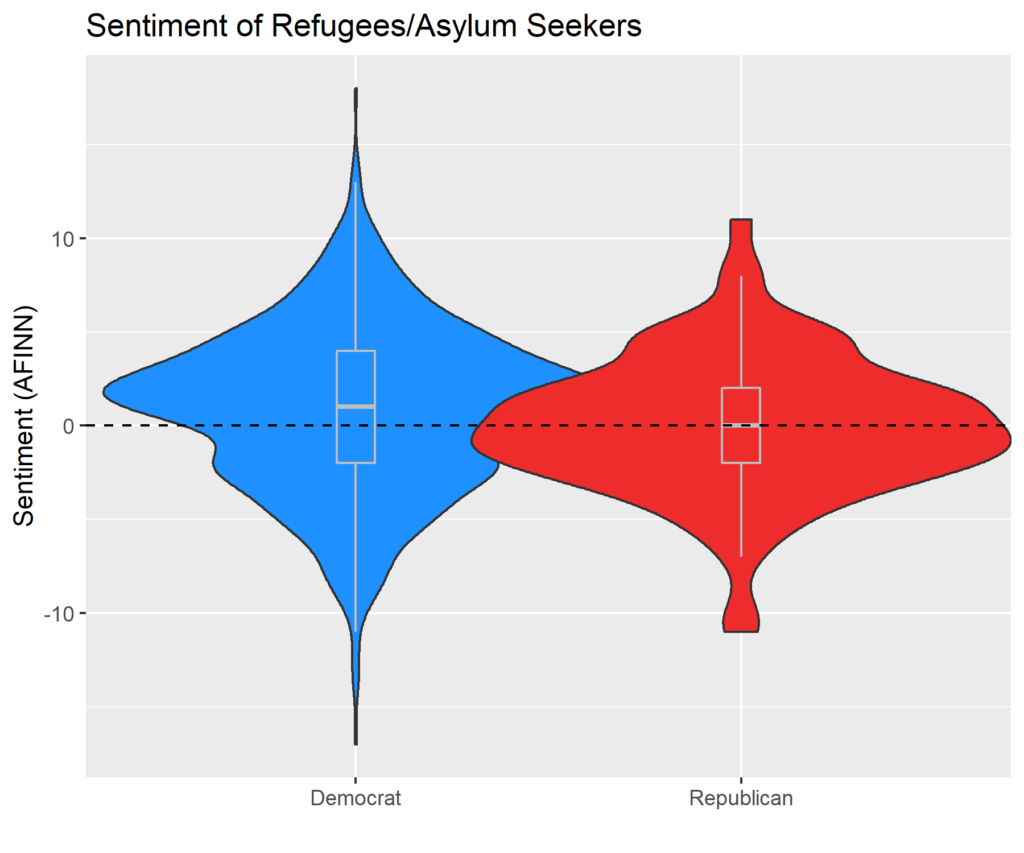
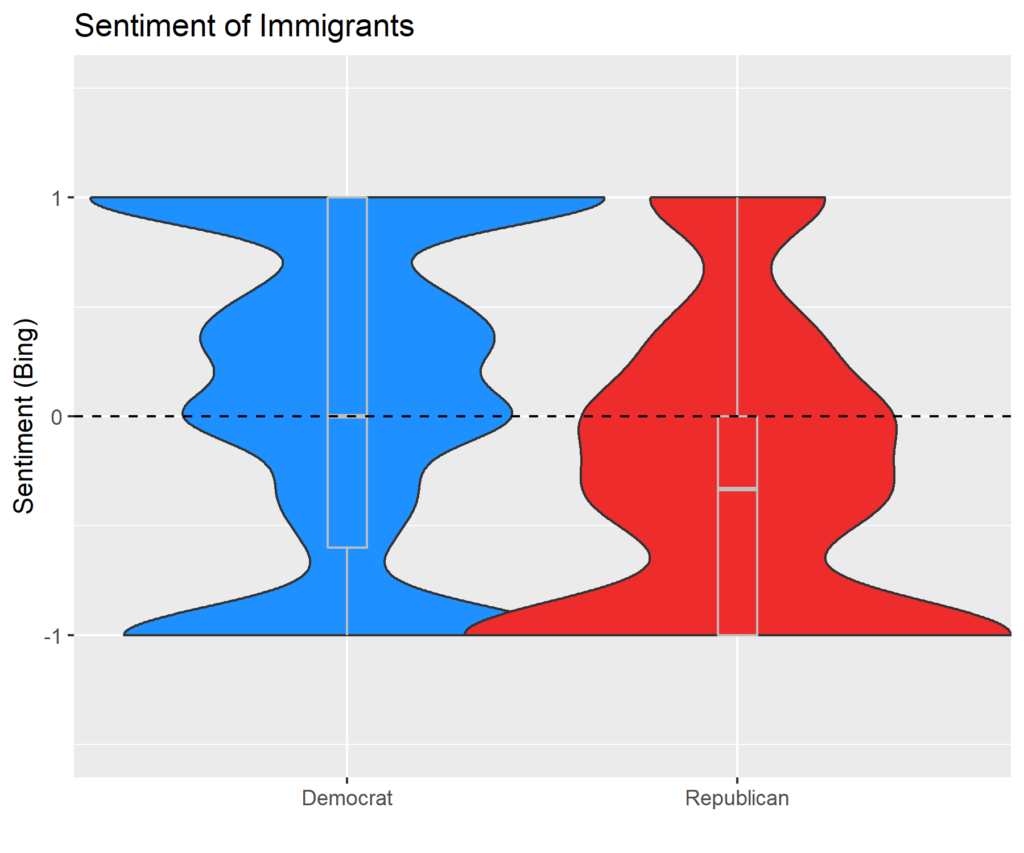
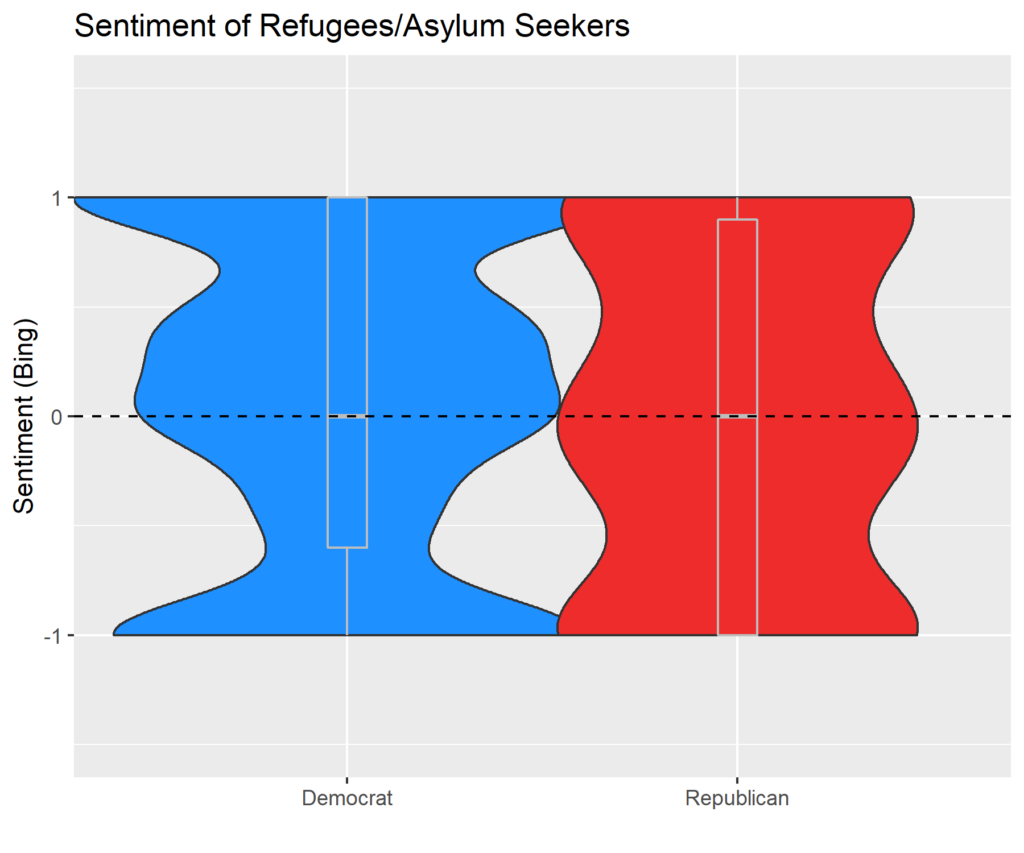
Figure A6. Salience by Party
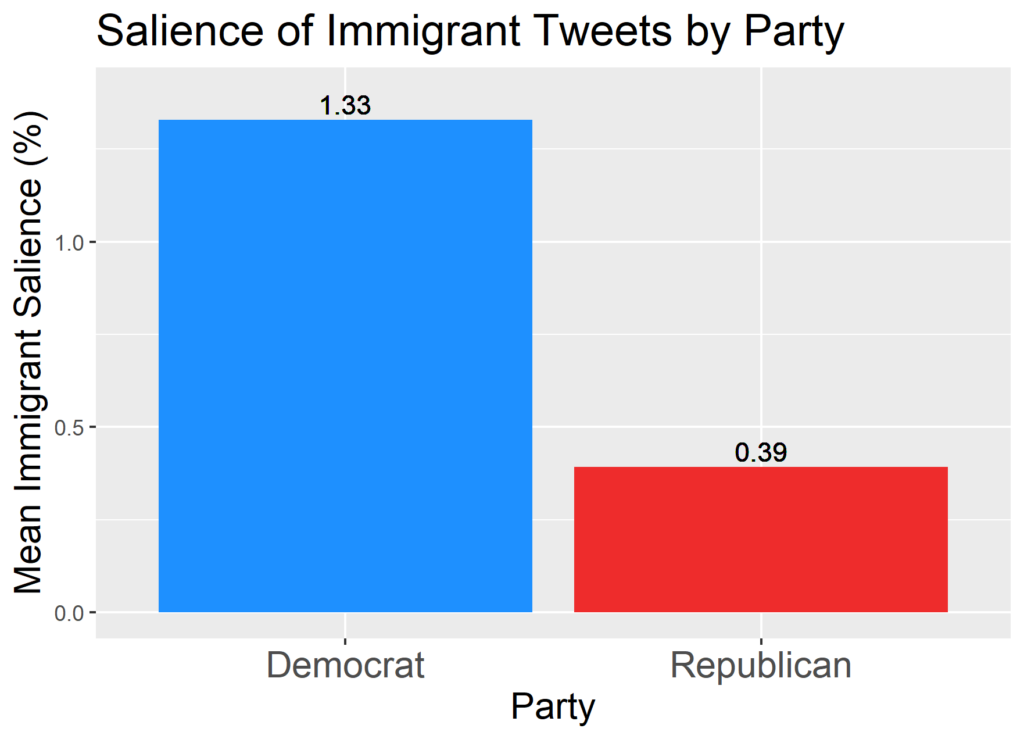
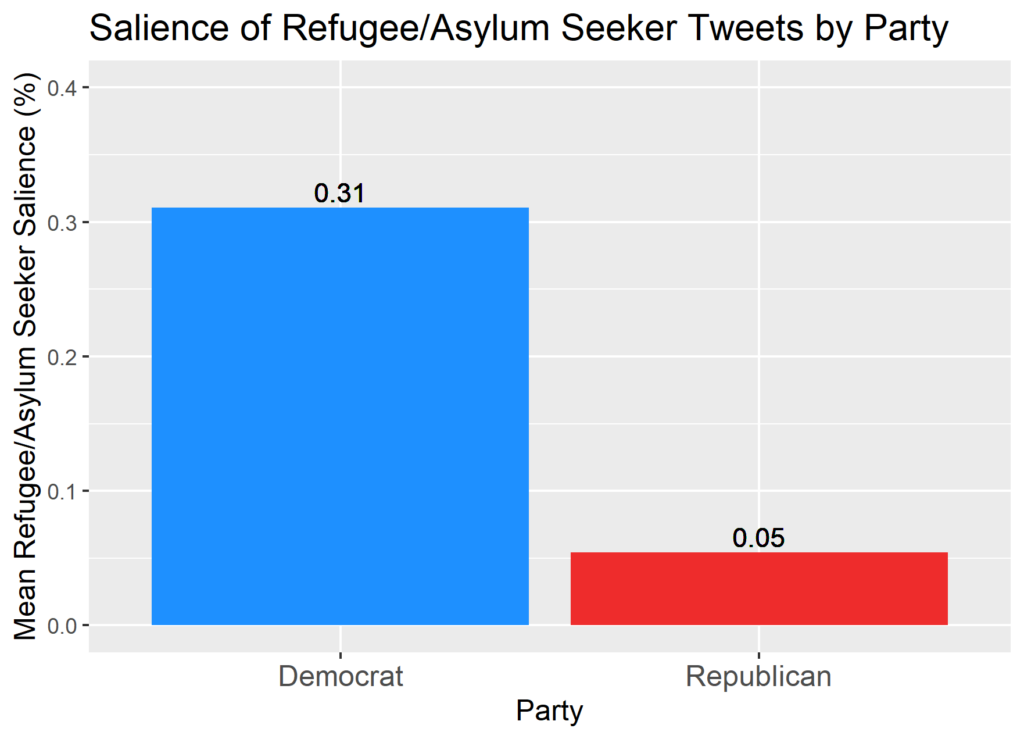
Figure A7. Distribution of Salience
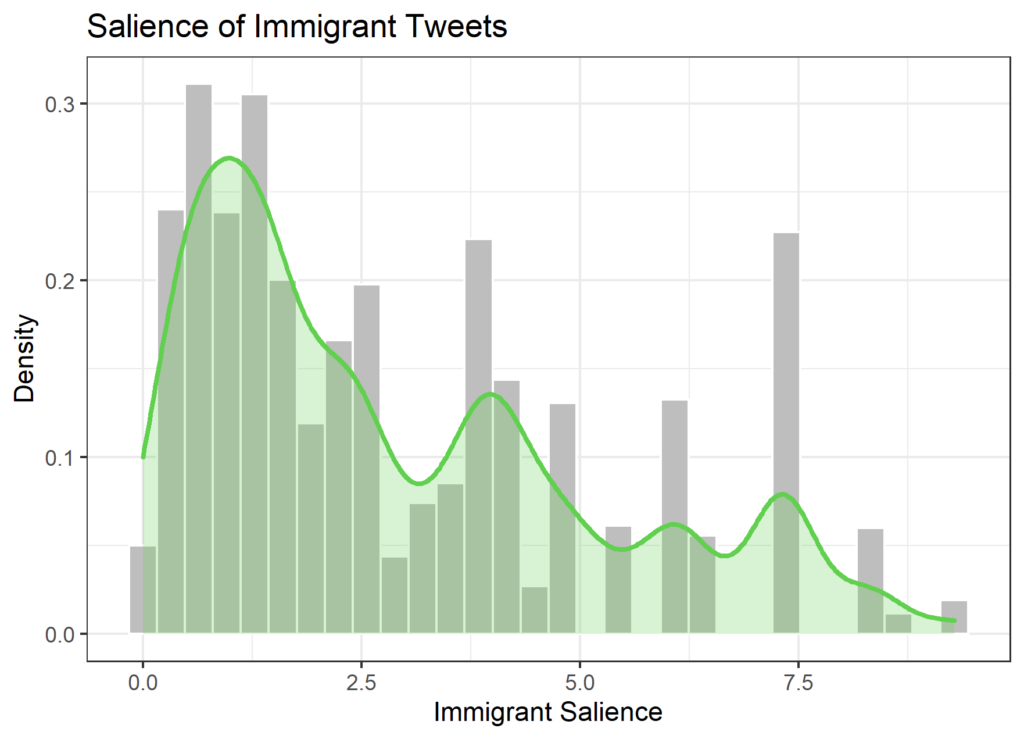
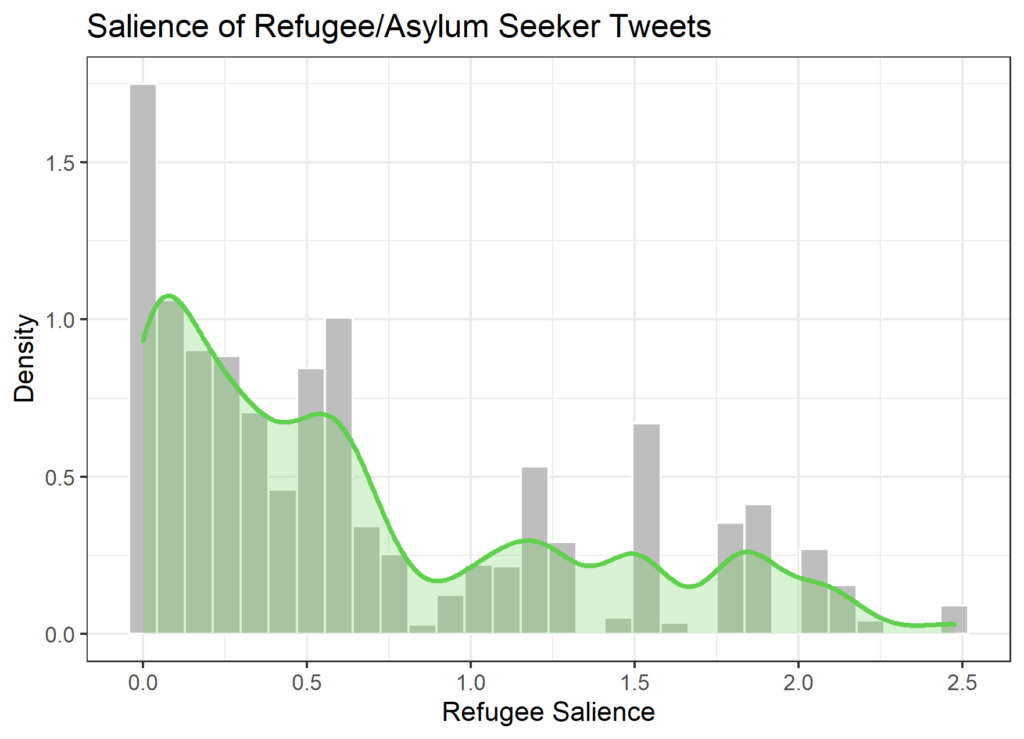
Figure A8. Distribution of Salience by Party
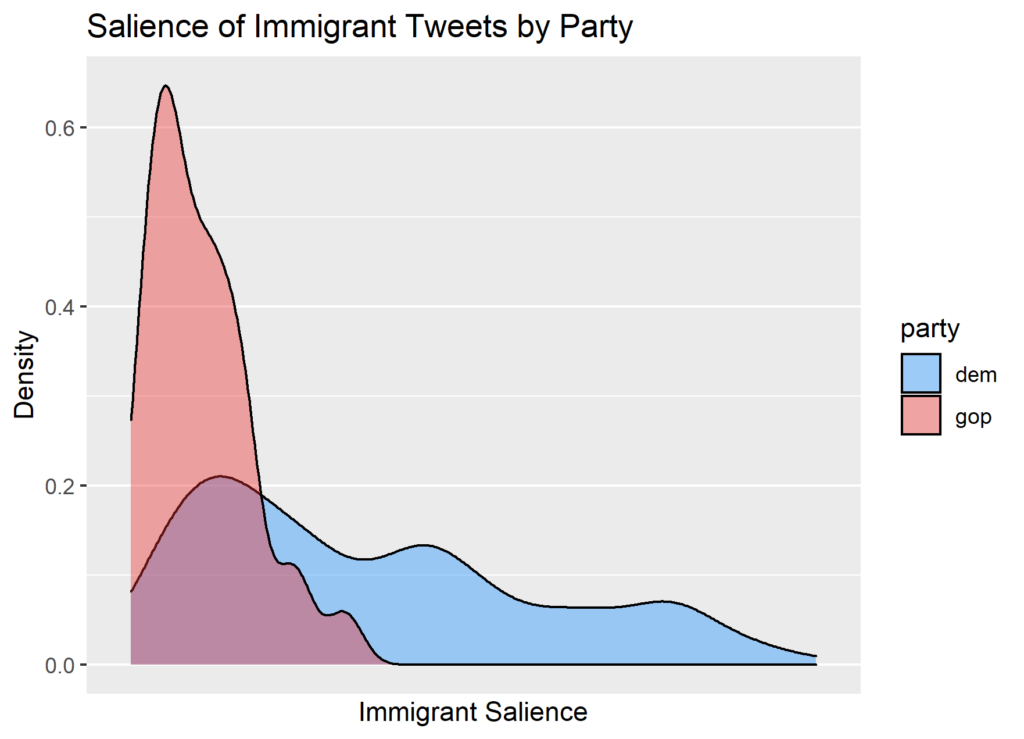
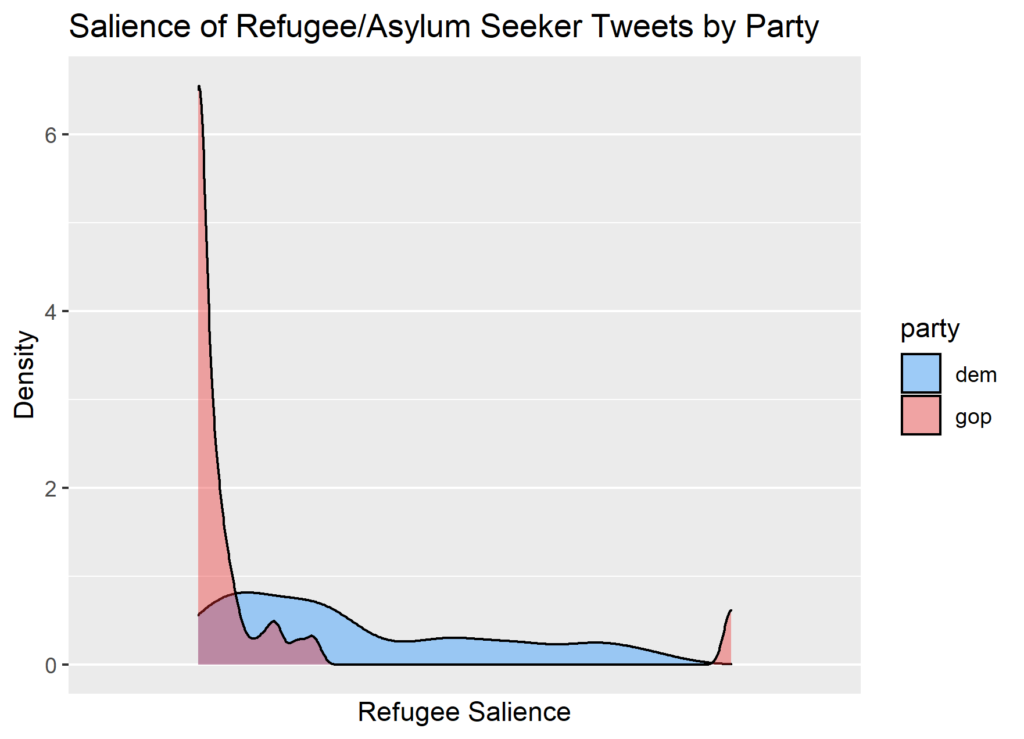
Figure A9. Semantic Network Plot: Immigrants (Democrats)
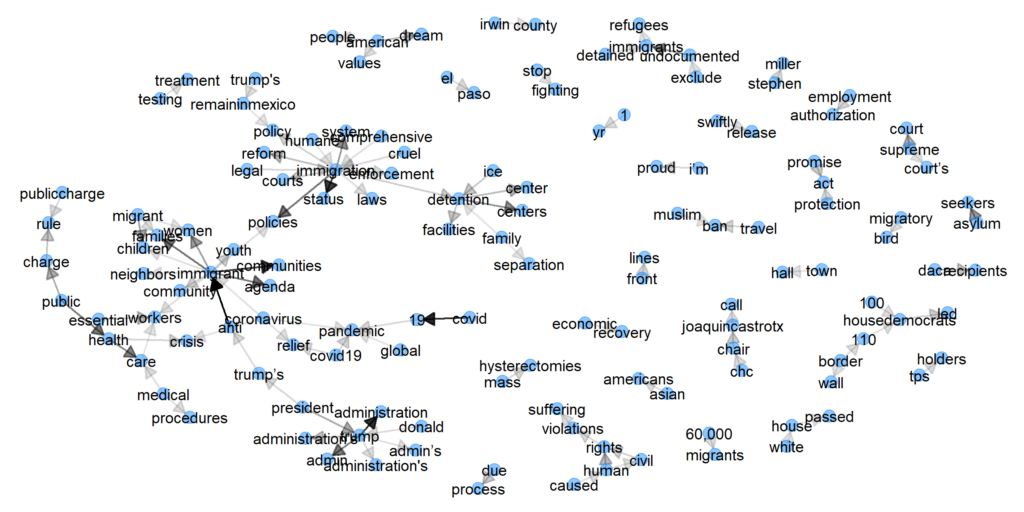
Note: The figure plots the most common connections between words among legislators’ tweets. Stronger connections between words are denoted by darker arrows.
Figure A10. Semantic Network Plot: Immigrants (Republicans)
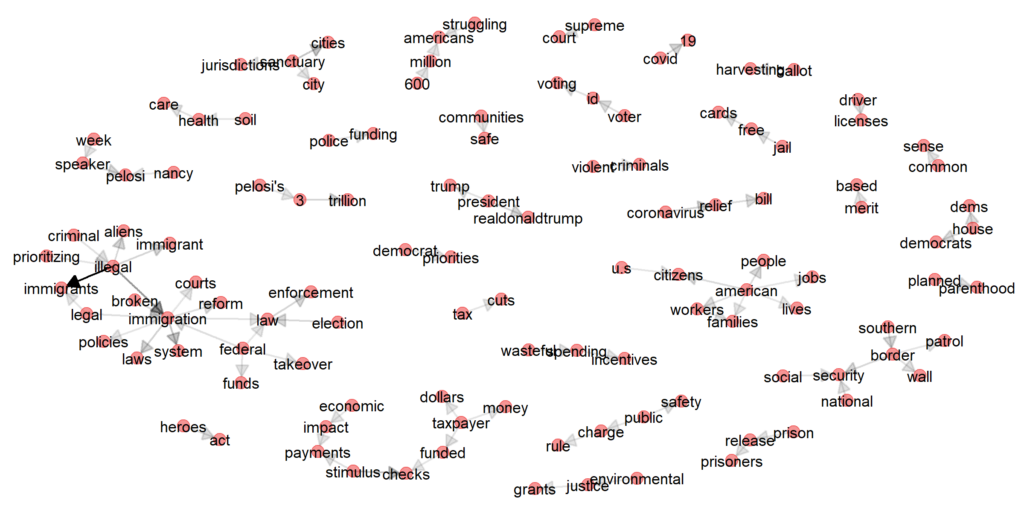
Note: The figure plots the most common connections between words among legislators’ tweets. Stronger connections between words are denoted by darker arrows.
Figure A11. Semantic Network Plot: Refugees (Democrats)
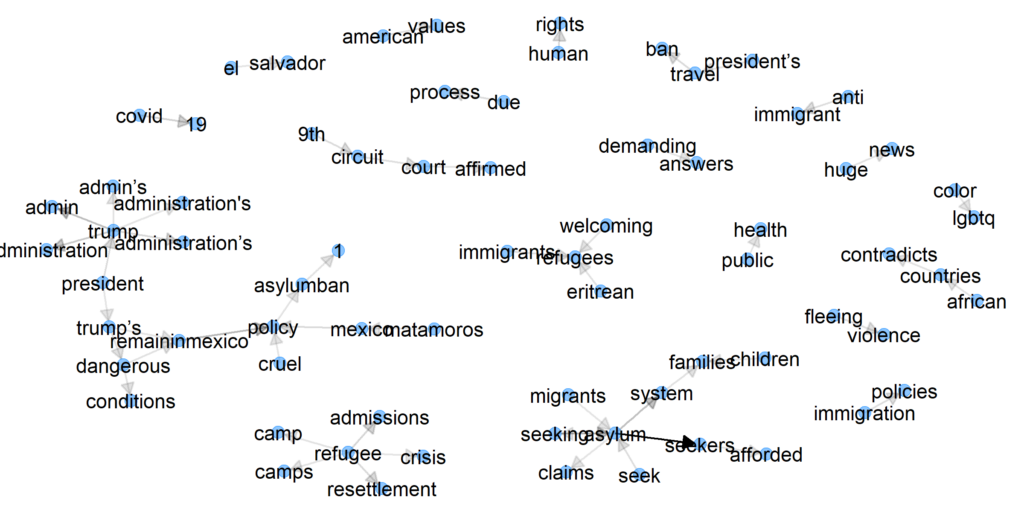
Note: The figure plots the most common connections between words among legislators’ tweets. Stronger connections between words are denoted by darker arrows.
Figure A12. Semantic Network Plot: Refugees (Republicans)
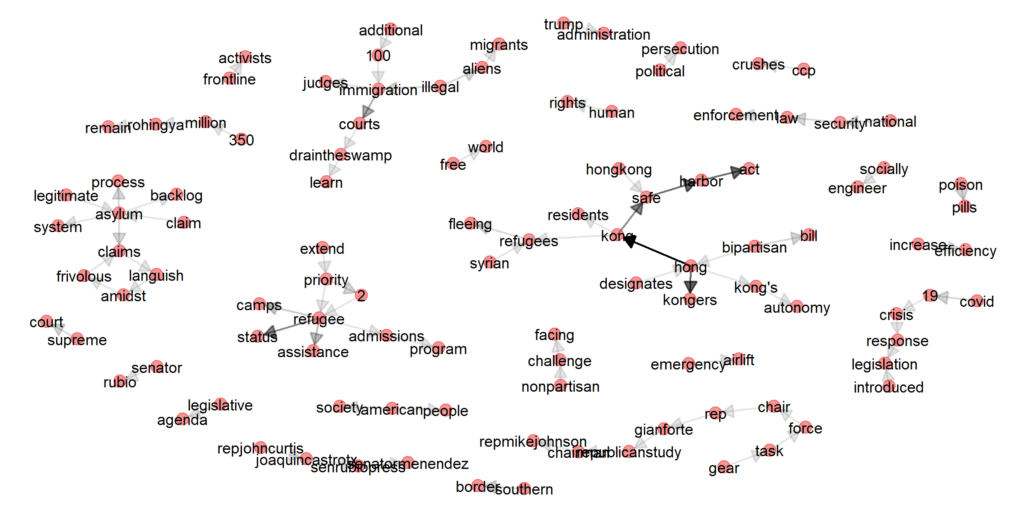
Note: The figure plots the most common connections between words among legislators’ tweets. Stronger connections between words are denoted by darker arrows.
B Main Models in the Manuscript
C Robustness Checks
Figure C1. Robustness Check for Models of Republican Party Effect on Tweet Sentiment
(a) Primary versus General Election
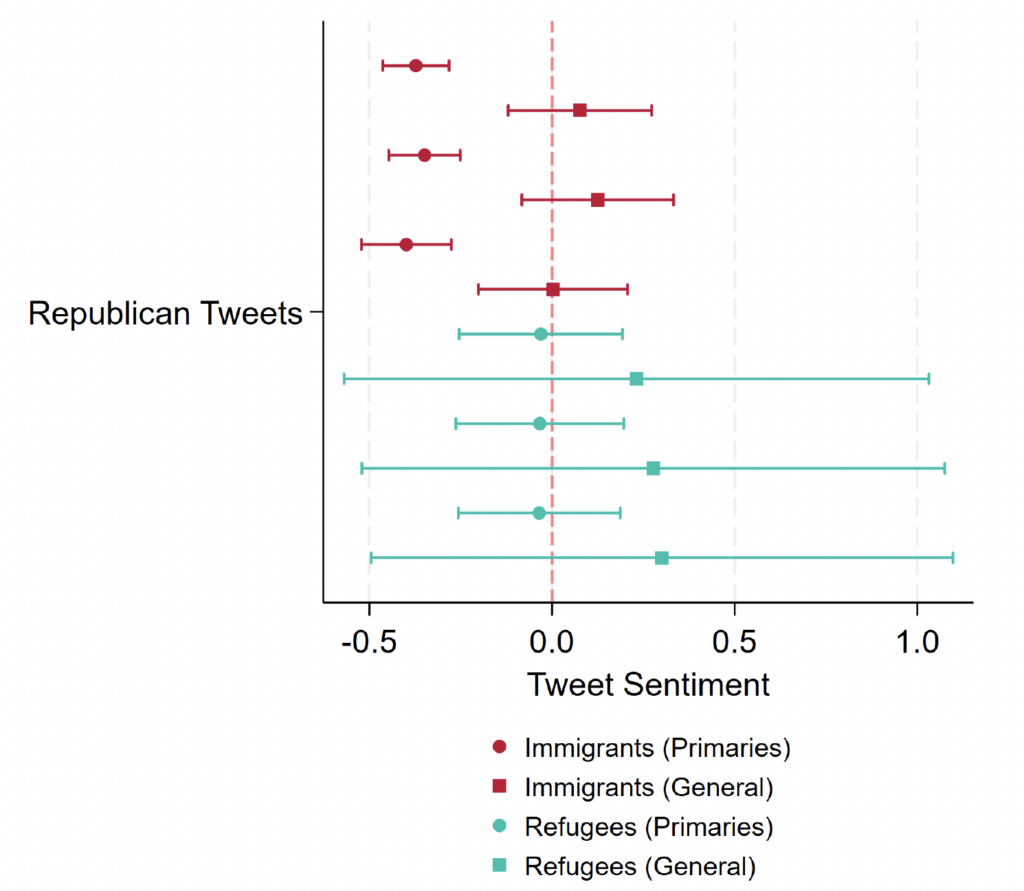
(b) Pre- and Post-Title 42
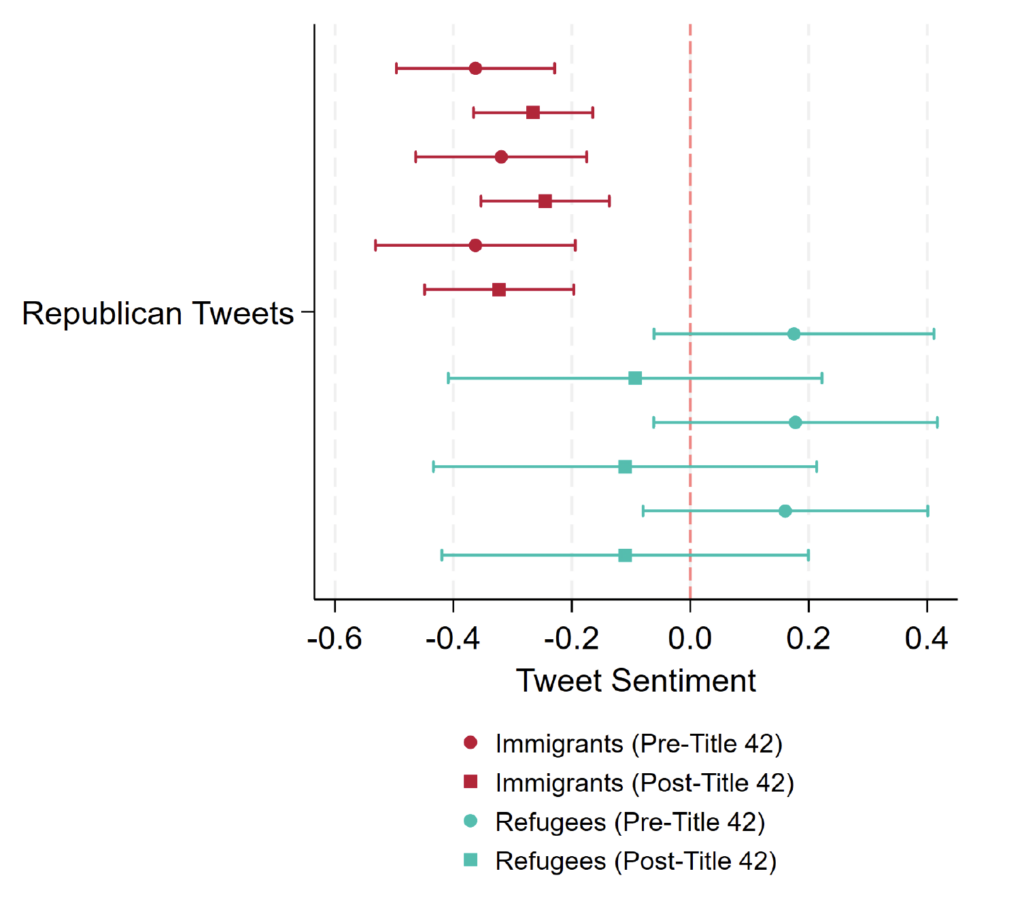
(c) Models Dropping Safe Harbor Cosponsors
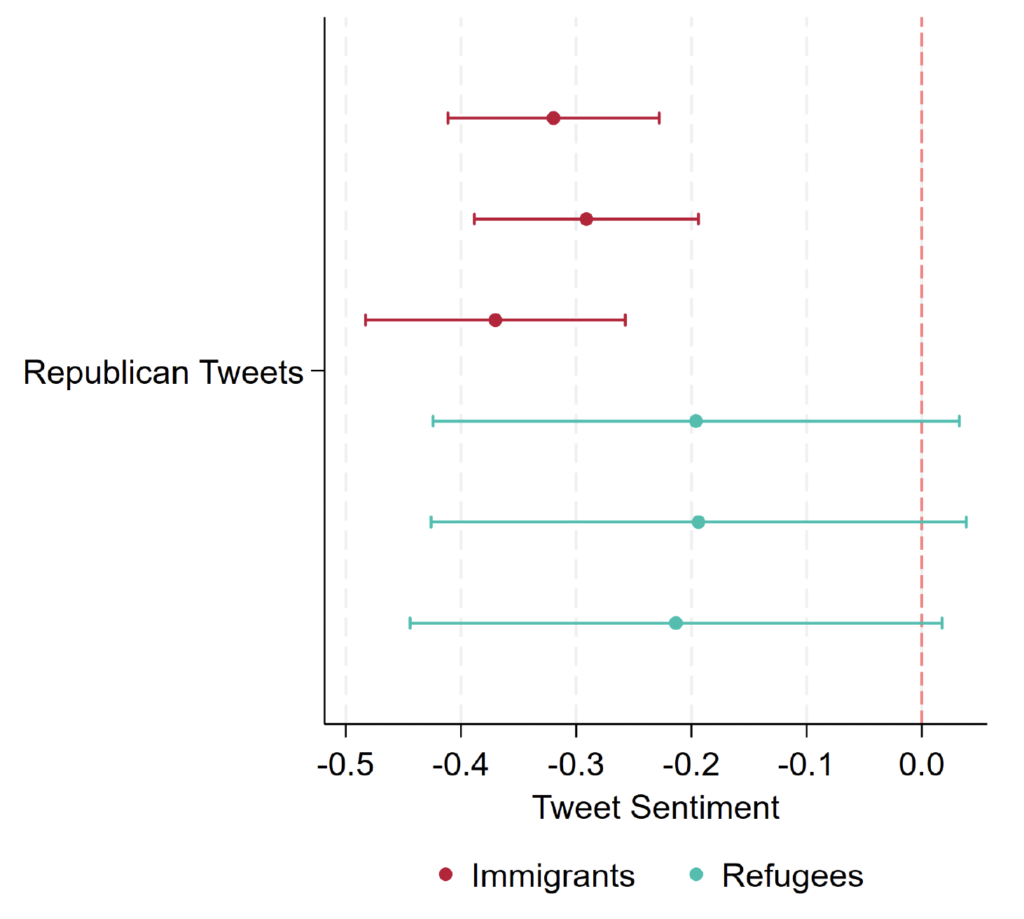
(d) Models Controlling for COVID-19 Cases per District
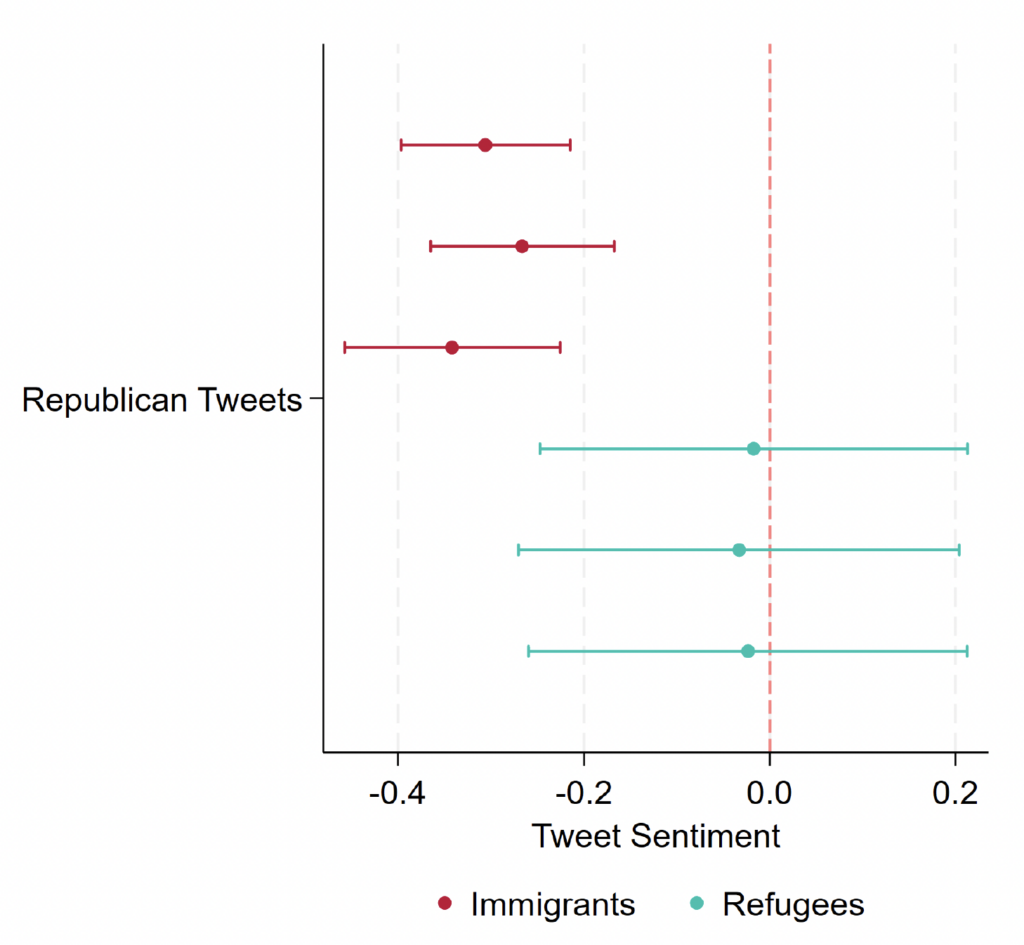
Figure C2. Effect of Party and District Characteristics on Immigrant and Refugee Salience, Dropping Cosponsors of the Hong Kong Safe Harbor Act (Based on Table C3)
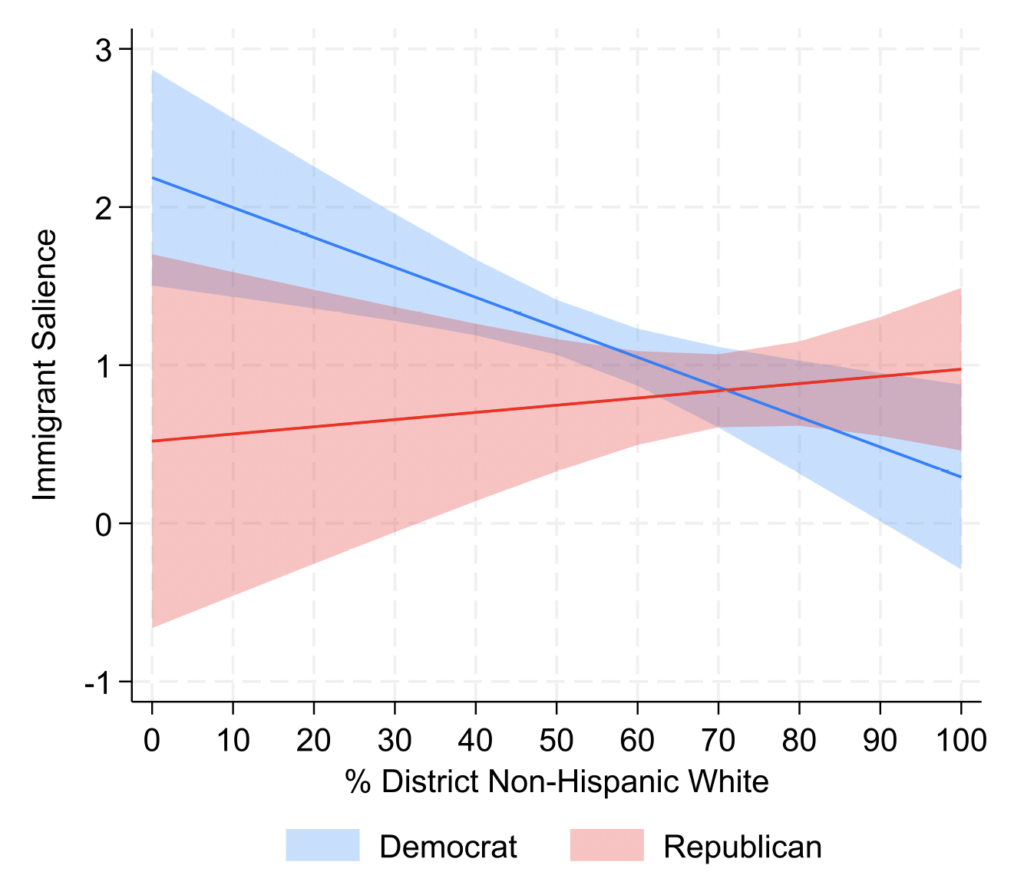
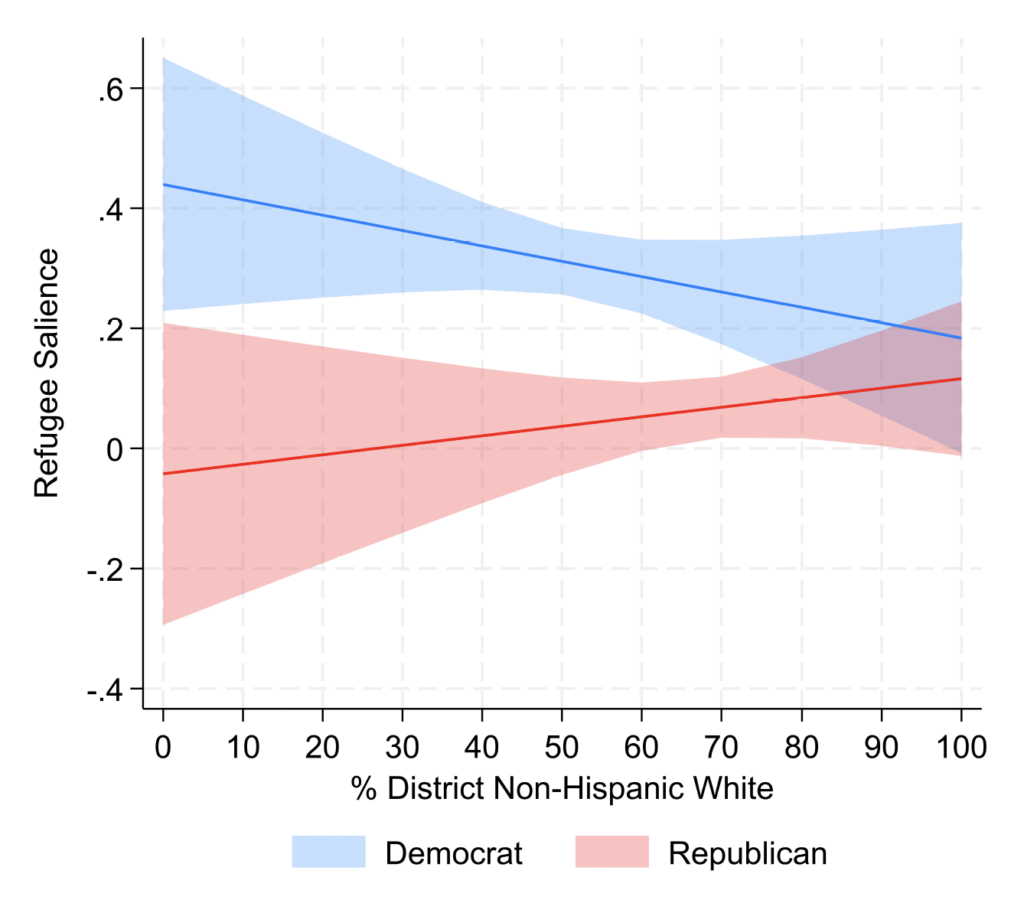
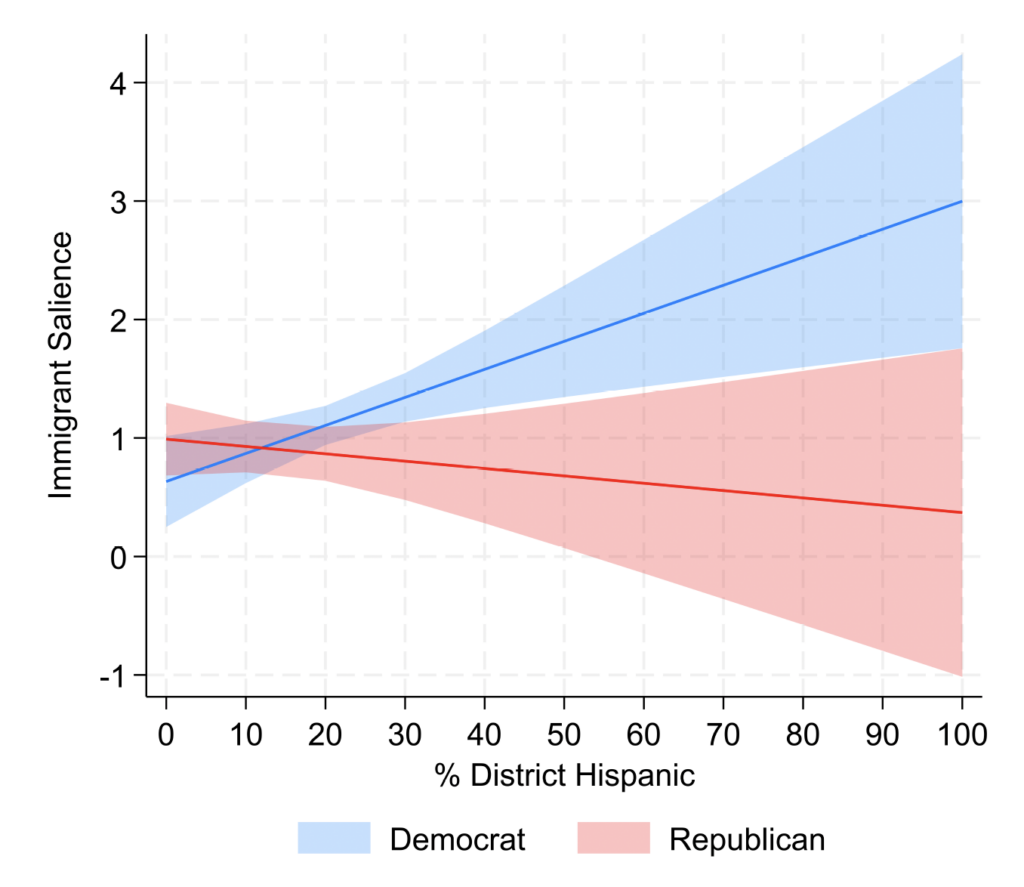
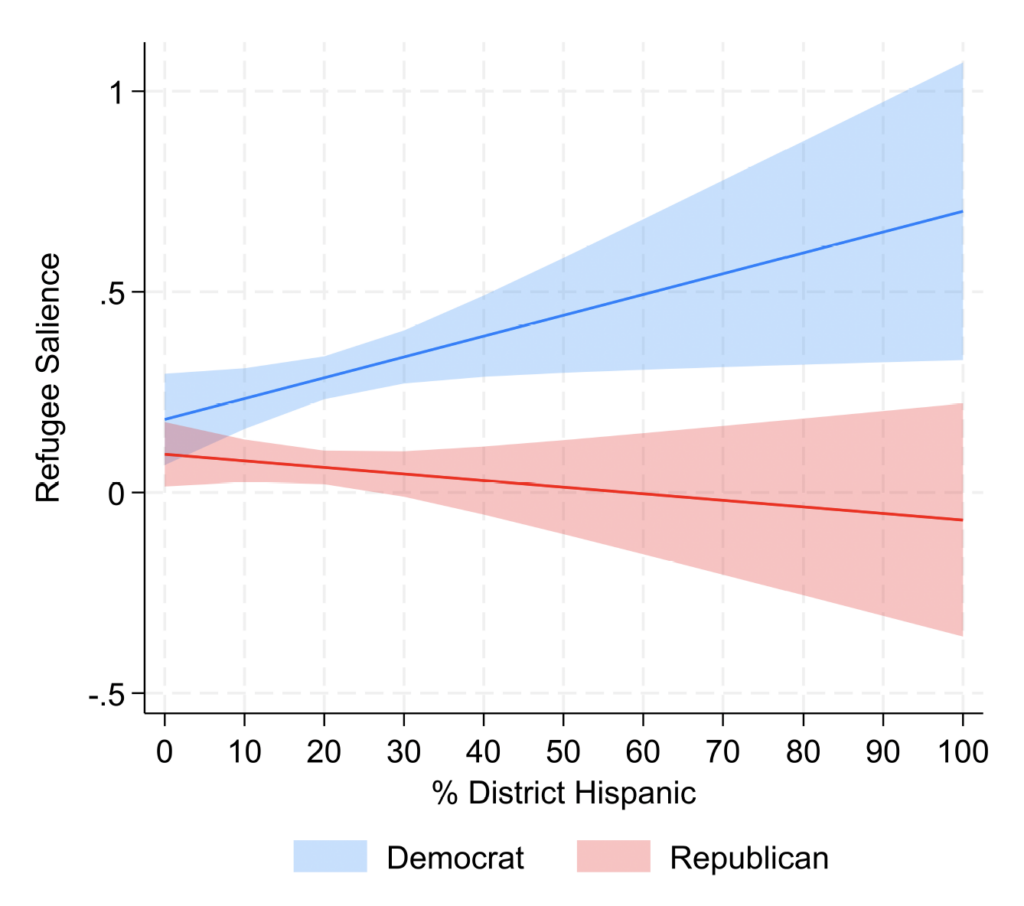
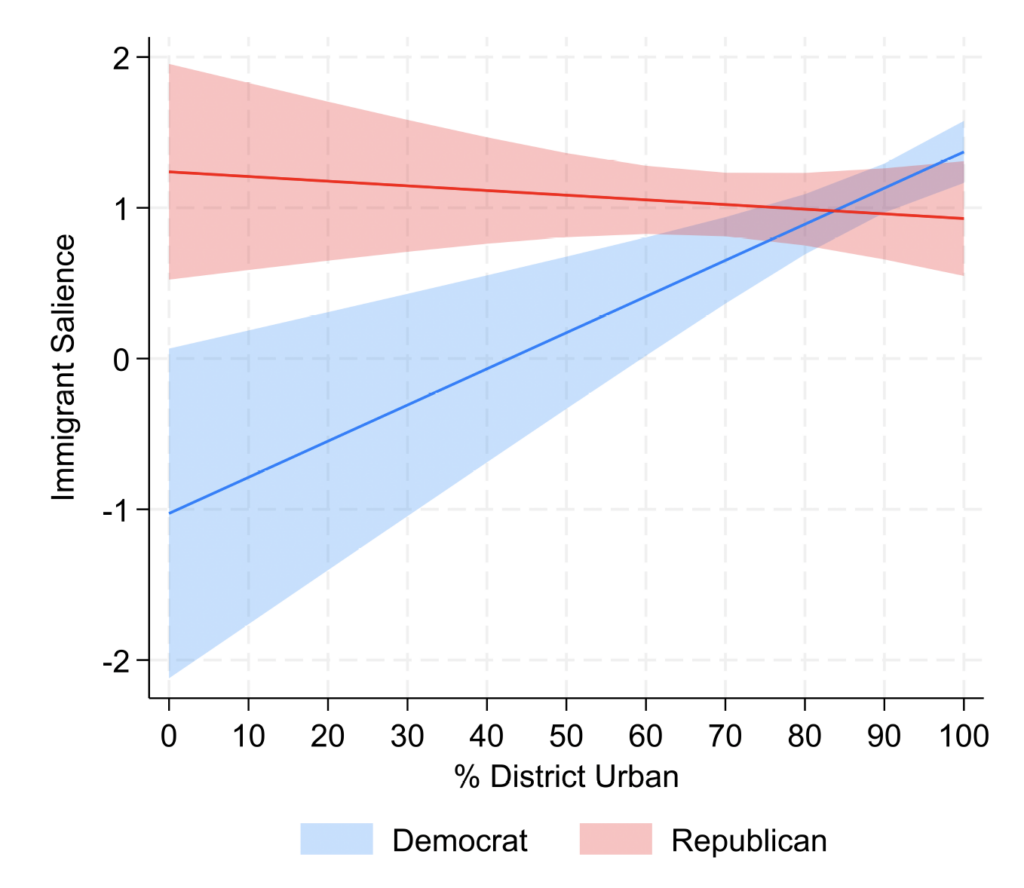
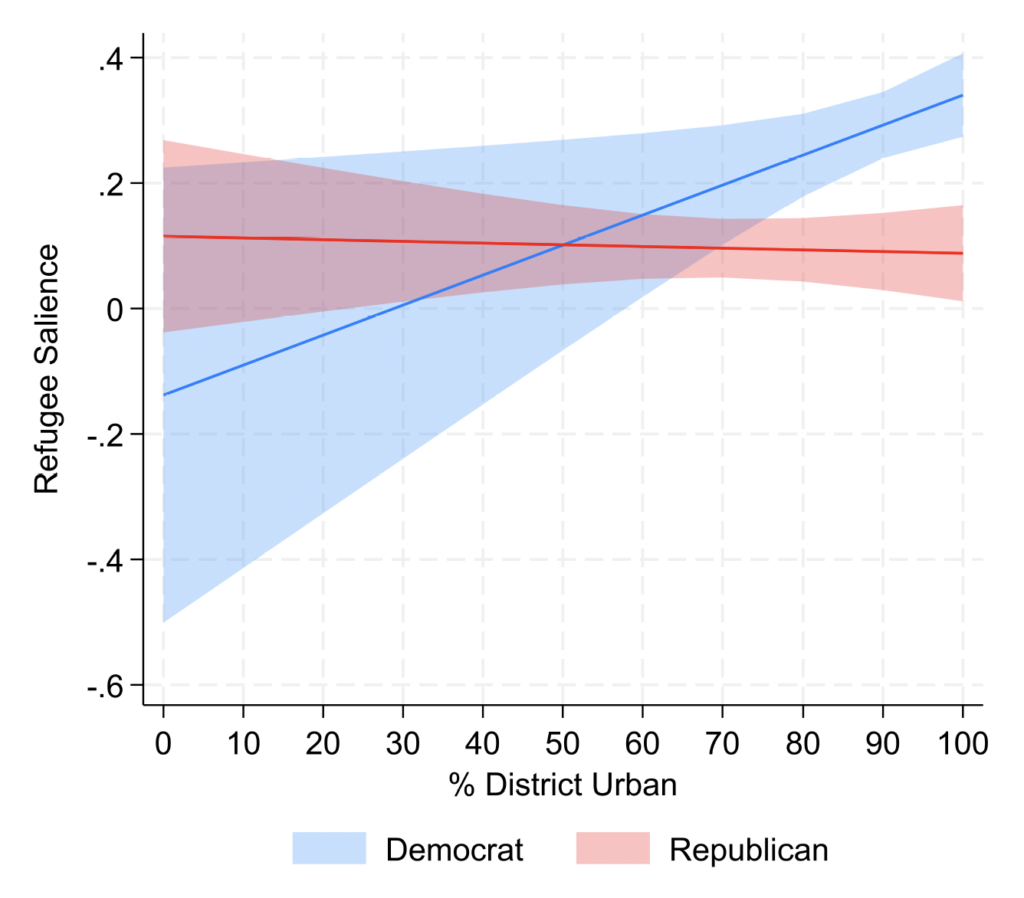
Figure C3. Figure C3. Robustness Check for Effect of Party and District Characteristics on Immigrant Salience: Pre- and Post-Title 42 (Based on Table C4)
(a) Pre-Title 42
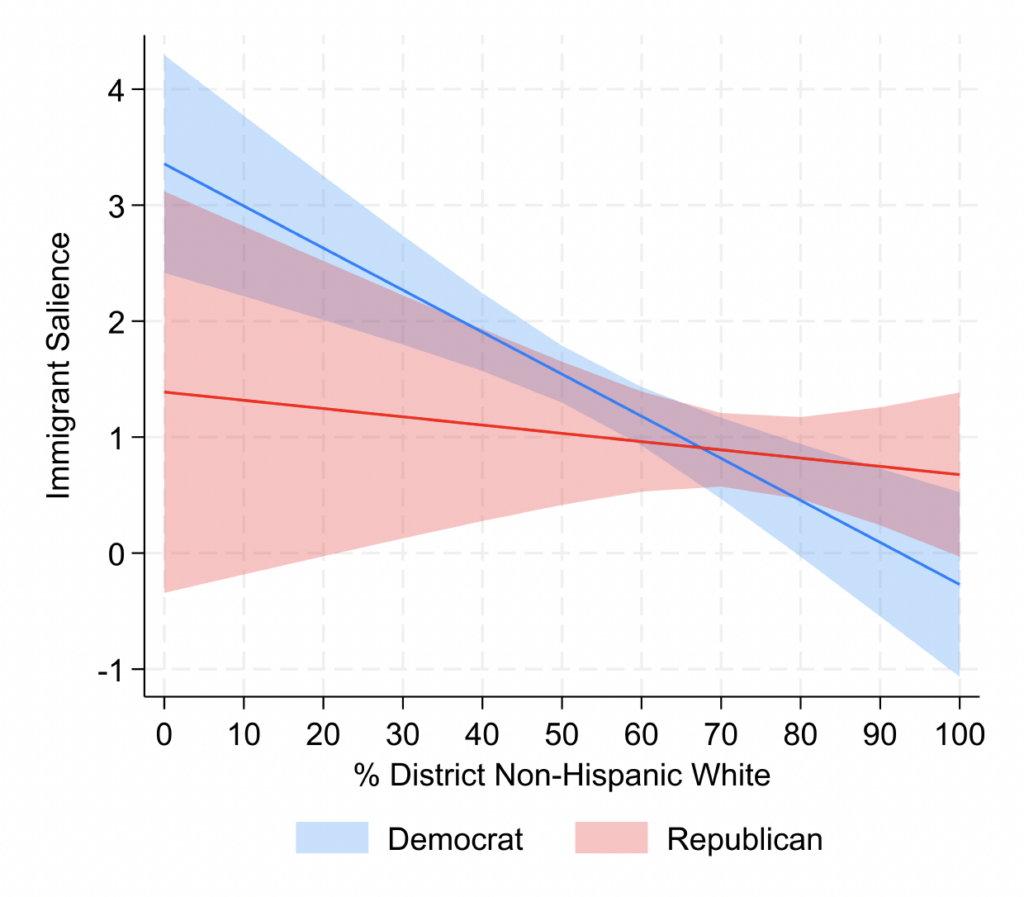
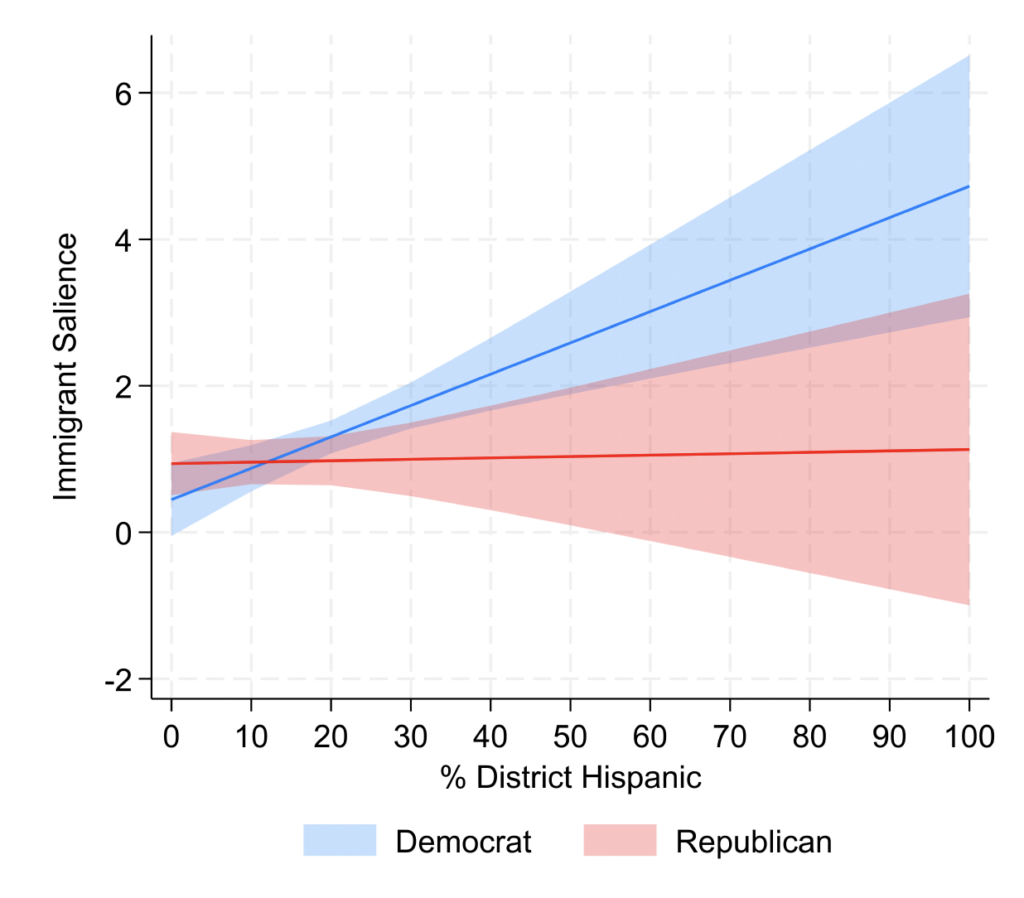
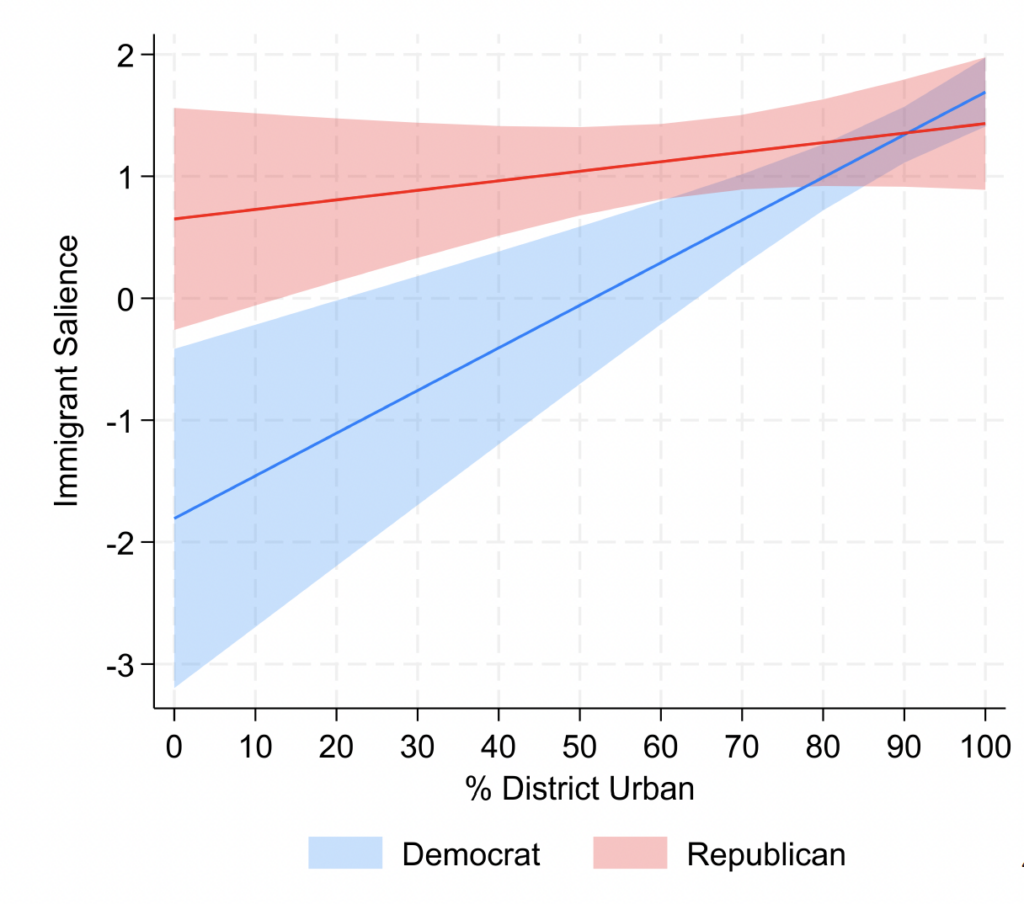
(b) Post-Title 42
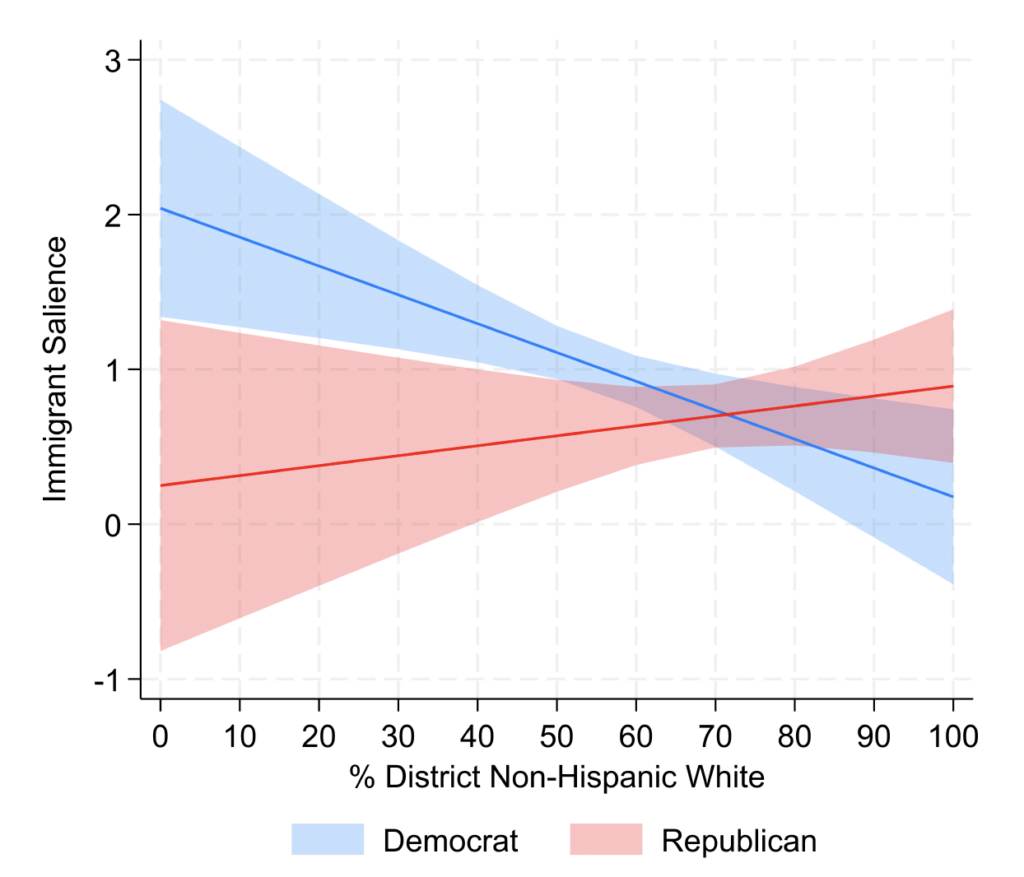
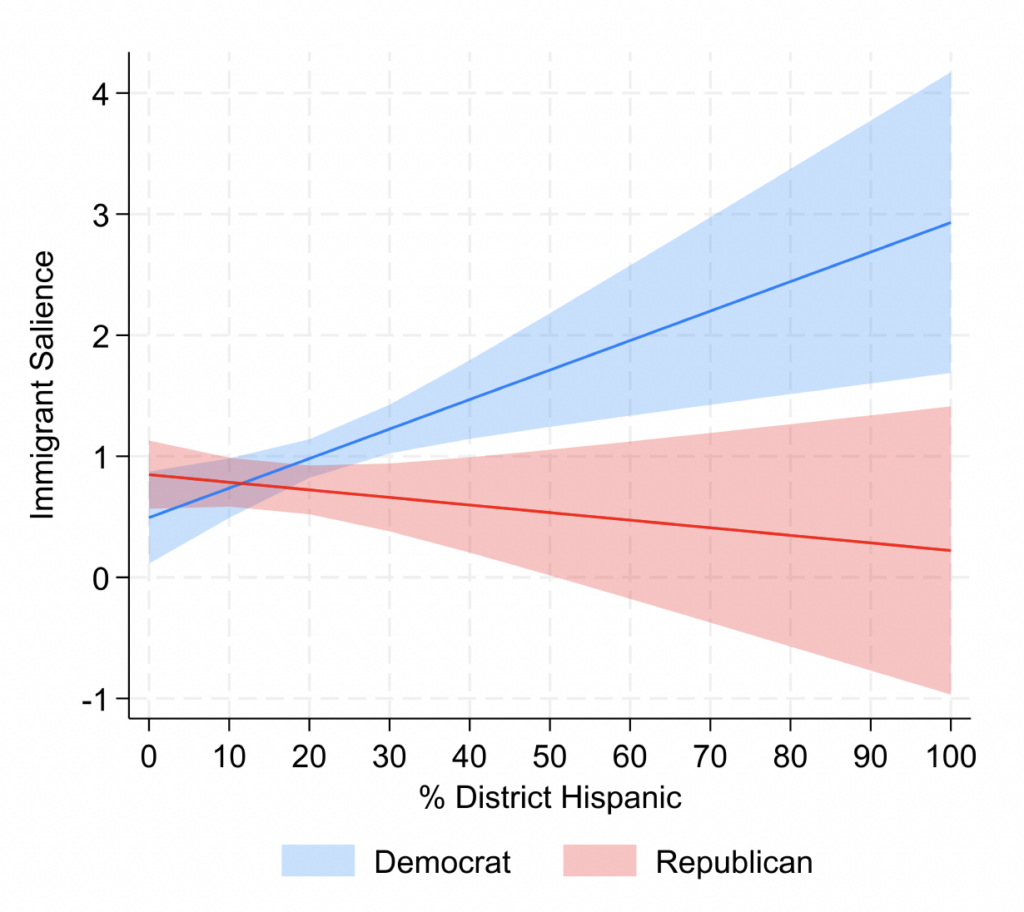
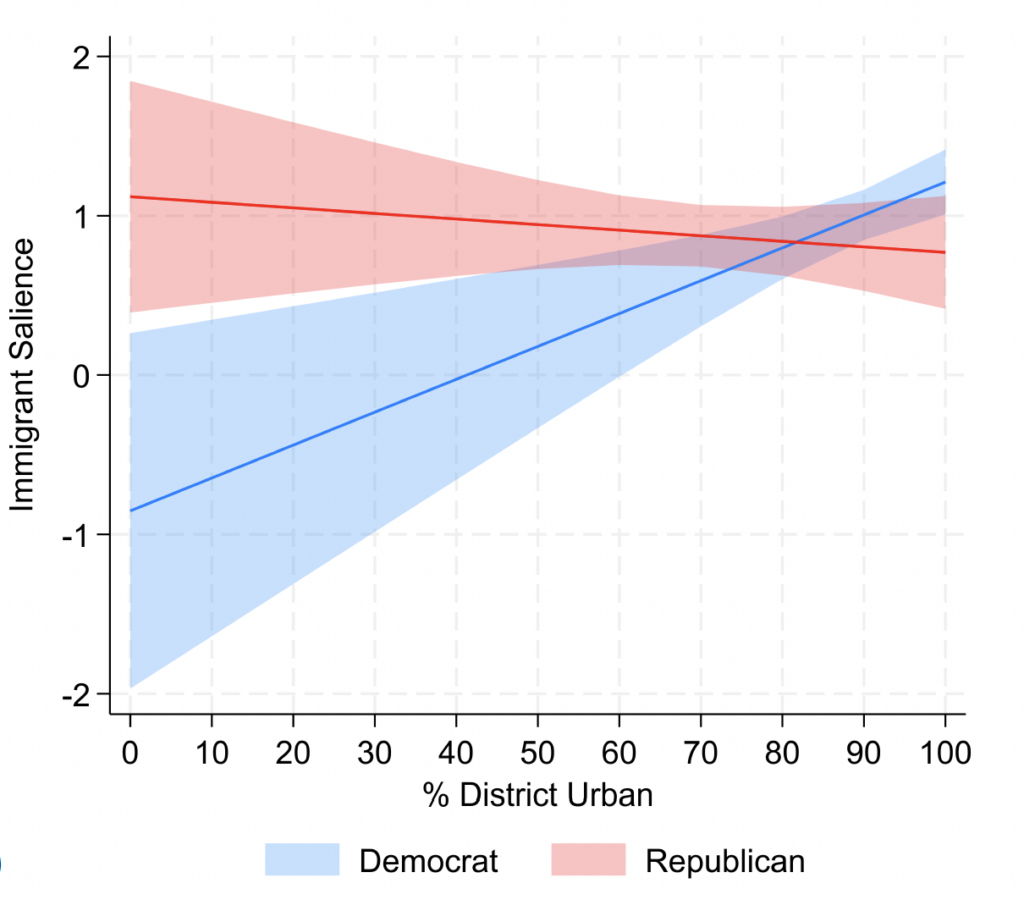
Figure C4. Robustness Check for Effect of Party and District Characteristics on Refugee Salience: Pre- and Post-Title 42 (Based on Table C5)
(a) Pre-Title 42
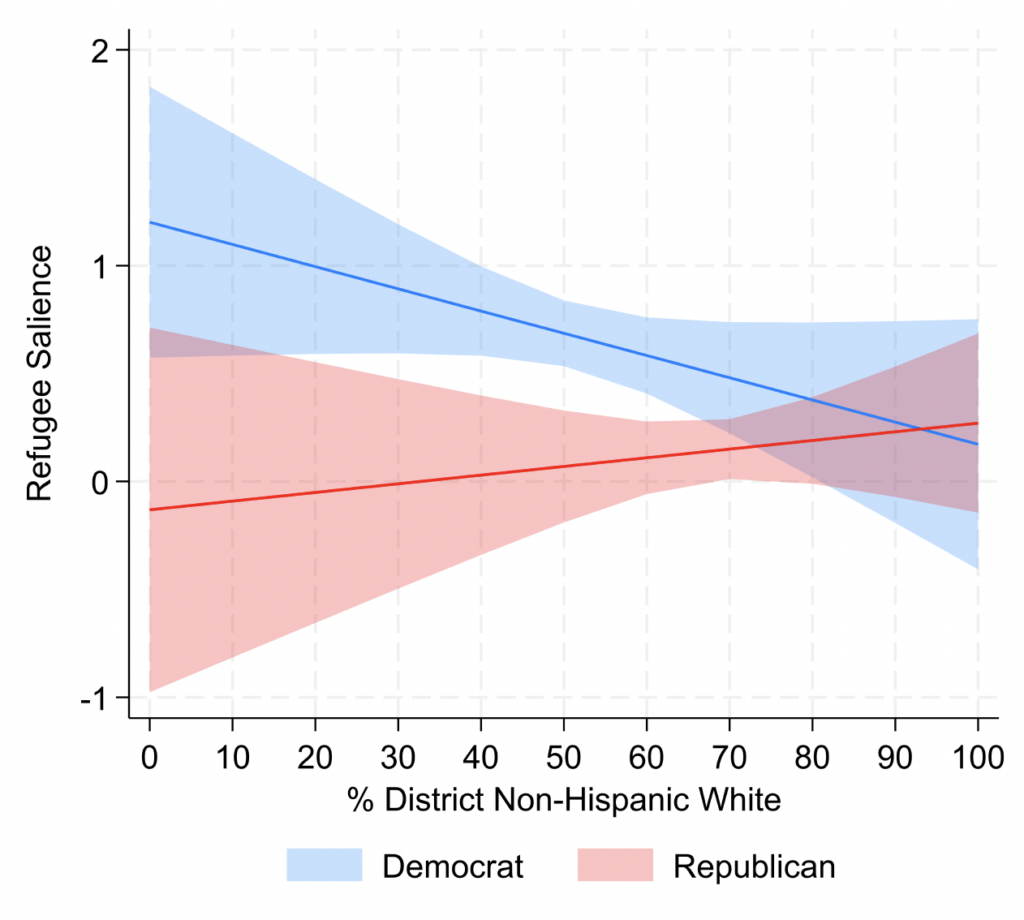
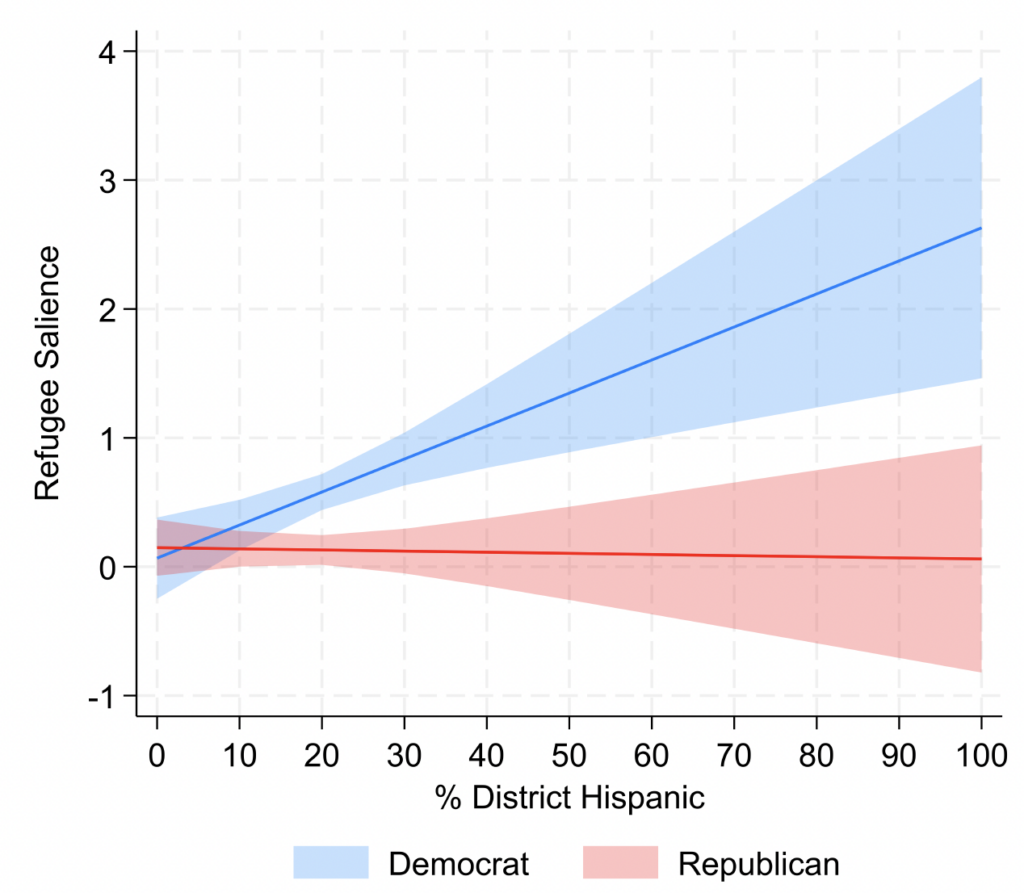
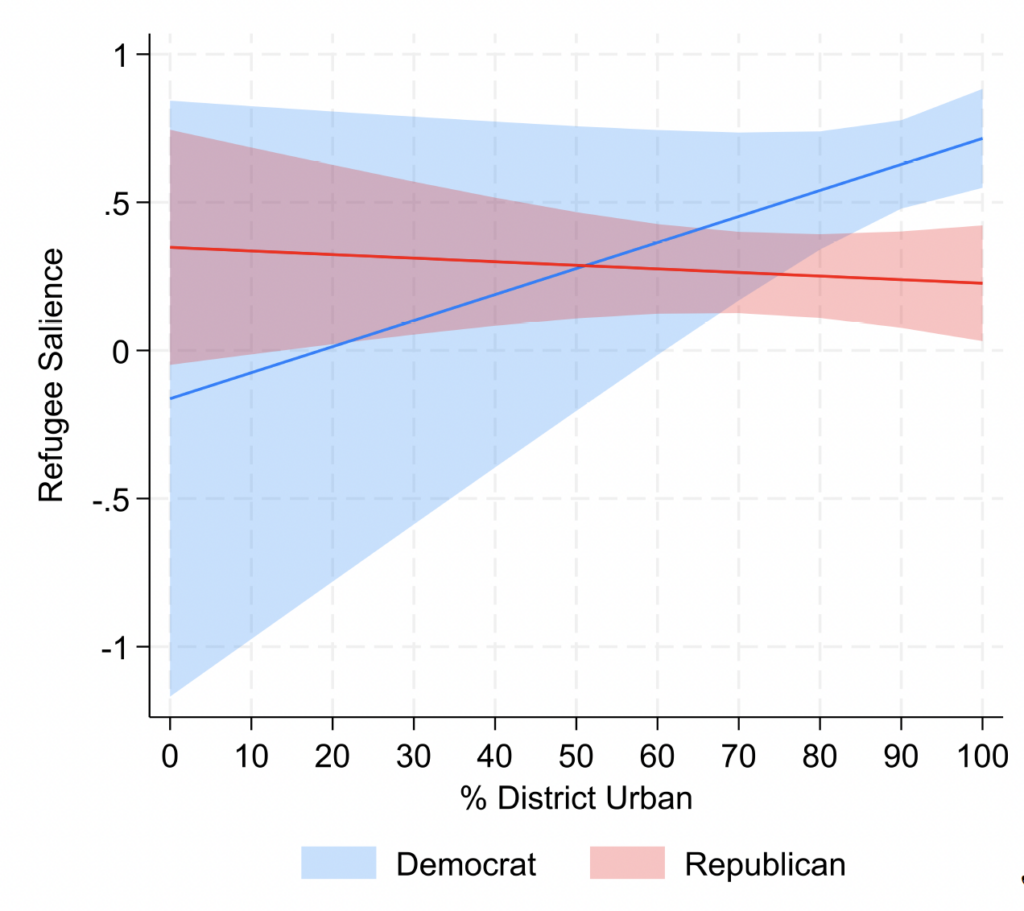
(b) Post-Title 42
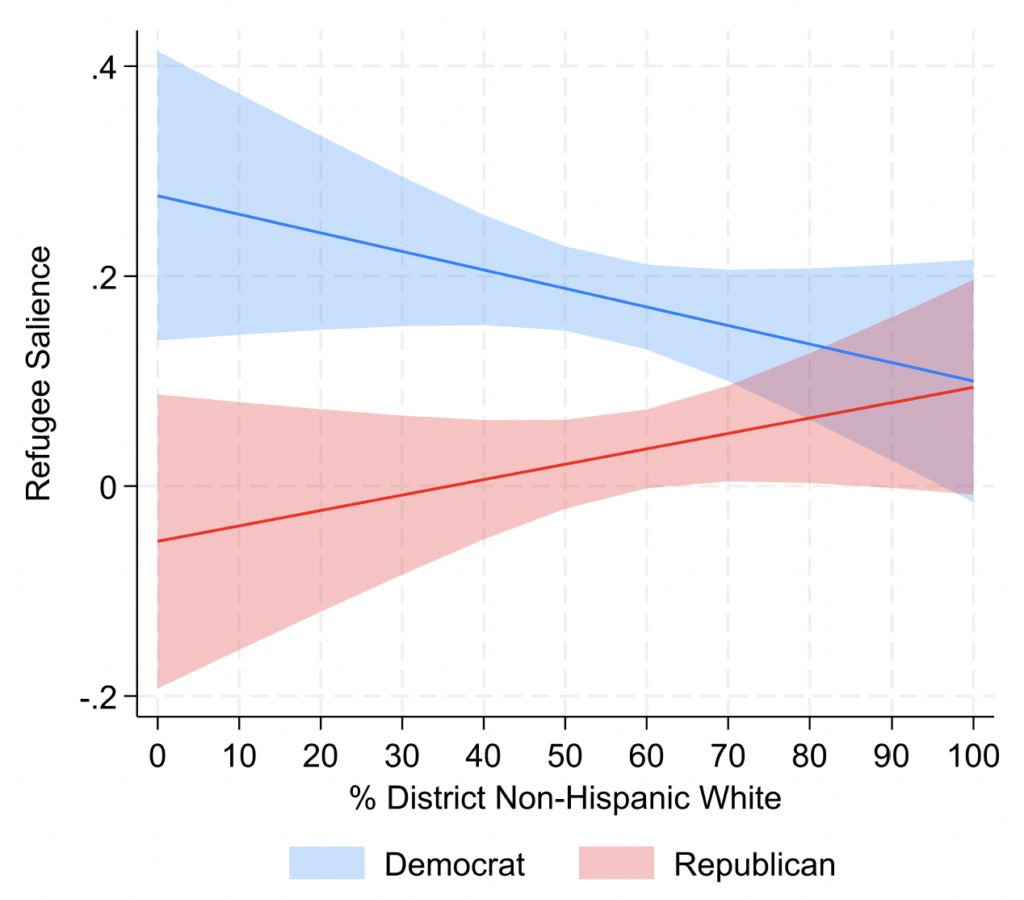
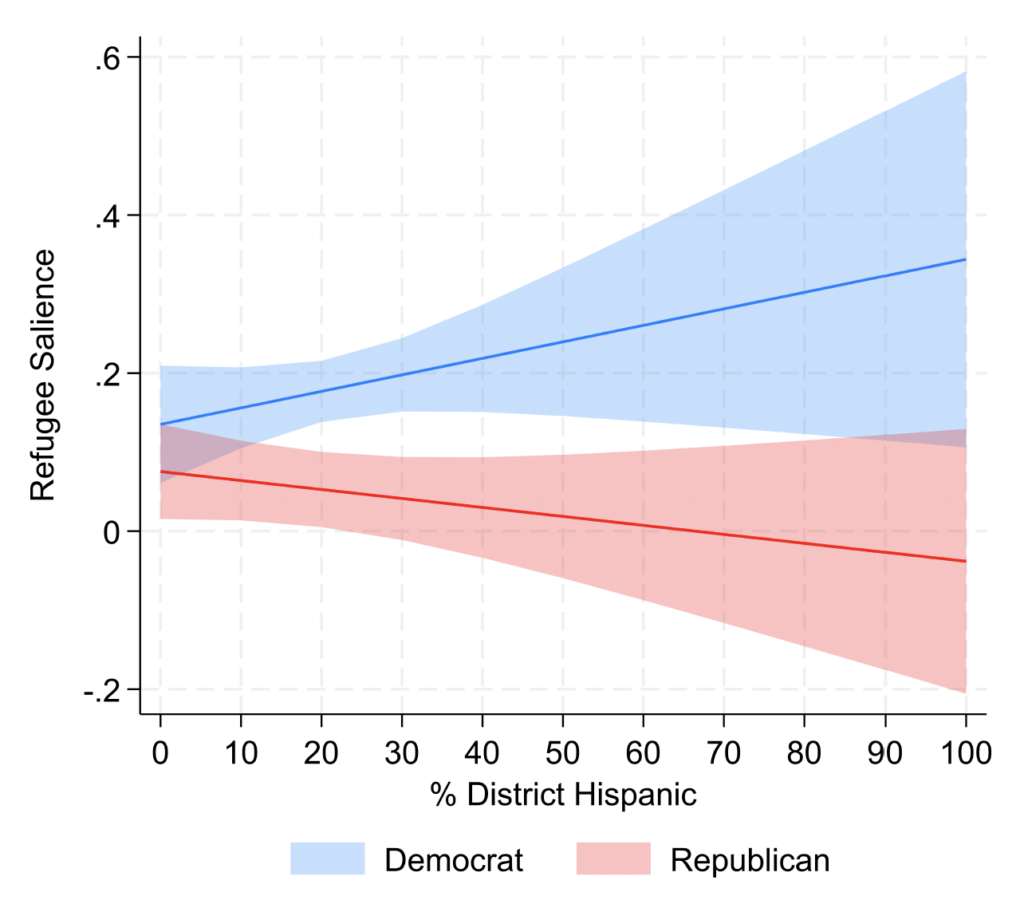
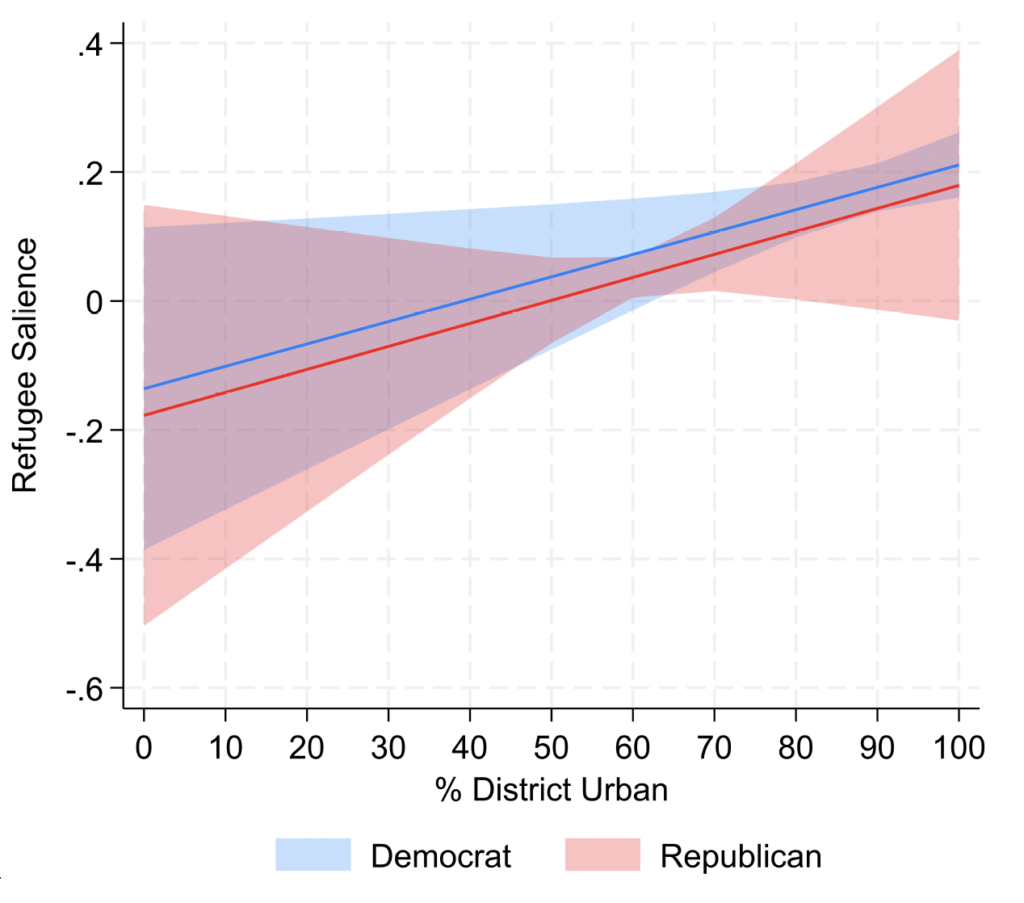
Figure C5. Robustness Check for Effect of Party and District Characteristics on Immigrant Salience: Primaries versus General Election (Based on Table C6)
(a) Primaries
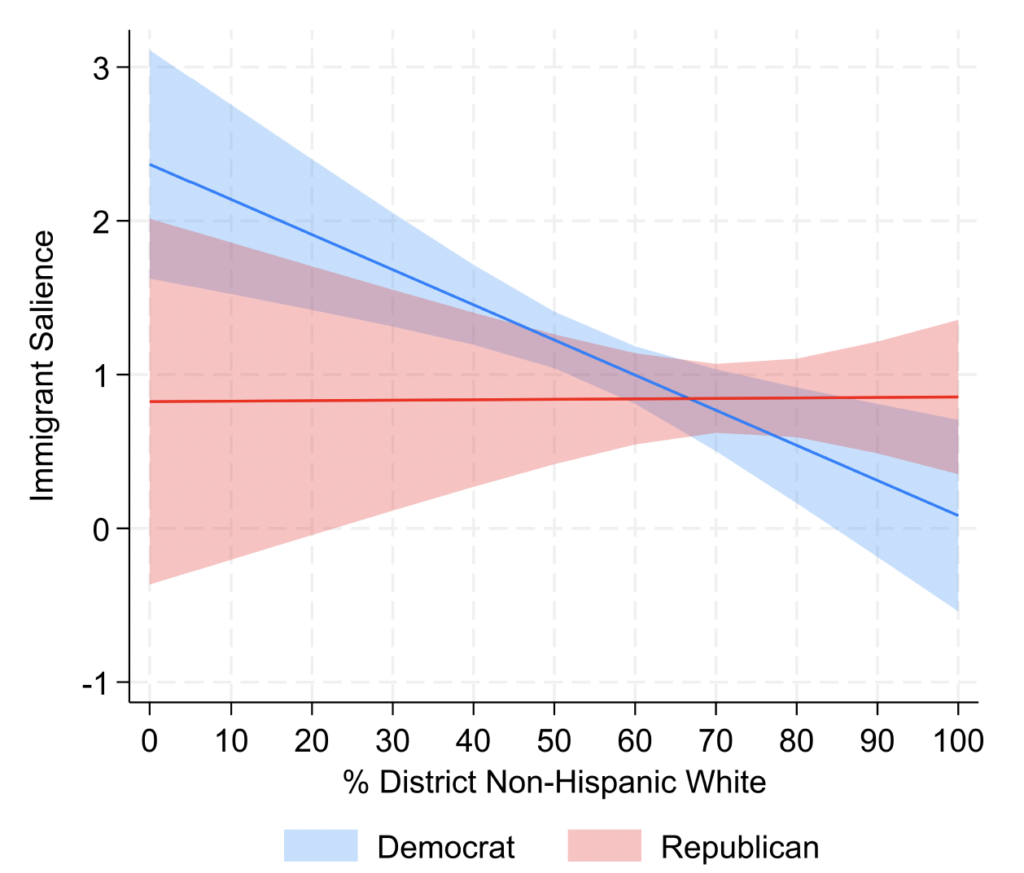
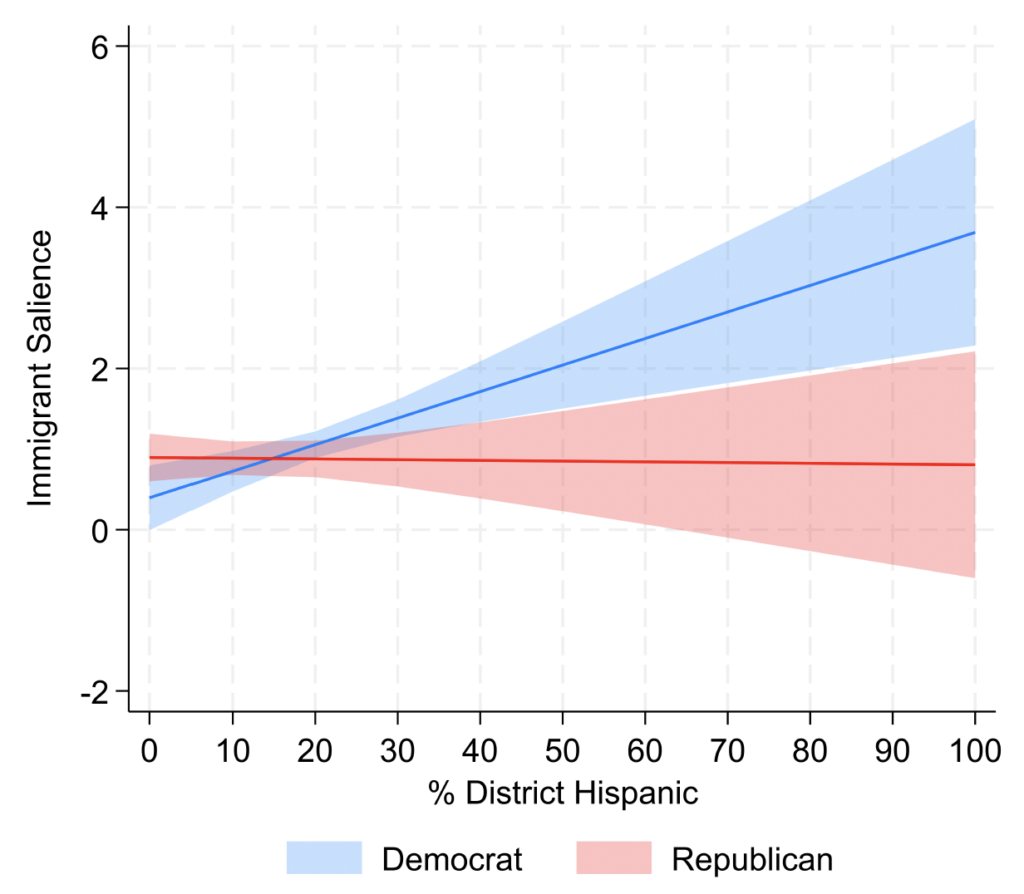
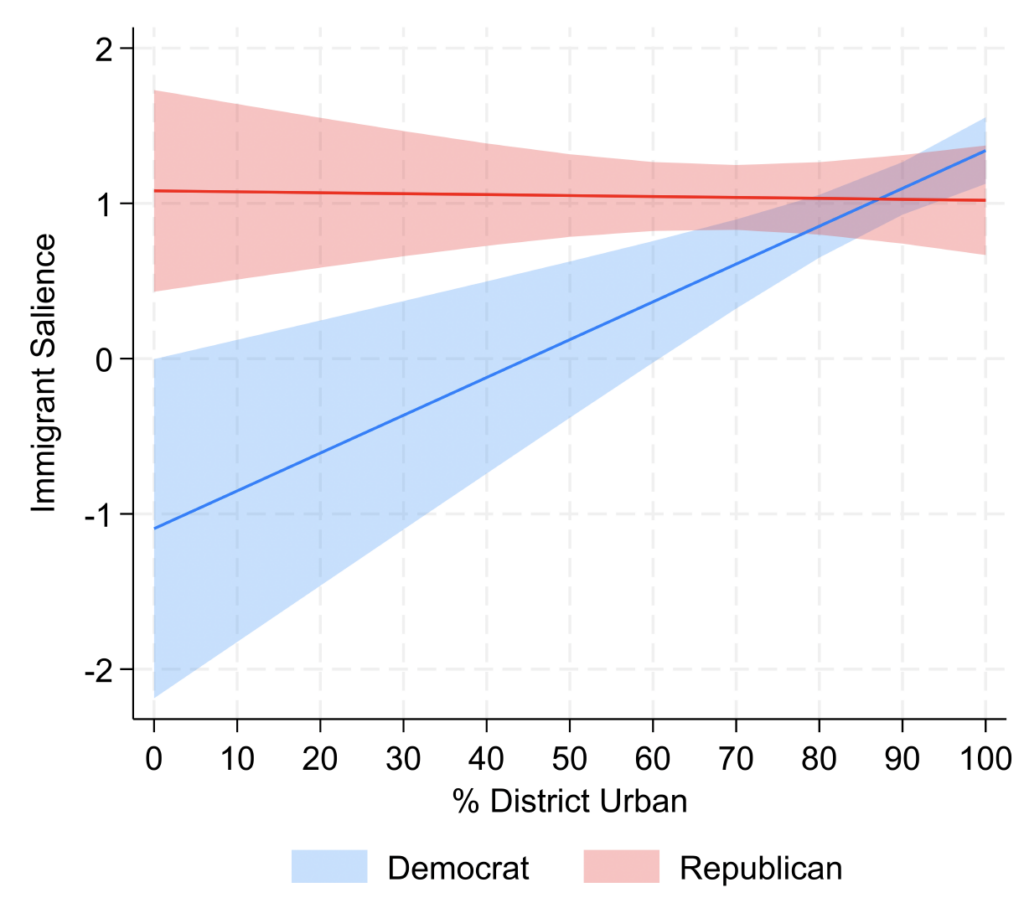
(b) General Election
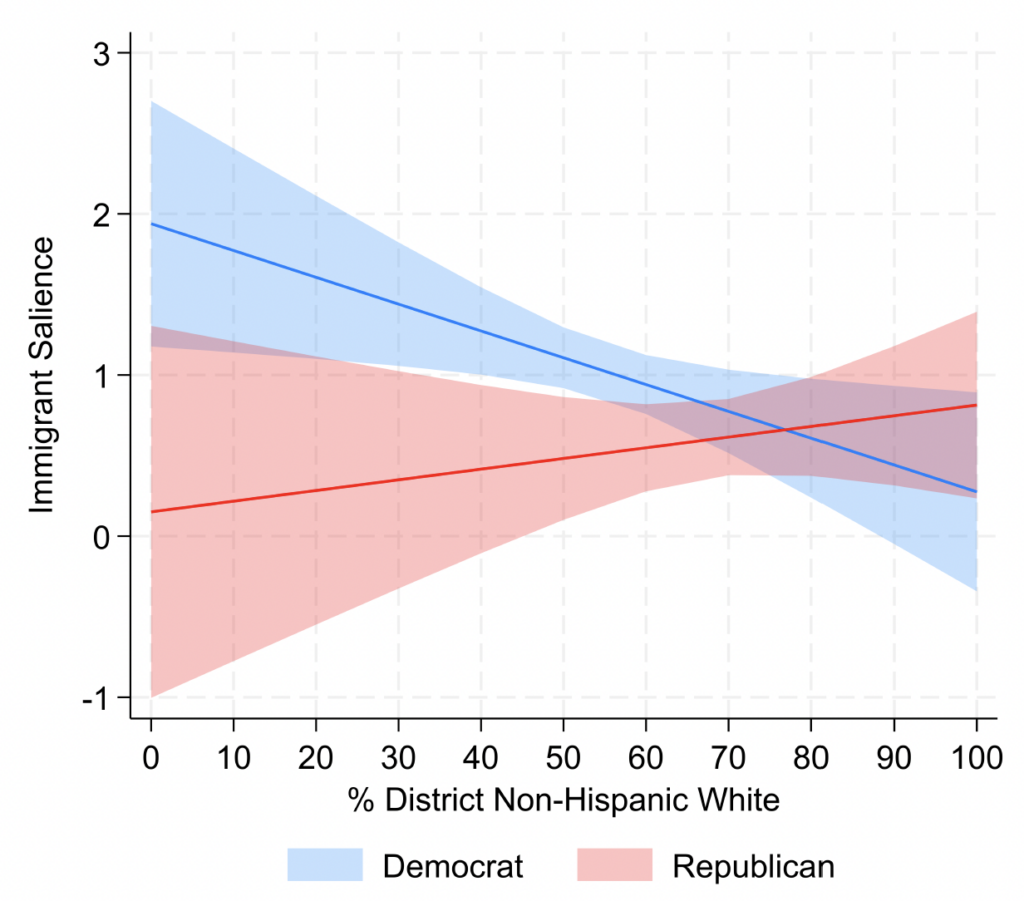
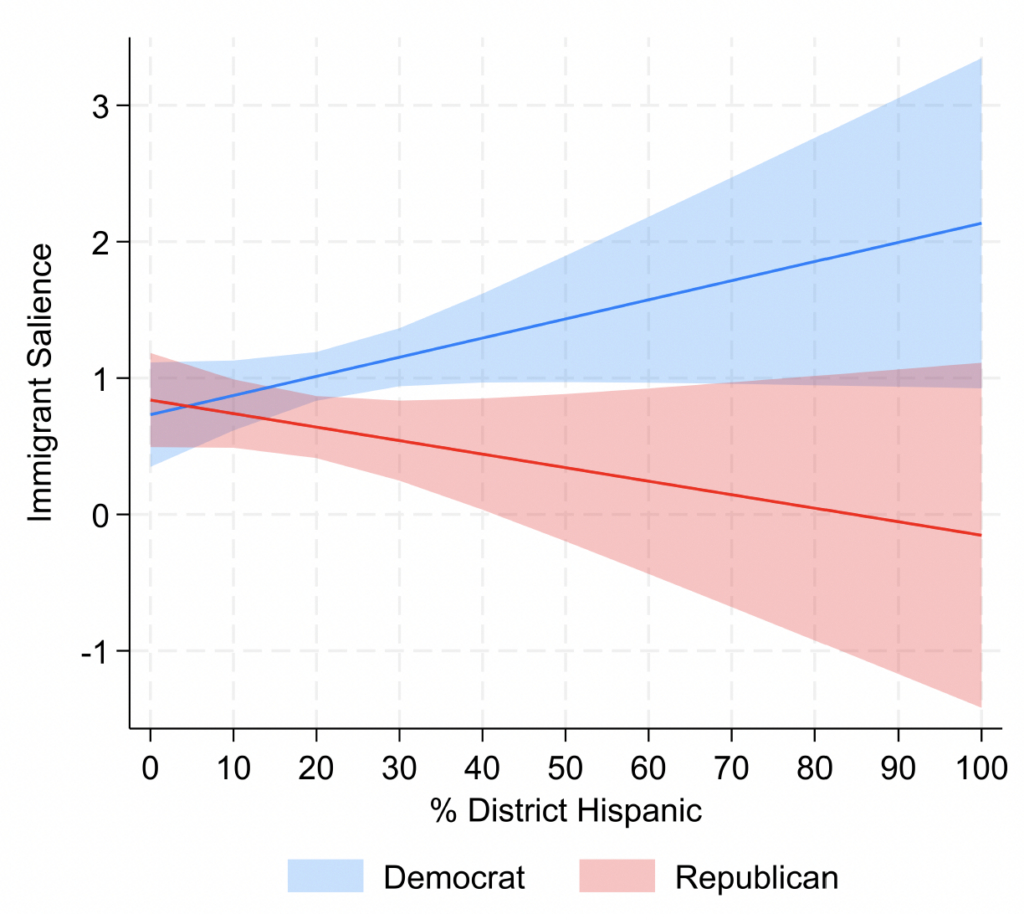
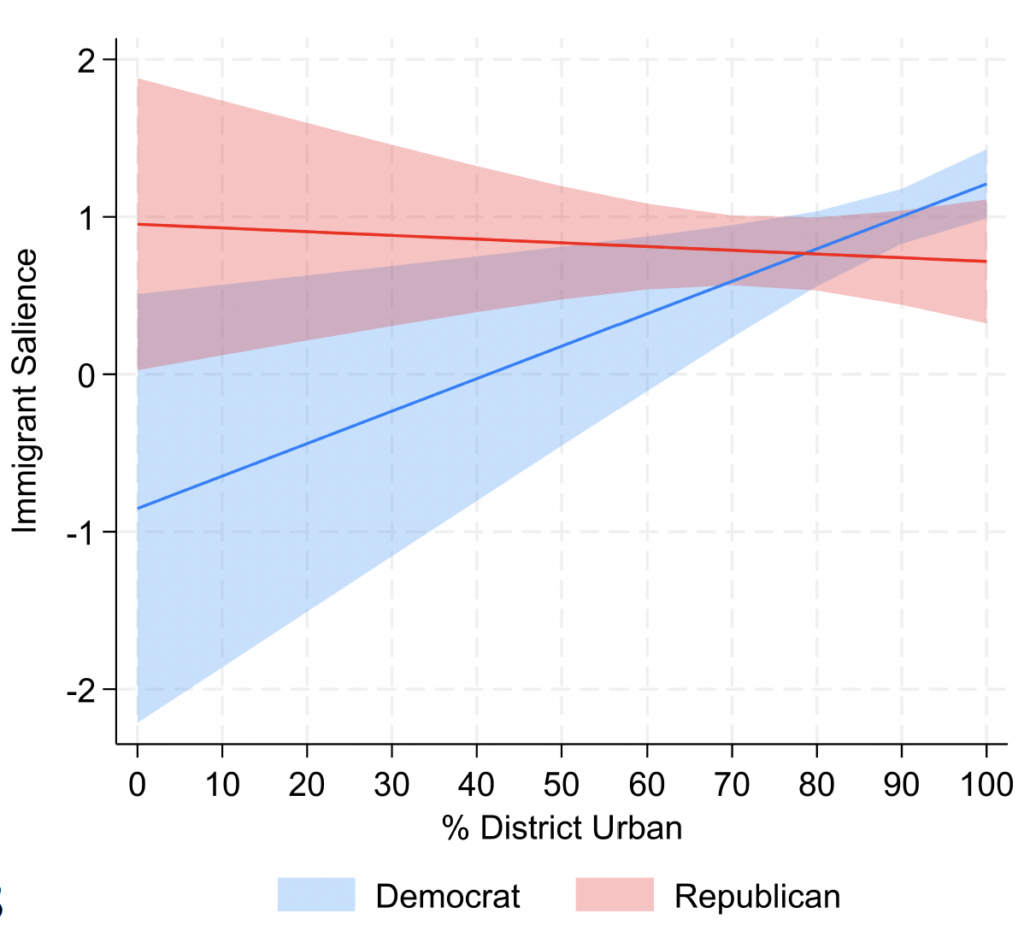
Figure C6. Robustness Check for Effect of Party and District Characteristics on Refugee Salience: Primaries versus General Election (Based on Table C7)
(a) Primaries
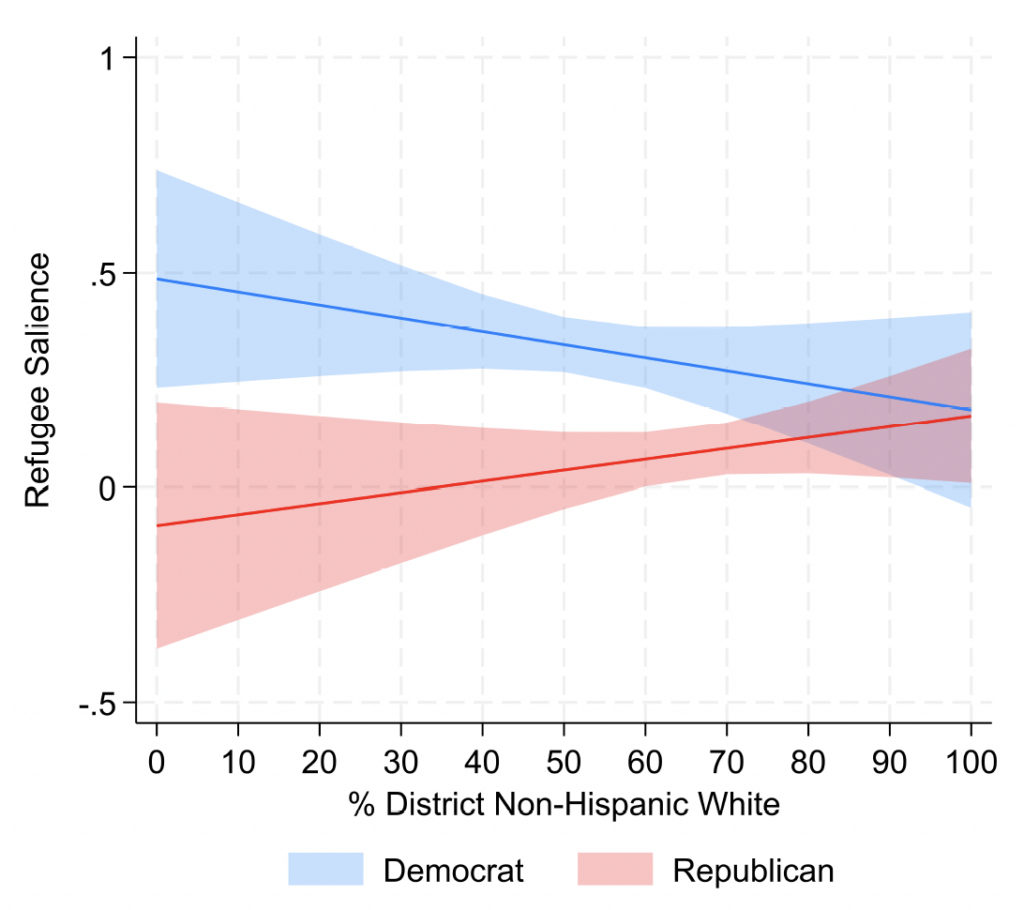
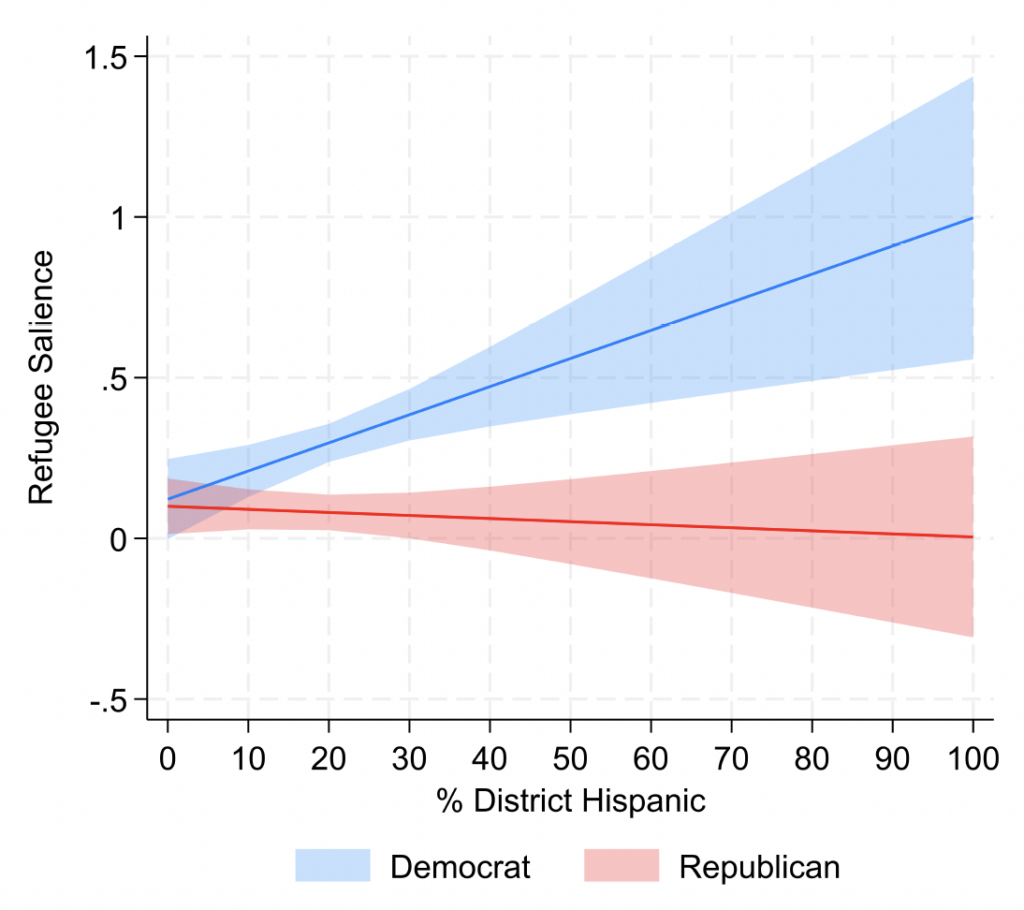
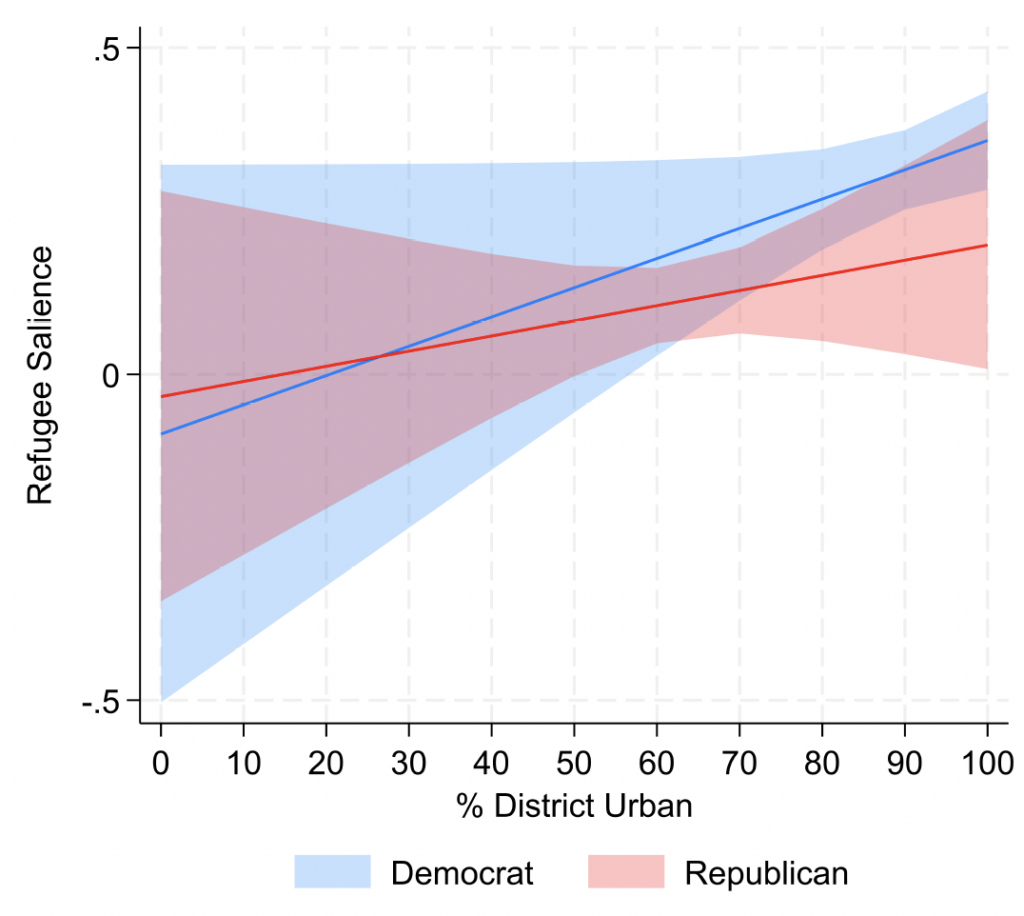
(b) General Election
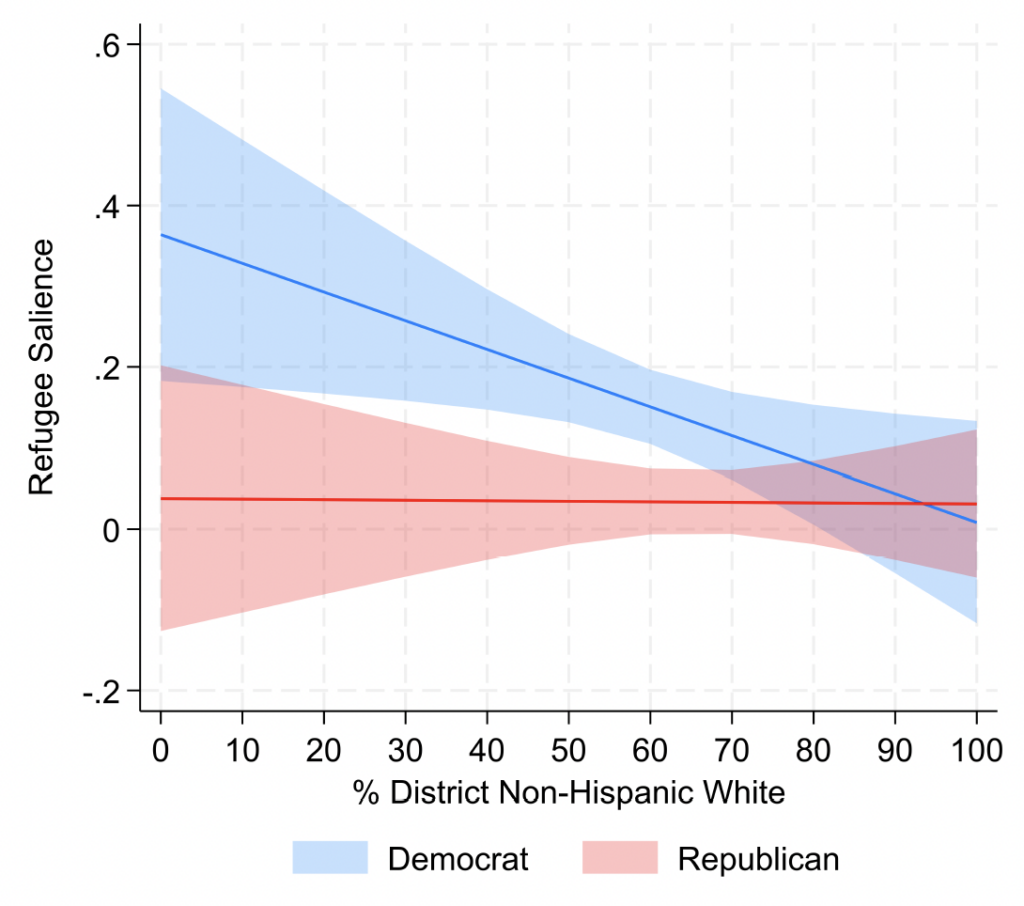
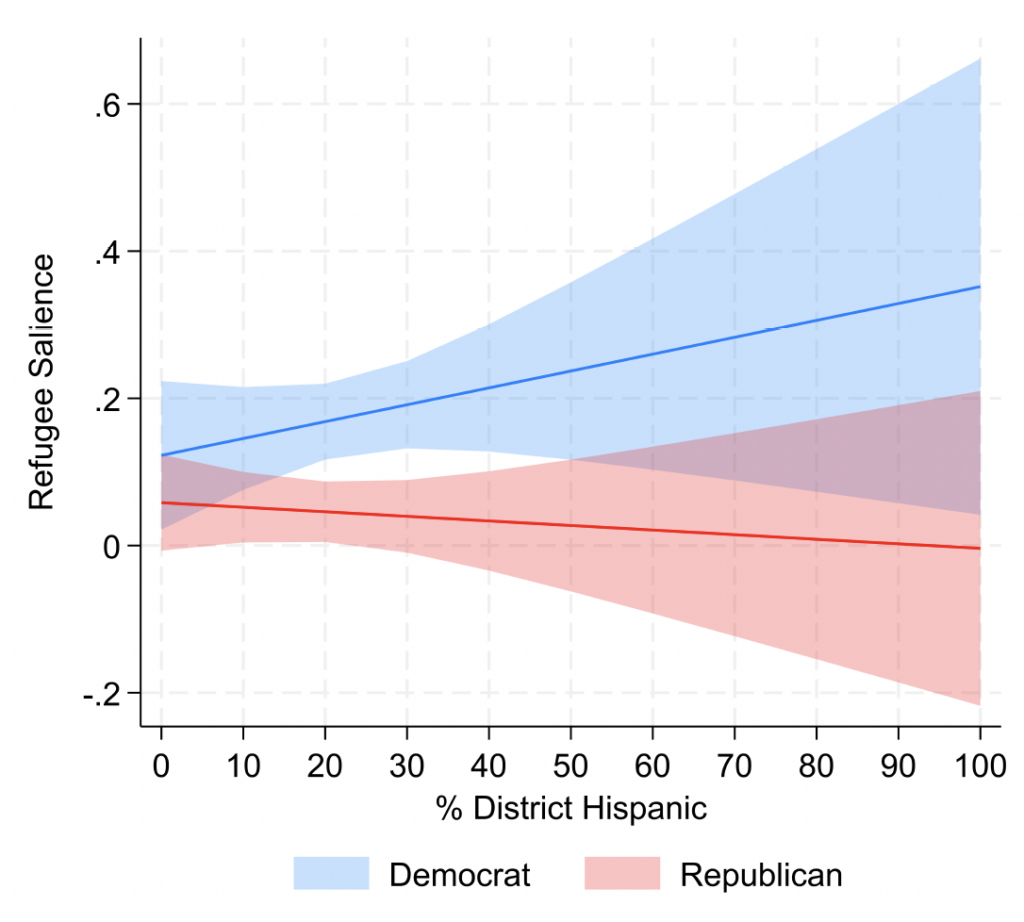
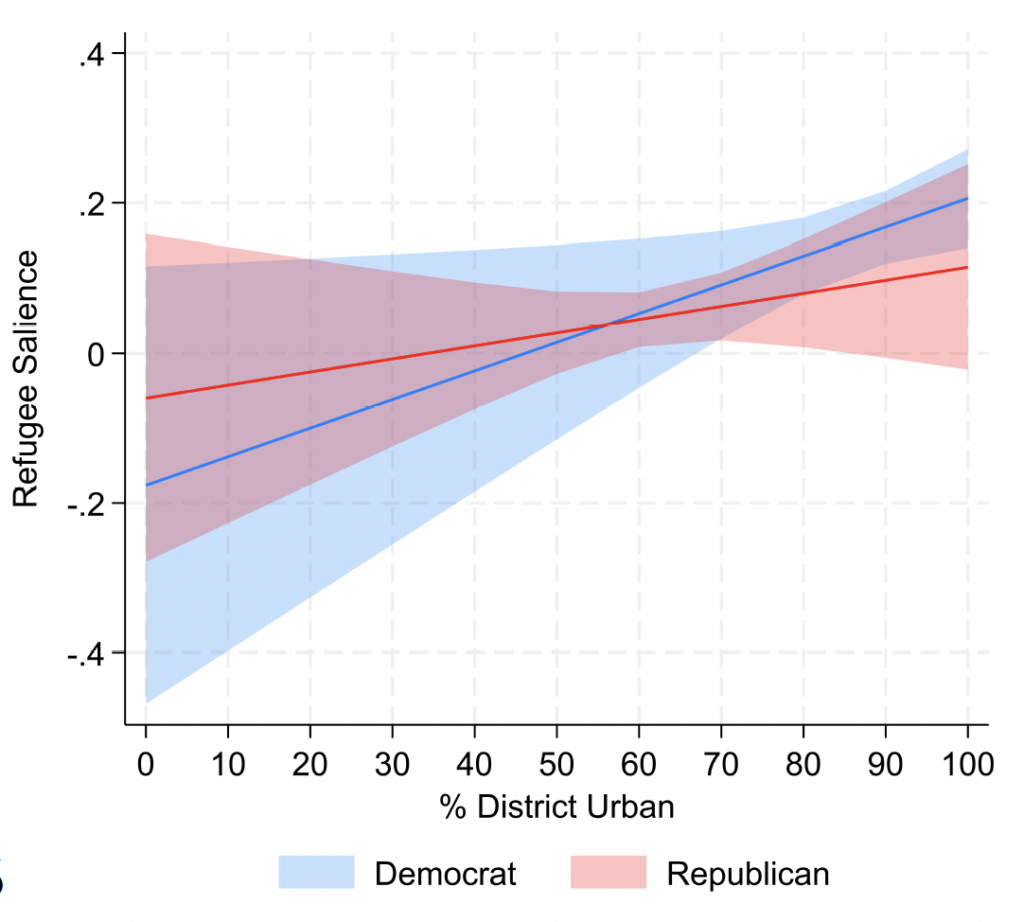
Figure C7. Effect of Party and District Characteristics on Immigrant and Refugee Salience, Controlling for COVID-19 Cases per District (Based on Table C8)
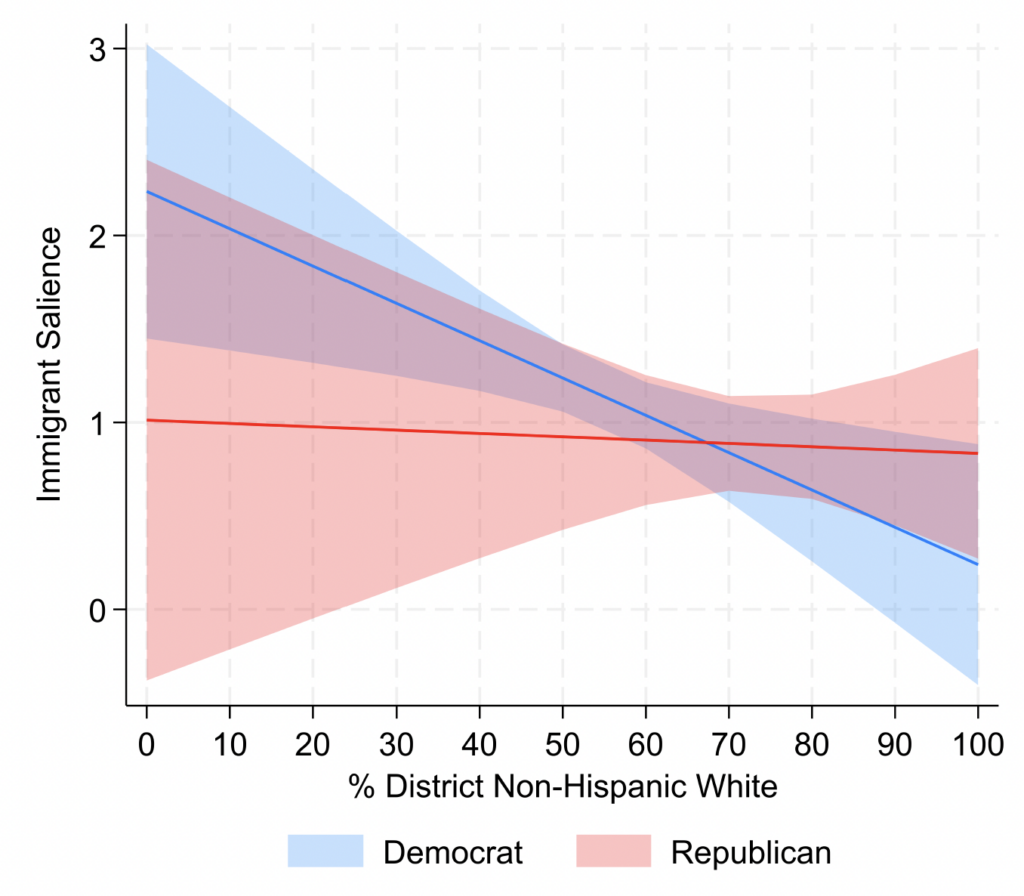
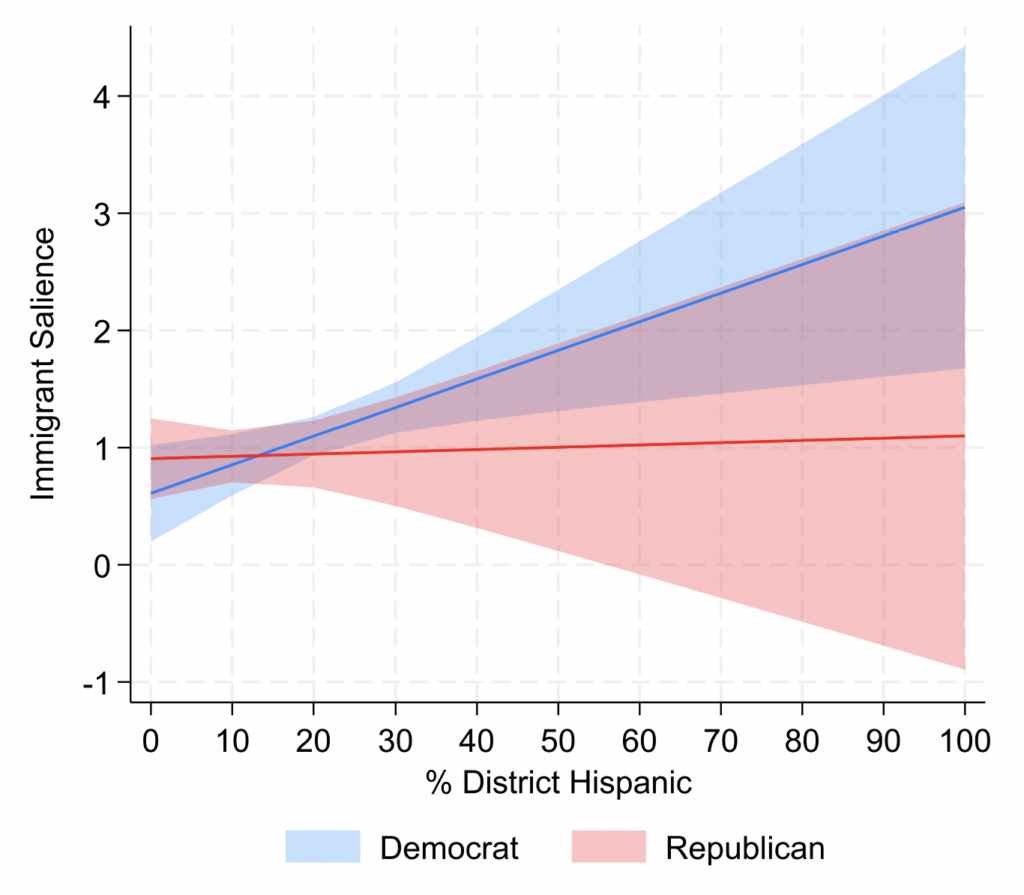
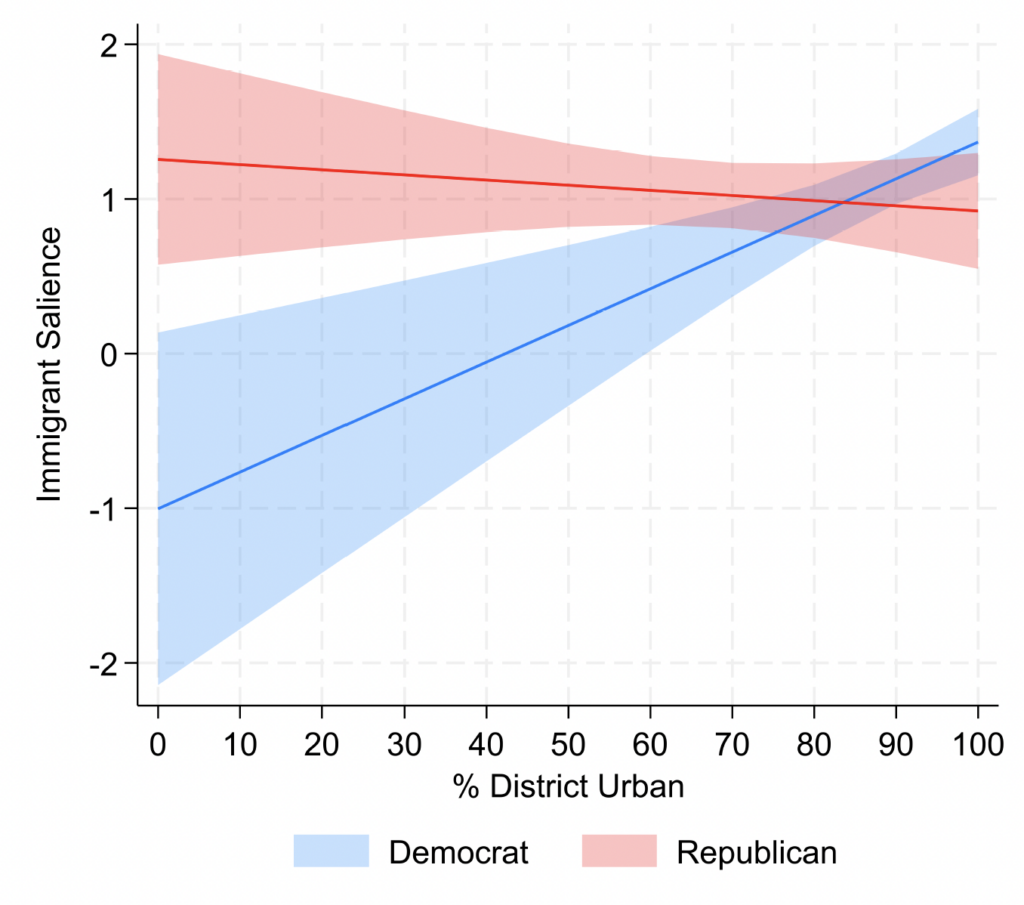
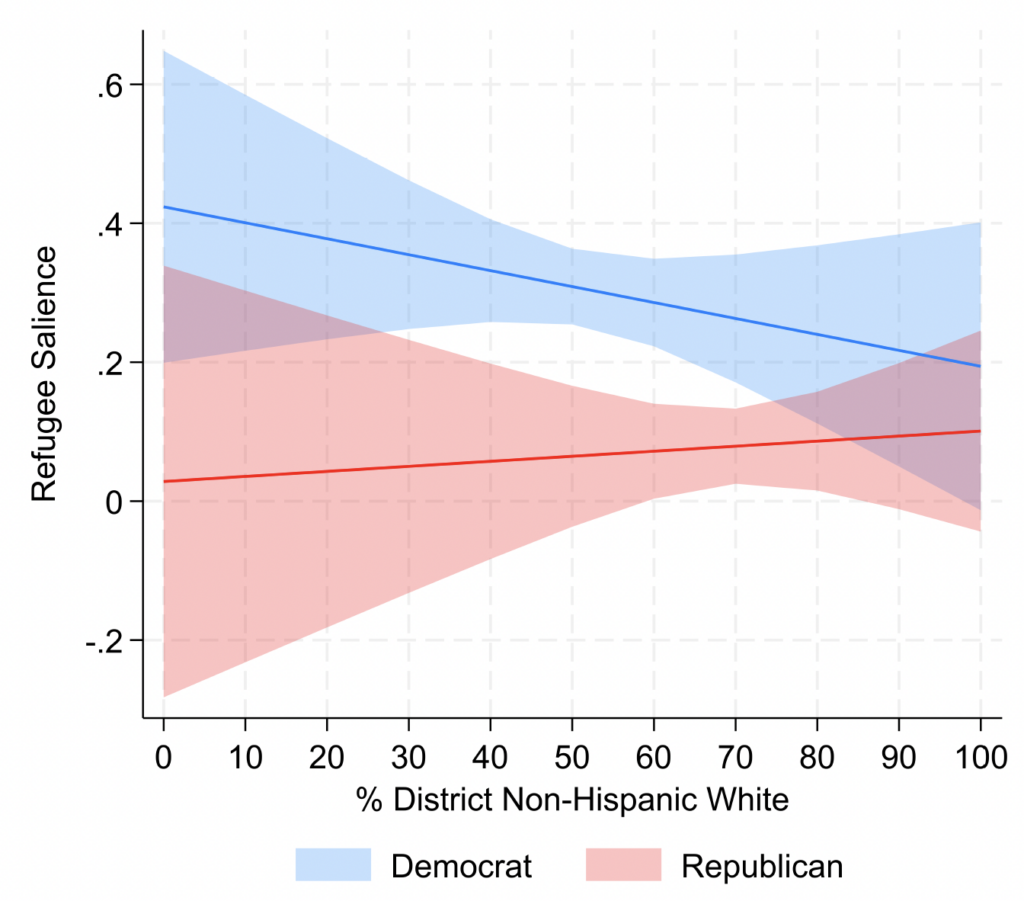
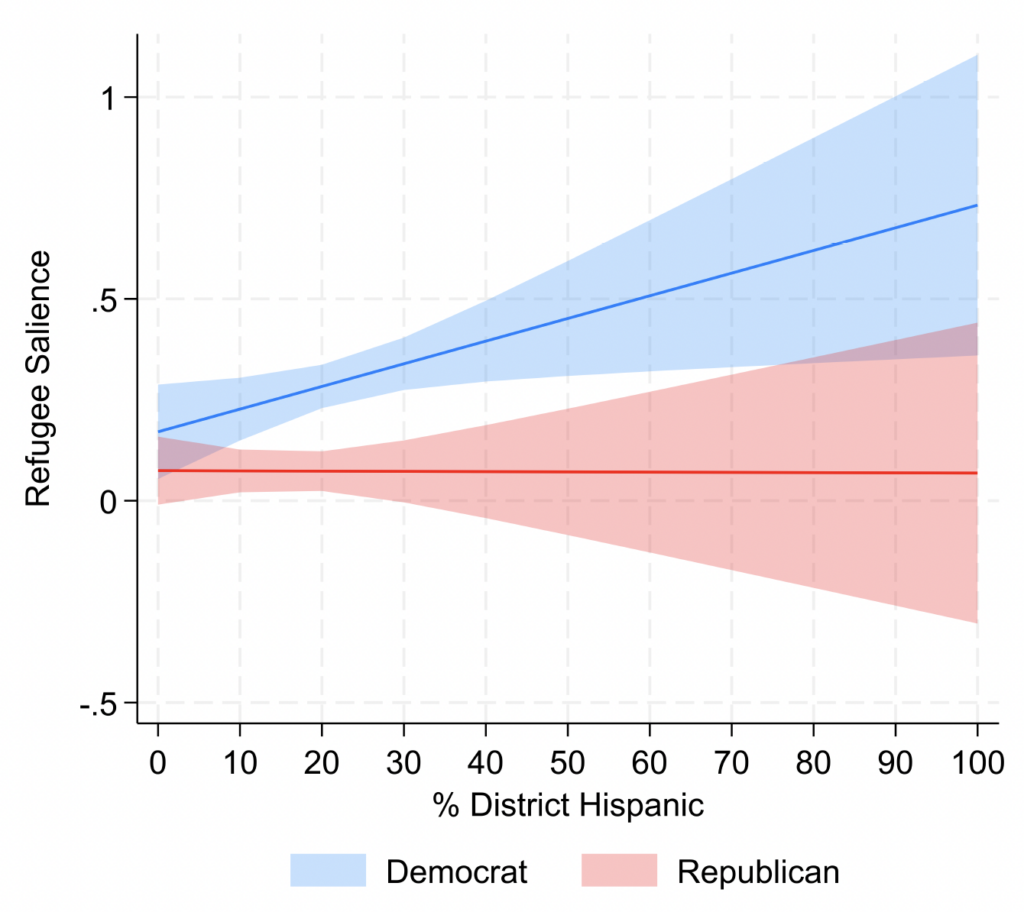
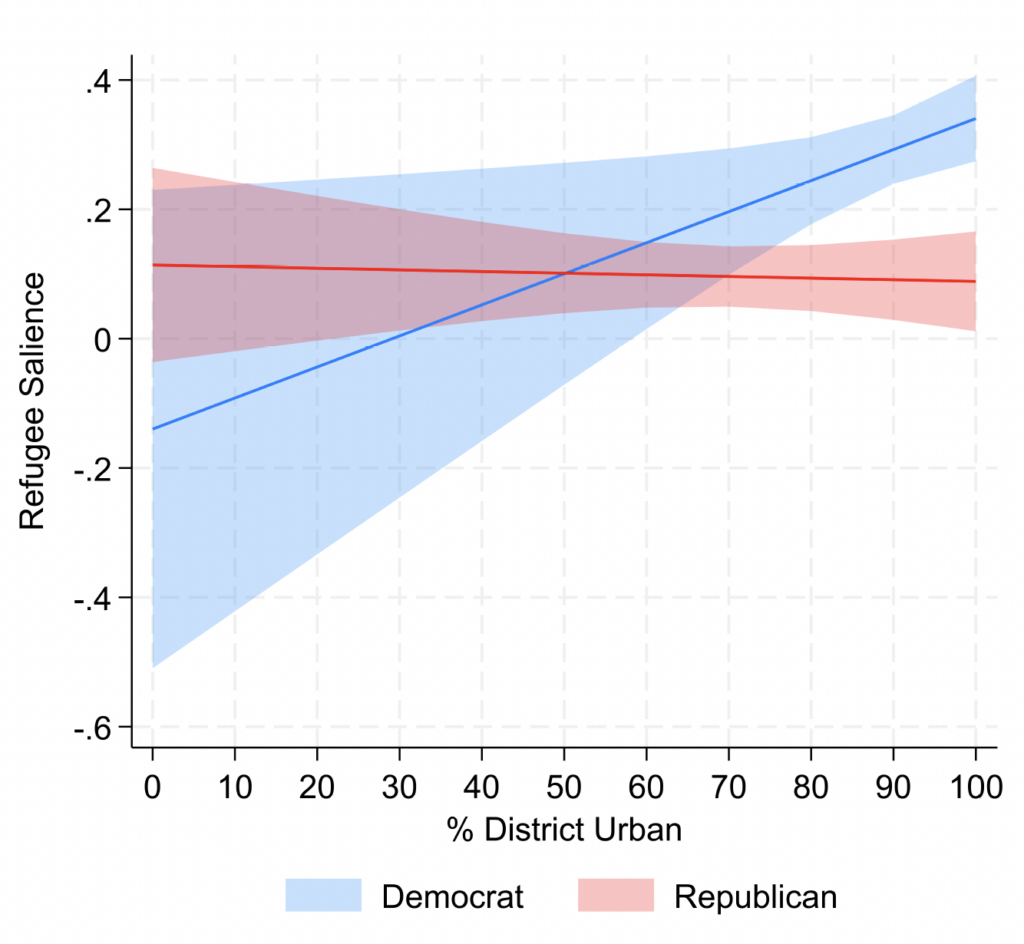
Figure C8. Effect of Party and District Characteristics on Immigrant and Refugee Salience, Controlling for District’s Black Population and Education Level (Based on Table C9)
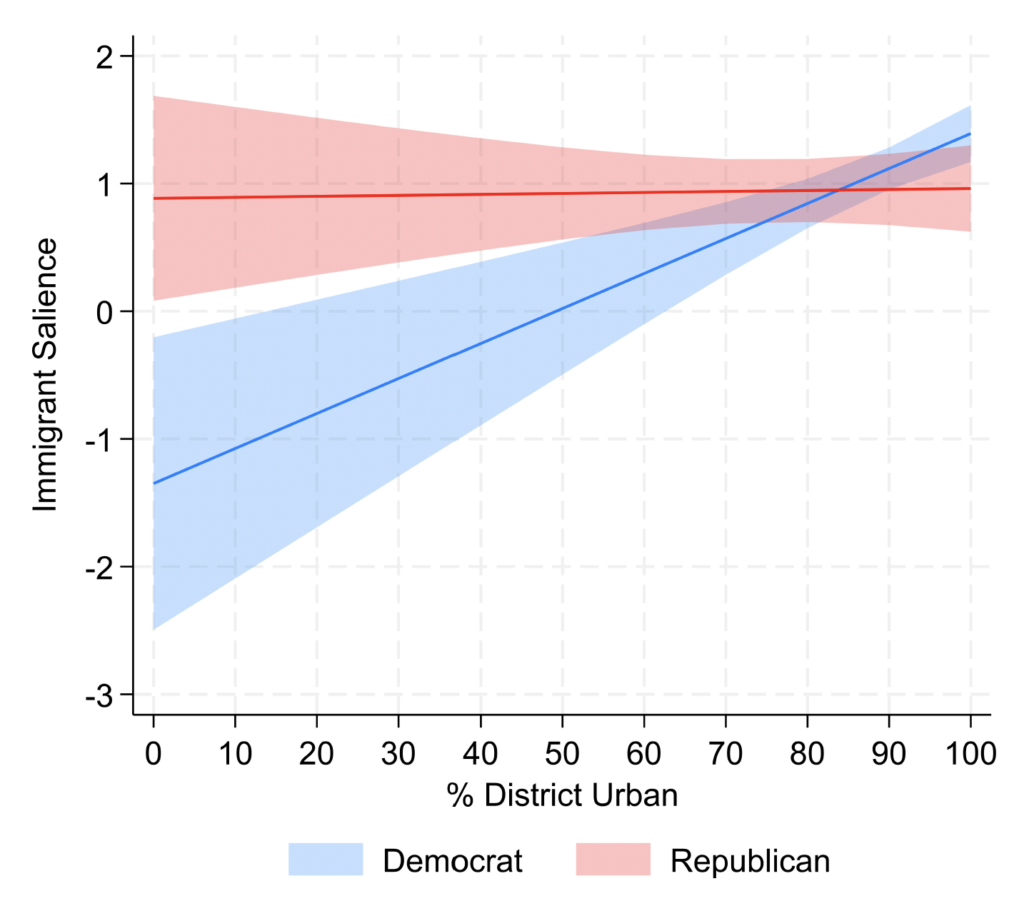
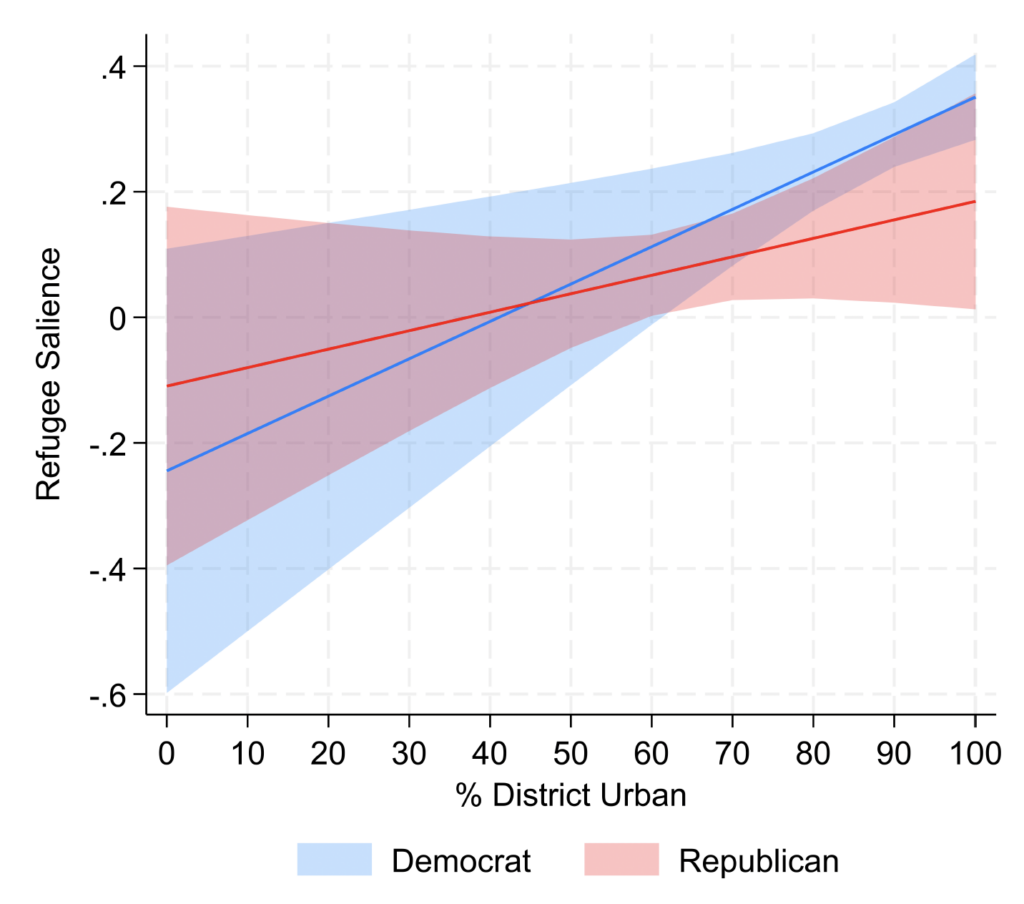
References
Abou-Chadi, Tarik. 2016. “Niche Party Success and Mainstream Party Policy Shifts: How Green and Radical Right Parties Differ in Their Impact.” British Journal of Political Science 46(2): 417–436.
Acree, Brice D. L., Gross Justin H. Smith Noah A. Sim Yanchuan, and Amber E. Boydstun. 2020. “Etch-a-Sketching: Evaluating the Post-Primary Rhetorical Moderation Hypothesis.” American Politics Research 48(1): 99–131.
Ames, Barry. 2002. “Party Discipline in the Chamber of Deputies.” In Legislative Politics in Latin America, ed. Scott Morgenstern. Cambridge: Cambridge University Press, 185– 221.
Andeweg, Rudy B., and Jacques Thomassen. 2011. “Pathways to Party Unity: Sanctions, Loyalty, Homogeneity and Division of Labour in the Dutch Parliament.” Party Politics 17(5): 655–672.
Ansolabehere, Stephen, and Philip Edward Jones. 2010. “Constituents’ Responses to Congressional Roll-Call Voting.” American Journal of Political Science 54(3): 583–597.
Ansolabehere, Stephen, James M. Snyder Jr., and Charles Stewart III. 2001. “The Effects of Party and Preferences on Congressional Roll-Call Voting.” Legislative Studies Quarterly: Forthcoming.
Barberá, Pablo, Andreu Casas, Jonathan Nagler, Patrick J. Egan, Richard Bonneau, John T. Jost, and Joshua A. Tucker. 2019. “Who Leads? Who Follows? Measuring Issue Attention and Agenda Setting by Legislators and the Mass Public Using Social Media Data.” American Political Science Review 113(4): 883–901.
Bélanger, Éric, and Bonnie M. Meguid. 2008. “Issue Salience, Issue Ownership, and Issue- Based Vote Choice.” Electoral Studies 27(3): 477–491.
Bishin, Benjamin G., and Casey A. Klofstad. 2012. “The Political Incorporation of Cuban Americans: Why Won’t Little Havana Turn Blue?” Political Research Quarterly 65(3): 586–599.
Brown, Hana E., and Michelle S. Dromgold-Sermen. 2022. “Borders, Politics, and Bounded Sympathy: How US Television News Constructs Refugees, 1980–2016.” Social Problems: Forthcoming.
Browne, Irene, Beth Reingold, and Anne Kronberg. 2018. “Race Relations, Black Elites, and Immigration Politics: Conflict, Commonalities, and Context.” Social Forces 96(4): 1691– 1720.
Card, Dallas, Serina Chang, Chris Becker, Julia Mendelsohn, Rob Voigt, Leah Boustan, Ran Abramitzky, and Dan Jurafsky. 2022. “Computational Analysis of 140 Years of US Political Speeches Reveals More Positive but Increasingly Polarized Framing of Immigration.” Proceedings of the National Academy of Sciences 119(31).
Ceron, Andrea. 2015. “Brave Rebels Stay Home: Assessing the Effect of Intra-Party Ideological Heterogeneity and Party Whip on Roll-Call Votes.” Party Politics 21(2): 246–258.
Cox, Gary W., and Mathew D. McCubbins. 2007. Legislative Leviathan: Party Government in the House. Cambridge University Press.
de Marchi, Scott, Spencer Dorsey, and Michael J. Ensley. 2021. “Policy and the Structure of Roll Call Voting in the US House.” Journal of Public Policy 41(2): 384–408.
Dennison, James. 2019. “A Review of Public Issue Salience: Concepts, Determinants and Effects on Voting.” Political Studies Review 17(4): 436–446.
Dennison, James, and Hanspeter Kriesi. 2023. “Explaining Europe’s Transformed Electoral Landscape: Structure, Salience, and Agendas.” European Political Science Review: Forthcoming.
deSouza, Priyanka N., and S. V. Subramanian. 2020. “COVID-19 across United States Congressional Districts for Three Cumulative Time Periods.” Journal of Global Health Science 2(2).
Edwards III, George C., William Mitchell, and Reed Welch. 1995. “Explaining Presidential Approval: The Significance of Issue Salience.” American Journal of Political Science 39(1): 108–134.
Epstein, Lee, and Jeffrey A. Segal. 2000. “Measuring Issue Salience.” American Journal of Political Science 44(1): 66–83.
Eshbaugh-Soha, Matthew, and Kenlea Barnes. 2021. “The Immigration Rhetoric of Donald Trump.” Presidential Studies Quarterly 51(4): 781–801.
Facchini, Giovanni, and Max F. Steinhardt. 2011. “What Drives US Immigration Policy? Evidence from Congressional Roll Call Votes.” Journal of Public Economics 95(7-8): 734– 743.
Giger, Nathalie, Stefanie Bailer, Adrian Sutter, and Tomas Turner-Zwinkels. 2021. “Policy or Person? What Voters Want from Their Representatives on Twitter.” Electoral Studies 74: 102401.
Guedes-Neto, João V., and Scott Morgenstern. 2022. “Frustrated Marriage? The Ideological Distance of Members of Congress from their Parties in Latin America.” Annual Conference of the Asociación Latinoamericana de Ciencia Política: Forthcoming.
Hamlin, Rebecca. 2021. Crossing: How We Label and React to People on the Move. Stanford: Stanford University Press.
Hansen, Eric R. 2022. “White Constituents and Congressional Voting.” American Politics Research: Forthcoming.
Hawley, George. 2011. “Political Threat and Immigration: Party Identification, Demographic Context, and Immigration Policy Preference.” Social Science Quarterly 92(2): 404–422.
Holian, David B. 2006. “Trust the Party Line: Issue Ownership and Presidential Approval from Reagan to Clinton.” American Politics Research 34(6): 777–802.
Hu, Minqing, and Bing Liu. 2004. “Mining and Summarizing Customer Reviews.” Paper presented at the Proceedings of the Tenth ACM SIGKDD International Conference on Knowledge Discovery and Data Mining, New York.
Huber, Lena Maria, Anita Bodlos, Elisabeth Graf, and Thomas M. Meyer. 2022. “Disseminating Legislative Debates: How Legislators Communicate the Parliamentary Agenda.” Party Politics 28(2): 365–376.
Hutto, C. J., and Eric Gilbert. 2014. “VADER: A Parsimonious Rule-Based Model for Sentiment Analysis of Social Media Text.” Proceedings of the International AAAI Conference on Web and Social Media 8(1): 216–225.
Jaeger, Jillian. 2019. “Sub-Constituencies and Legislative Responsiveness: Evidence from the States.” Political Research Quarterly 72(2): 473–487.
Jeong, Gyung-Ho, Gary J. Miller, Camilla Schofield, and Itai Sened. 2011. “Cracks in the Opposition: Immigration as a Wedge Issue for the Reagan Coalition.” American Journal of Political Science 55(3): 511–525.
Kalaf-Hughes, Nicole. 2013. “Position-Taking in House Debate and the Issue of Immigration.” Politics, Groups, and Identities 1(4): 488–509.
Kim, Taegyoon, Nitheesha Nakka, Ishita Gopal, Bruce A. Desmarais, Abigail Mancinelli, Jeffrey J. Harden, Hyein Ko, and Frederick J. Boehmke. 2022. “Attention to the COVID- 19 Pandemic on Twitter: Partisan Differences among US State Legislators.” Legislative Studies Quarterly 47(4): 1023–1041.
Löfflmann, Georg. 2022. “‘Enemies of the People’: Donald Trump and the security imaginary of America First.” The British Journal of Politics and International Relations 24(3): 543– 560.
Mainwaring, Scott, Rachel Meneguello, and Timothy Power. 2000. “Conservative Parties, Democracy, and Economic Reform in Contemporary Brazil.” In Conservative Parties, the Right, and Democracy in Latin America, ed. Kevin J. Middlebrook. Baltimore: Johns Hopkins University Press.
Matos, Yalidy. 2017. “Geographies of Exclusion: The Importance of Racial Legacies in Examining State-Level Immigration laws.” American Behavioral Scientist 61(8): 808–831.
Mayda, Anna Maria, Giovanni Peri, and Walter Steingress. 2016. Immigration to the US: A Problem for the Republicans or the Democrats? Working Paper 21941. National Bureau of Economic Research.
Meinke, Scott R. 2022. “How Congressional Leaders Define Loyalty: Validating US House Party Voting Scores with Party Leadership Records.” The Journal of Legislative Studies: Forthcoming.
Mellon, Jonathan. 2014. “Internet Search Data and Issue Salience: The Properties of Google Trends as a Measure of Issue Salience.” Journal of Elections, Public Opinion & Parties 24(1): 45–72.
Merry, Melissa K. 2022. “Trump’s Tweets as Policy Narratives: Constructing the Immigration Issue via Social Media.” Politics & Policy 50(4): 752–772.
Michener, Gregory, and Carlos Pereira. 2016. “A Great Leap forward for Democracy and the Rule of Law? Brazil’s Mensalão Trial.” Journal of Latin American Studies 48(3): 477–507.
Morgenstern, Scott. 2003. Patterns of Legislative Politics: Roll-Call Voting in Latin America and the United States. Cambridge University Press.
Netjes, Catherine E., and Harmen A. Binnema. 2007. “The Salience of the European Integration Issue: Three Data Sources Compared.” Electoral Studies 26(1): 39–49.
Neto, Octavio A., and Fabiano Santos. 2001. “The Executive Connection: Presidentially Defined Factions and Party Discipline in Brazil.” Party Politics 7(2): 213–234.
Nicholson-Crotty, Sean. 2009. “The Politics of Diffusion: Public Policy in the American States.” The Journal of Politics 71(1): 192–205.
Nielsen, Finn Ar. 2011. “A New ANEW: Evaluation of a Word List for Sentiment Analysis in Microblogs.” Proceedings of the ESWC2011 Workshop on “Making Sense of Microposts”: Big Things Come in Small Packages: Forthcoming.
Niemi, Richard G., and Larry M. Bartels. 1985. “New Measures of Issue Salience: An Evaluation.” The Journal of Politics 47(4): 1212–1220.
Onraet, Emma, Alain Van Hiel, Barbara Valcke, and Jasper Van Assche. 2019. “Reactions towards Asylum Seekers in the Netherlands: Associations with Right-Wing Ideological Attitudes, Threat and Perceptions of Asylum Seekers as Legitimate and Economic.” Journal of Refugee Studies 103.
Portes, Alejandro, and Ariel C. Armony. 2018. The Global Edge: Miami in the Twenty-First Century. Berkeley: University of California Press.
Proksch, Sven-Oliver, Will Lowe, Jens W¨ackerle, and Stuart Soroka. 2019. “Multilingual Sentiment Analysis: A New Approach to Measuring Conflict in Legislative Speeches.” Legislative Studies Quarterly 44(1): 97–131.
Ranney, Austin. 1962. The Doctrine of Responsible Party Government: Its Origin and Present State. Champaign: University of Illinois Press.
RePass, David E. 1971. “Issue Salience and Party Choice.” American Political Science Review 65(2): 389–400.
Roberts, Marilyn, Wayne Wanta, and Tzong-Horng Dzwo. 2002. “Agenda Setting and Issue Salience Online.” Communication Research 29(4): 452–465.
Rocca, Michael S., Lisa Sanchez, Jared Clay, and Gabriel Sanchez. 2022. “Re-Examining the Relationship between Latino Population Size and Position Taking on Latino Interests in the US House of Representatives.” Politics, Groups, and Identities: Forthcoming.
Scharkow, Michael, and Jens Vogelgesang. 2011. “Measuring the Public Agenda Using Search Engine Queries.” International Journal of Public Opinion Research 23(1): 104–113.
Sides, John, Michael Tesler, and Lynn Vavreck. 2018. “Hunting Where the Ducks Are: Activating Support for Donald Trump in the 2016 Republican Primary.” Journal of Elections, Public Opinion and Parties 28(2): 135–156.
Spoon, Jae-Jae, Sara B. Hobolt, and Catherine E. de Vries. 2014. “Going Green: Explaining Issue Competition on the Environment.” European Journal of Political Research 53(2): 363–380.
Stokes, Donald E. 1966. “Some Dynamic Elements of Contests for the Presidency.” American Political Science Review 60.
Summers, Ed, Igor Brigadir, Sam Hames, Hugo van Kemenade, Peter Binkley, Tina Figueroa, and Nick Ruest et al. 2022. “DocNow/twarc: v2.10.4.” Zenodo.
Vergeer, Maurice, and Philip Hans Franses. 2016. “Live Audience Responses to Live Televised Election Debates: Time Series Analysis of Issue Salience and Party Salience on Audience Behavior.” Information, communication & society 19(10): 1390–1410.
Zucco, Cesar, and Timothy J. Power. 2024. “It’s My Party and I’ll Lie if I Want To: Elite Ideological Obfuscation in Post-Authoritarian Settings.” Party Politics: Forthcoming.
Zucco Jr., Cesar, and Benjamin E. Lauderdale. 2011. “Distinguishing between Influences on Brazilian Legislative Behavior.” Legislative Studies Quarterly 36(3): 363–396.


